The Mills Family in Staten Island NY
Edward and Mary Ann began their marriage in Staten Island NY where they lived throughout the 1850’s and where each Mills child was born. Here, Edward presumably learned the grocery business from Mary Ann’s brother, Charles Mills Pine (1812 to 08 Oct 1897), who subsequently co-owned E. H. Mills & Co. in Corfu. Edward presumably worked in Pine’s general store, which was located in West New Brighton, also known as Factoryville, a neighborhood in the Staten Island town of Castleton, and was known as Pine, Hillyer & Co. and then C. M. Pine & Son. The Mills are members of the Reformed Dutch Church of Port Richmond, where Charles M. Pine was a longtime member of the Church consistory. This section also explores other Pine and Loper family members in Staten Island at the time as well as associates in the Hillyer, Brown, Egbert and Mersereau families. Finally, the Civil War service of Charles’ son Theodore, and Theodore’s cousins are also explored through surviving letters between Milton Loper and Juliett (Loper) Shepard.
It appears that Edward Mills first met Mary Ann and Charles M. Pine when he moved with his family to Hempstead in the mid-late 1830’s and Edward’s move to Staten Island may have coincided with the establishment of Charles’ grocery business, incorporated there in 1848. When Edward and Mary Ann married in 1850, Edward is said to be “of Factoryville”, the Staten Island neighborhood where Charles M. Pine’s store was located.

At Hempstead, L. I., Dec. 29, by the Rev. N.C. Locke, Mr. Edward H. Mills of Factoryville, S. I., to Miss Mary Ann Pine of the former place.
N.Y. Sun please copy.
— 03 Jan 1851, The Brooklyn Daily Eagle, Brooklyn NY, p2, newspapers.com. View largest available size.
Multiple census records confirm that all the Mills’ children were born in Staten Island, and they were baptized in the Reformed Dutch Church of Port Richmond.
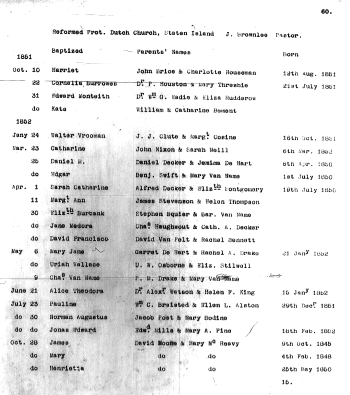
Date Baptized Parents’ Names Born 1852, July 30 Jonas Edward Edwd. Mills & Mary A. Pine 18th Feb. 1852
— Jan 1923, Records of the Reformed Protestant Dutch Church on Staten Island, New York City, transcribed and edited by Royden Woodward Vosburgh, v2, p60, Staten Island, Richmond County, NY Genealogical Resources, FHL Film 514656 Item 5. Partial transcription.View largest available size.
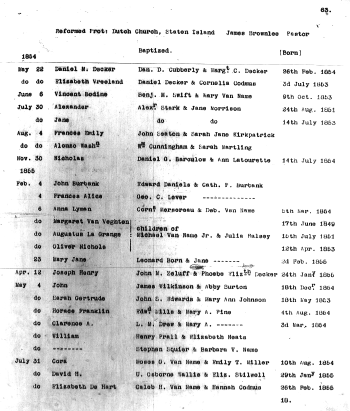
Date Baptized Parents’ Names Born 1855, May 4 Horace Franklin Edwd. Mills & Mary A. Pine 4th Aug. 1854
— Jan 1923, Records of the Reformed Protestant Dutch Church on Staten Island, New York City, transcribed and edited by Royden Woodward Vosburgh, v2, p63, Staten Island, Richmond County, NY Genealogical Resources, FHL Film 514656 Item 5. Partial transcription.View largest available size.
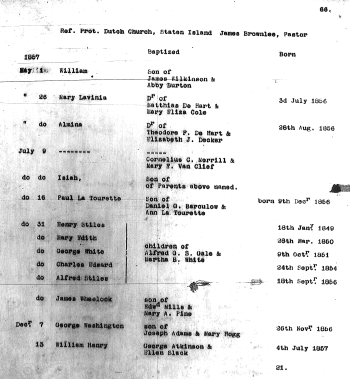
Date Baptized Parents’ Names Born 1857, July 31 James Wheelock son of Edwd Mills & Mary A. Pine
— Jan 1923, Records of the Reformed Protestant Dutch Church on Staten Island, New York City, transcribed and edited by Royden Woodward Vosburgh, v2, p66, Staten Island, Richmond County, NY Genealogical Resources, FHL Film 514656 Item 5. Partial transcription.View largest available size.

Date Baptized Parents’ Names Born 1859, Nov. 30 Mary Emily Edward Mills & Mary A. Pine
— Jan 1923, Records of the Reformed Protestant Dutch Church on Staten Island, New York City, v2, transcribed and edited by Royden Woodward Vosburgh, v2, p70, Staten Island, Richmond County, NY Genealogical Resources, FHL Film 514656 Item 5. Partial transcription.View largest available size.
Every child’s baptism was performed on a Friday except for Emily’s. This may be a subtle clue to narrow Emily’s exact birthdate to early in December, possibly as early as the first, the following day. (Note that 1852 and 1856 are leap years.)
| Child Baptized | Date Recorded | Day of Week | Age |
|---|---|---|---|
| Jonas | 30 Jul 1852 | Friday | 163 days (approx 5 1/2 months) |
| Horace | 04 May 1855 | Friday | 273 days (approx 9 months) |
| James | 31 Jul 1857 | Friday | unknown |
| Emily | 30 Nov 1859 | Wednesday | just under one year |
December 1858
Su Mo Tu We Th Fr Sa
1 2 3 4
5 6 7 8 9 10 11
12 13 14 15 16 17 18
19 20 21 22 23 24 25
26 27 28 29 30 31
December 1859
Su Mo Tu We Th Fr Sa
1 2 3
4 5 6 7 8 9 10
11 12 13 14 15 16 17
18 19 20 21 22 23 24
25 26 27 28 29 30 31
I continue to search for the birth dates for James and Emily, but these may be lost forever.
The "Old Town" collection contains record of births that occurred in the Towns of Northfield, Southfield and Westfield for 1847-1865. The births were recorded in libers (not certificates) and are available on microfilm in room 103. The Municipal Archives does not have records for the rest of Richmond County for the period in question.
I have researched the records available here for the three births and unfortunately found none of them. Despite the law passed in 1847 mandating recordkeeping of vital records in NY State, and subsequent updates to the law, it wasn't until after new legislation in 1919 that the recording of births were enforced. Knowing that, there may not be a NY State birth record.
James Wheelock Mills apparently died as a young child sometime between his 31 July 1857 baptism and the 1860 United States Federal Census in Castleton, Staten Island NY which shows the Mills family otherwise complete except for James, living at the residence of Bartlett Brown (1833 to 24 Nov 1902), another protege of Charles M. Pine in the grocery business, and later, Bartlett succeeded Charles as President of the Richmond County Mutual Insurance Company.
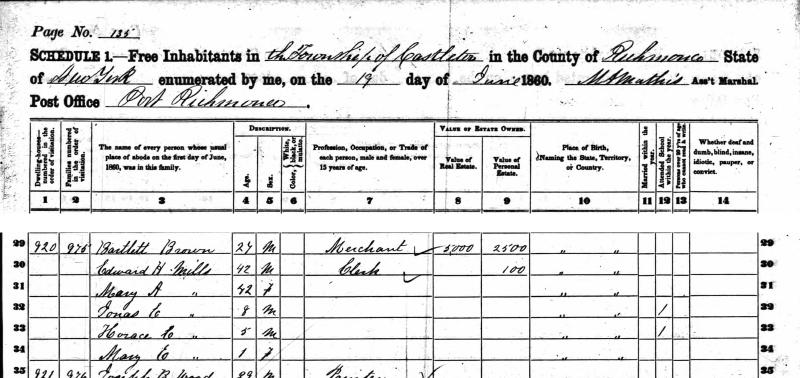
— 19 Jun 1860, United States Federal Census, Castleton NY, p135, ancestry.com. View largest available size.
The 1860 census indicates the town is Castleton. Castleton is the name of one of the original four towns of Staten Island and Factoryville was the colloquial name at the time of one its neighborhoods, West New Brighton.
FACTORYVILLE. West New Brighton. Map of the Village of Factoryville, owned and laid out by N. Barrett. Town of Castleton, S. I. Filed Aug. 20th, 1836. Factoryville or Castleton is given by Dripps, 1850. The steamboat landing at Factoryville was called Castleton Landing. Walling, 1859. Higginson, 1860. Bayles, p. 264.
According to the following tax assessment, Bartlett also lists Factoryville in the “Residence” column.

— 1862-1863, Tax Assessment, Internal Revenue Service, ancestry.com. View largest available size.
Bartlett Brown was born in Oak Farm on Long Island and according to the 1850 census, when Bartlett was 17 years old and still in school, he and his family were living in Huntington, Long Island. He then moved, first to Brooklyn, then onto Castleton in Staten Island NY by 1857 to work at Pine’s general store. My impression is that Bartlett made considerable money in business in Brooklyn, and his time in Pine’s store seems to be a sort of apprenticeship, as after only a few years, he moved on to purchase prime Staten Island real estate and begin his own store, which he successfully ran for several decades.

— 11 Nov 1850, United States Federal Census, Huntington NY, p61, ancestry.com. View largest available size.
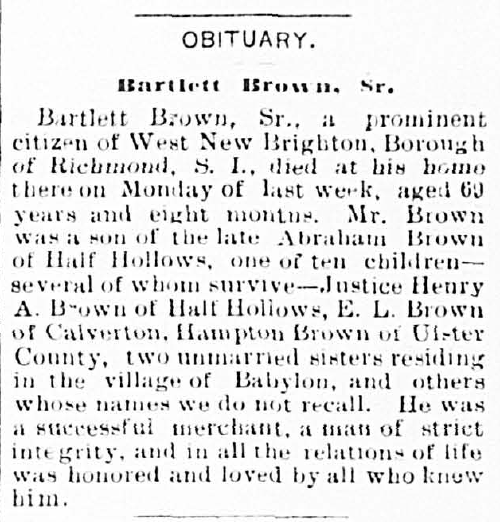
OBITUARY.
Bartlett Brown, Sr.
Bartlett Brown, Sr., a prominent citizen of West New Brighton, Borough of Richmond, S. I., died at his home there on Monday of last week, aged 69 years and eight months. Mr. Brown was a son of the late Abraham Brown of Half Hollows, one of ten children—several of Whom survive—Justice Henry A. Brown of Half Hollows, E. L. Brown of Calverton, Hampton Brown of Ulster County, two unmarried sisters residing in the village of Babylon, and others whose names we do not recall. He was a successful merchant, a man of strict integrity, and in all the relations of life was honored and loved by all who knew him.
— 06 Dec 1902, South Side Signal, Babylon NY, p3, nyshistoricnewspapers.org. View largest available size.
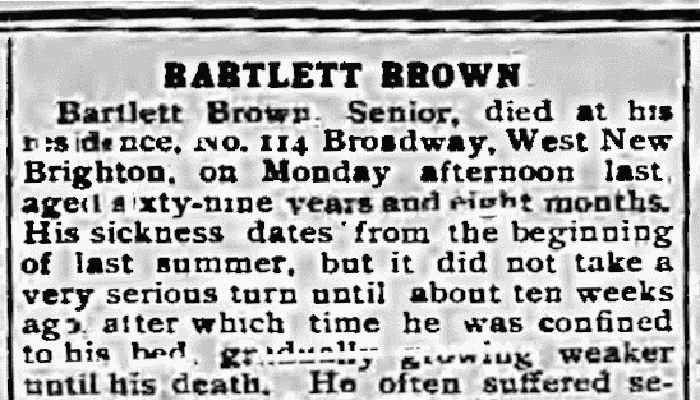
BARTLETT BROWN
Bartlett Brown Senior, died at his residence, No. 114 Broadway, West New Brighton, on Monday afternoon last, aged sixty-nine years and eight months. His sickness dates from the beginning of last summer, but it did not take a very serious turn until about ten weeks ago after which time he was confined to his bed, gradually growing weaker until his death. He often suffered severely, but the close of his life was very peaceful. During all of the very trying period of his sickness, he was cheerful, patient and submissive, and no murmur ever escaped his lips. The Doctors Coonley, who attended, on being called, pronounced the disease incurable, and a post-mortem examination by Dr. Frederick Coonley confirmed the correctness of the opinion.
Mr. Brown was born at Oak Farm, Long Island, and was one of ten children. His parents were among the most intelligent and estimable people of that section, and he was trained to many kinds of usefulness on the farm from a very early age. Indeed, the experiences which then came to him were invaluable, and fitted him in a superior degree for the diligent, manly and honorable life which succeeded.
He began business for himself as a coal and wood merchant in the city of Brooklyn, but later, in the year 1857, he accepted a position in the grocery store of Charles M. Pine at West Brighton, and remained there, highly esteemed by the proprietor and by the many customers, until the year 1859, when he purchased the valuable property at the corner of Broadway and Castleton avenue and began business in the same line for himself. He resided in the adjoining house with his family. He was a man of the very strictest integrity in all of his affairs, and with the merchants of the city with whom he dealt, and with the other people with whom he had financial relations, he was held in the highest regard. In 1892 he retired from active life.
He set a fine example with regard to everything in which he was engaged during the forty-seven years when he made Staten Island his home. Beside the store he had a profitable cranberry business at Calverton, L.I., which he sold to a brother two years ago.
For the two years previous to his death he gave much attention to the affairs of the Richmond County Mutual Insurance Company, of which he was President, and was interested in a reorganization and placing the company in such a condition that it would be more productive. Prior to his election as President he was a director, having taken the place of Mr. Pine on the death of that gentleman a considerable number of years ago. He was always reluctant to hold any office, although frequently solicited and urged to do so.
As a private citizen, he was unexceptionable in all his conduct; he stood for righteousness at the ballot-box, purity in the affairs of the nation and of society, an increase in educational facilities, and a supreme belief in the value and importance of a religious character. He was a friend when a friend was most needed, and many a worthy cause has been benefitted by his generosity, or helped by his judgment and advice. His influence had sometimes been very salutary over the elections in some localities, and he was often of great assistance in the overthrow of evil. He was never afraid to stand boldly up against anything that was wrong and he was a fearless advocate of the truth.
In his religious life Mr. Brown was consistent and faithful. A considerable number of years ago, when Mr. Abraham C. Wood of West Brighton was superintendent of the Sunday-school in Franklin Hall, Mariners Harbor, and was obliged to walk each Sunday to attend to his duty, Mr. Brown tendered his horse and carriage and himself to relieve Mr. Wood of his journeys. As a result, Mr. Brown became a teacher in the school, and for several years did faithful duty in that line; and the girls and boys of the Bible classes which he taught, now grown to manhood and womanhood, speak of the profit they received from his instruction. For a long period he was an earnest member of the Reformed Church of Port Richmond, and every Sunday, without regard to weather, the time was occupied by his family and himself with ardent work for the cause. Personal service and liberal contributions were combined.
Later it was found more convenient to attend Calvary Church, near their home, and the Rev. Mr. Demarest, the pastor of the Reformed Church, gave them a very complimentary letter to the Rev. Dr. Leggett, the pastor with whose charge they desired to unite, where they found further opportunities for usefulness.
Funeral services were held at the house on Wednesday afternoon last, the Rev. Dr. Leggett officiating and speaking words of sympathy and helpfulness as well as of appreciation of the estimable qualities of him whose life had ceased. The funeral was private, except for immediate relatives and the officers and directors of the Richmond County Mutual Insurance Co., most of whom were present. The interment was on Thursday morning in the family plot in the Moravian Cemetery.
Floral designs of choice and beautiful flowers, tributes of regard from friends, covered and surrounded the casket. There was also a sheaf of wheat.
The widow and son and daughter who survive have the warm sympathy of a multitude of friends in their bereavement.
— 29 Nov 1902, Richmond County Advance, West New Brighton NY, p4, newspapers.com. Emphasis added.View largest available size.
Based on the 1860 census, and assuming Bartlett’s obituary is accurate, we can surmise the Mills were residing with Bartlett at “the adjoining house” to “the valuable property at the corner of Broadway and Castleton Avenue”. The Beers map from 1874 shows “B Brown” in the southwest corner of the intersection at Broadway and Castleton, and the “adjoining house” referred to is most likely the structure shown at the corner of State Street and Castleton Avenue, or possibly the one next to it, both of which are labelled as “DWG.” on the 1885 Sanborn map.

— Lionel Pincus and Princess Firyal Map Division, The New York Public Library. “Atlas of Staten Island, Richmond County, New York, from official records and surveys; compiled and drawn by F. W. Beers” The New York Public Library Digital Collections. 1874. https://digitalcollections.nypl.org/items/510d47e2-0b93-a3d9-e040-e00a18064a99. View largest available size.
Closer views:
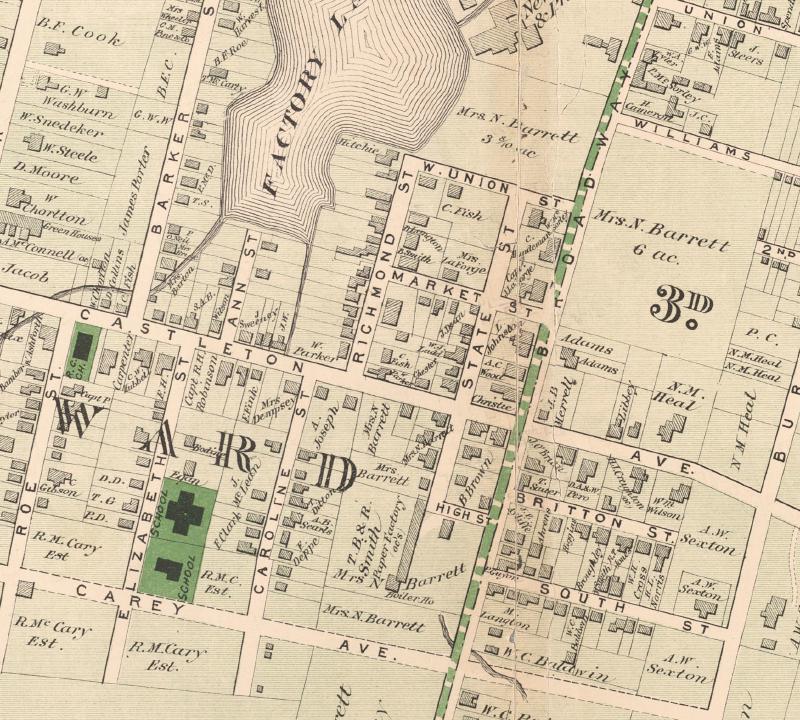
— Lionel Pincus and Princess Firyal Map Division, The New York Public Library. “Atlas of Staten Island, Richmond County, New York, from official records and surveys; compiled and drawn by F. W. Beers” The New York Public Library Digital Collections. 1874. https://digitalcollections.nypl.org/items/510d47e2-0b93-a3d9-e040-e00a18064a99. View largest available size.
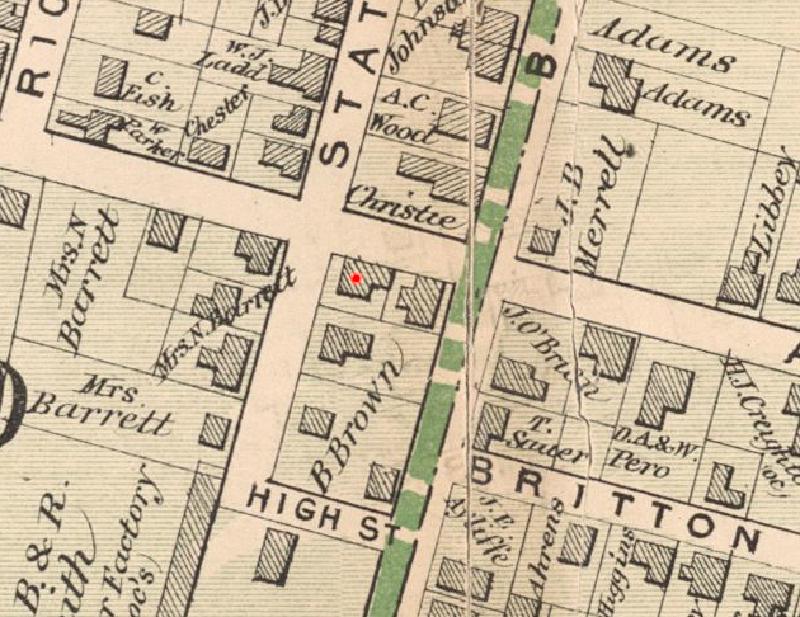
— Lionel Pincus and Princess Firyal Map Division, The New York Public Library. “Atlas of Staten Island, Richmond County, New York, from official records and surveys; compiled and drawn by F. W. Beers” The New York Public Library Digital Collections. 1874. Cropped and highlighted in red. https://digitalcollections.nypl.org/items/510d47e2-0b93-a3d9-e040-e00a18064a99. View largest available size.
The Sanborn map clearly labels Brown’s store as grocery and dry goods, “Gro. & D. G.”, with an accompanying warehouse (“W. Ho.”).
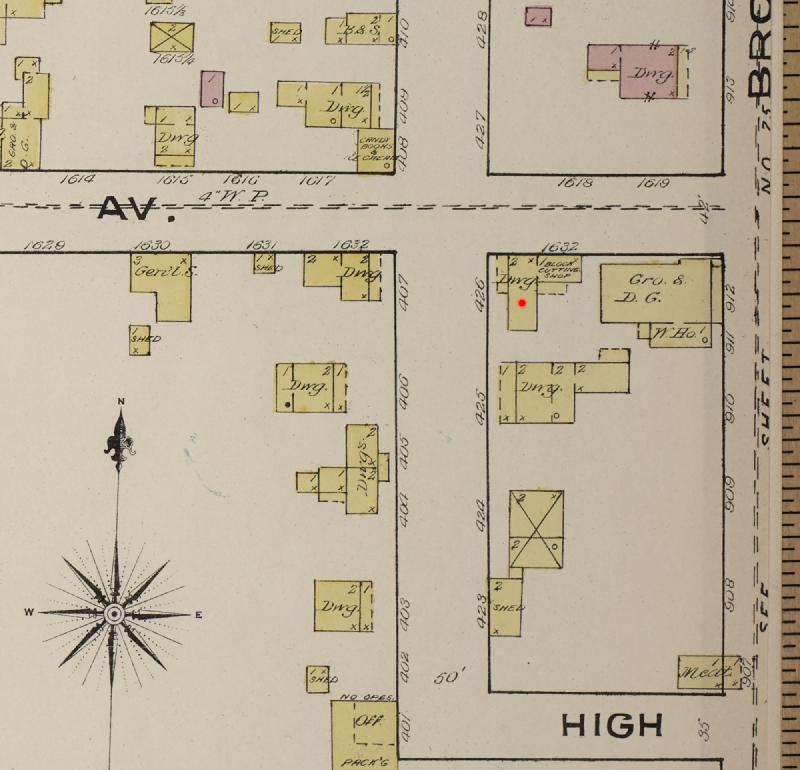
— 1885, Sanborn Fire Insurance Map from Staten Island Borough Of Richmond, Richmond County, New York. Sanborn Map Company, Jul. [Map] Retrieved from the Library of Congress, https://www.loc.gov/item/sanborn06213_001/, p26, cropped and highlighted in red. View largest available size.
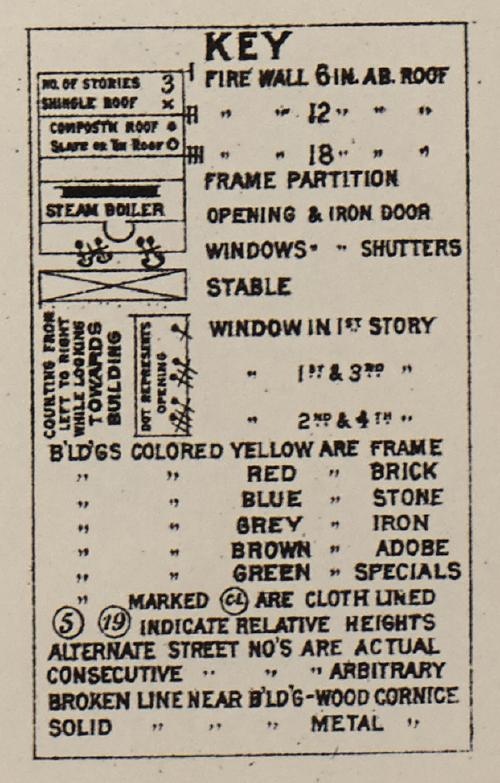
— 1885, Sanborn Fire Insurance Map from Staten Island Borough Of Richmond, Richmond County, New York. Sanborn Map Company, Jul. [Map] Retrieved from the Library of Congress, https://www.loc.gov/item/sanborn06213_001/, p1, cropped. View largest available size.
The representation of the property on some maps does seem to show these two corner structures were “adjoined” in later years.
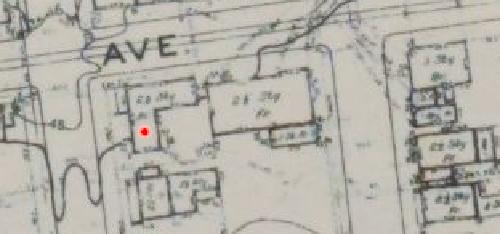
— Lionel Pincus and Princess Firyal Map Division, The New York Public Library. (1906 - 1913). Sheet No. 16. [Includes West New Brighton (West Brighton) and (Port Richmond).] Retrieved from https://digitalcollections.nypl.org/items/510d47e2-629b-a3d9-e040-e00a18064a99 . Cropped and highlighted in red. View largest available size.
The following are Google Maps street view images of Bartlett Brown’s property, captured in 2022.

— Aug 2022, Broadway and Castleton Avenue, Staten Island NY, Google Maps. View largest available size.
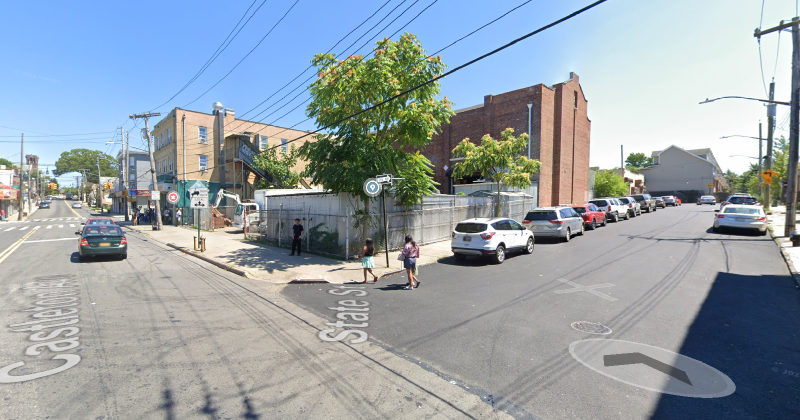
— Aug 2022, Castleton Avenue and State Street, Staten Island NY, Google Maps. View largest available size.
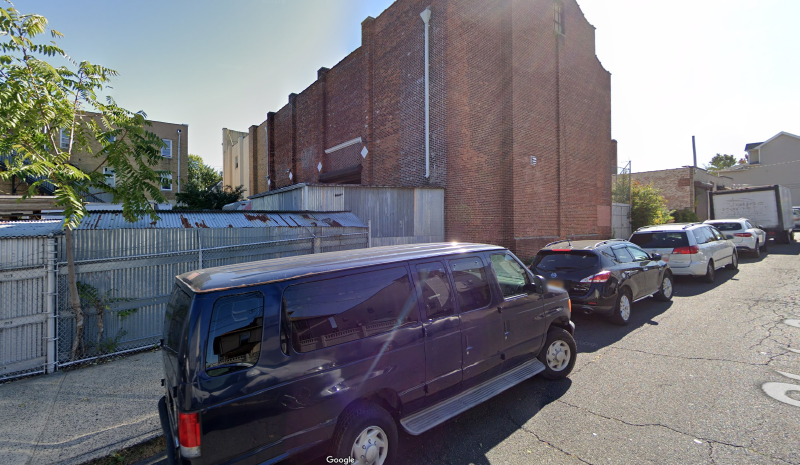
— Aug 2022, Castleton Avenue and State Street, Staten Island NY, Google Maps. View largest available size.
Webb’s Consolidated Directory of Staten Island from 1886 lists Brown’s general store, referencing 114 Broadway, the address mentioned in his obituary, as well as a reference to the home on State Street “near” Castleton Avenue. This description opens the possibility of a different interpretation of which building was the home: as the directory legend below shows, there is an abbreviation for “corner” which would seem to be more appropriate than “near” in this case, and the Beers map indicates Bartlett owned the other lots on that block (although those other lots could have been purchased after the Mills left Staten Island, obviously), so perhaps the home the Mills lived in was the building immediately below the highlighted one, number 424 on the Sanborn map, which is also described as a “DWG”. (Or perhaps Brown moved into that home at a later time?)

Brown Bartlett, gro, 114 B’way, h State n Cas av, W N B
— 1886 Webb’s Consolidated Directory of the North and South Shores Staten Island, p117, ancestry.com. View largest available size.
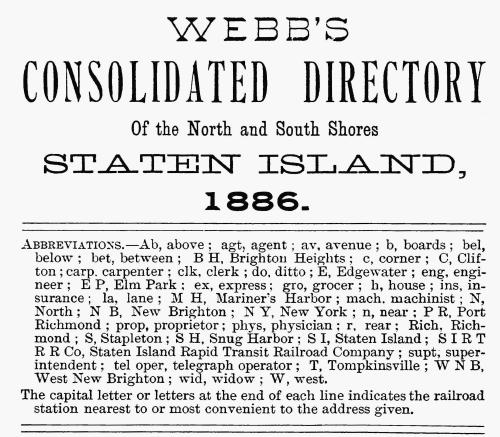
WEBB’S CONSOLIDATED DIRECTORY
Of the North and South Shores
STATEN ISLAND, 1886.
ABBREVIATIONS.—Ab, above; agt, agent ; av, avenue; b, boards; bel, below ; bet, between; BH, Brighton Heights; c, corner; C, Clifton ; carp. carpenter ; clk, clerk ; do, ditto; E, Edgewater ; eng, engineer; EP, Elm Park; ex, express; gro, grocer; h, house ; ins, insurance; la, lane; MH, Mariner’s Harbor ; mach, machinist ; N, North; NB, New Brighton; NY, New York; n, near; PR, Port Richmond ; prop, proprietor; phys, physician; r, rear; Rich, Richmond ; S, Stapleton; SH, Snug Harbor; SI, Staten Island; SIRTRRCo, Staten Island Rapid Transit Railroad Company ; supt; superintendent; tel oper, telegraph operator; T, Tompkinsville ; WNB, West New Brighton ; wid, widow ; W, west.
The capital letter or letters at the pad of each line indicates the railroad station nearest to or most convenient to the address given.
— 1886 Webb’s Consolidated Directory of the North and South Shores Staten Island, p65, ancestry.com. View largest available size.
But if I understand the maps and references correctly, Brown’s main storefront faced Broadway and the front of the home faced the opposite direction onto State Street, where the Sanborn map seems to indicate a porch.
Other maps showing this property include the Colton and Dripps maps which both indicate only three structures on that block:
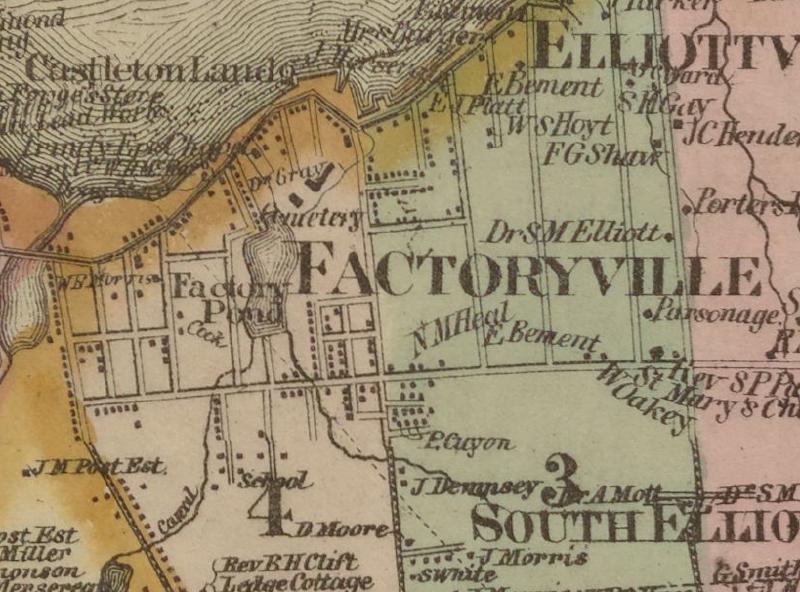
— Lionel Pincus and Princess Firyal Map Division, The New York Public Library. “Map of Staten Island, Richmond County, State of New York” The New York Public Library Digital Collections. 1866. https://digitalcollections.nypl.org/items/00e88990-1d60-0131-f6f3-58d385a7b928. View largest available size.
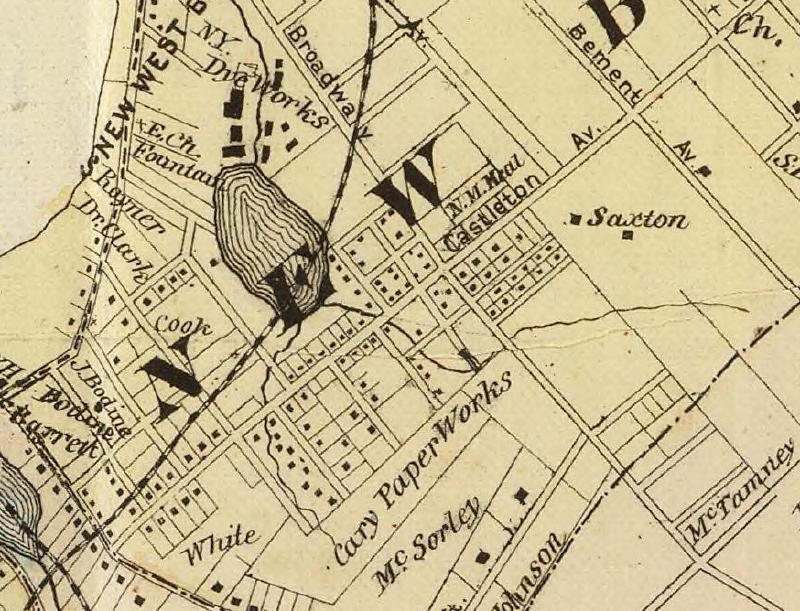
— Map of Staten Island (Richmond Co.) N.Y. Also cities of Bayonne & Perth Amboy, and village of Woodbridge, N.J. Shewing topography, farms, shore soundings &c. Published by M. Dripps, 34 Vesey St., N.Y. Mayer & Merkel, Lith., 24 Church St., N.Y. 1872., David Rumsey Map Collection, davidrumsey.com. View largest available size.
Bartlett Brown’s store at the corner of Castleton Avenue and Broadway in Staten Island was addressed as 114 Broadway in the 1800’s, but as I write this, it is addressed as 280 Broadway, block 206, lot 13 (Borough-Block-Lot Lookup, New York City Department of Finance).
Bartlett Brown’s son Bartlett Brown Jr. (04 Mar 1870 to 15 Dec 1946), apparently known locally as “Bartie”, succeeded him in business:
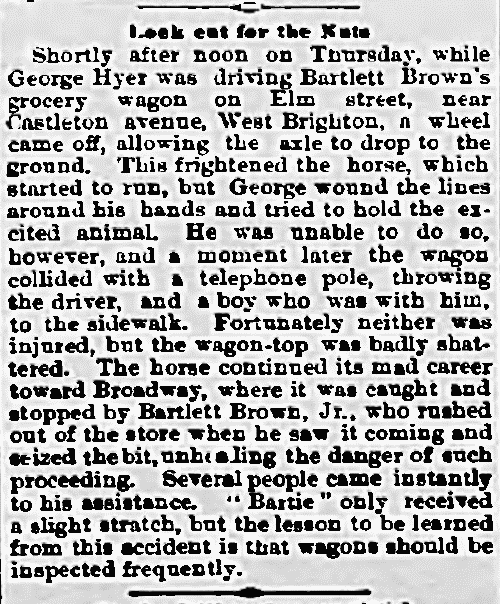
Look out for the Ruts
Shortly after noon on Thursday, while George Hyer was driving Bartlett Brown’s grocery wagon on Elm street, near Castleton avenue, West Brighton, a wheel came off, allowing the axle to drop to the ground, This frightened the horse, which started to run, but George wound the lines around his hands and tried to hold the excited animal. He was unable to do so, however, and a moment later the wagon collided with a telephone pole, throwing the driver, and a boy who was with him, to the sidewalk. Fortunately neither was injured, but the wagon-top was badly shattered. The horse continued its mad career toward Broadway, where it was caught and stopped by Bartlett Brown, Jr., who rushed out of the store when he saw it coming and seized the bit, unheading the danger of such proceeding. Several people came instantly to his assistance. “Bartie” only received a slight scratch, but the lesson to be learned from this accident is that wagons should be inspected frequently.
— 06 Aug 1891, Richmond County Advance, West New Brighton NY, p1, nyshistoricnewspapers.org. View largest available size.

Bartlett Brown, whose recovery from typhoid fever was reported last week, is confined to his bed from a relapse.
— 26 Sep 1891, Richmond County Advance, West New Brighton NY, p4, nyshistoricnewspapers.org. View largest available size.
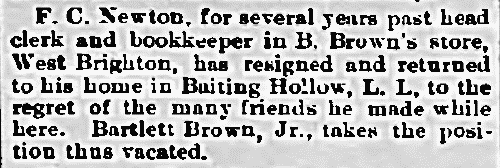
F.C. Newton, for several years past head clerk and bookkeeper in B. Brown’s store, West Brighton, has resigned and returned to his home in Baiting Hollow, L. I., to the regret of the many friends he made while here. Bartlett Brown, Jr., takes the position thus vacated.
— 16 Apr 1892, Richmond County Advance, West New Brighton NY, p4, nyshistoricnewspapers.org. View largest available size.
A partial timeline of events in Staten Island while the Mills lived there:
1850 – Sir Edward Cunard built “Bellevue” on Grymes’ Hill.
Population, 15,961. Sandy Ground’s AME Church incorporated.
1851 – Garabaldi and Meucci opened a brewery in Rosebank which later became Bachmann’s Brewery. Staten Island’s first hospital to admit the general public when the Dr. Samuel Russell Smith Infirmary opens on January 8th. In 1917, the hospital is renamed Staten Island Hospital and eventually becomes Staten Island University Hospital.
1853 – Bechtel’s Brewery founded.
1856 – First meeting of The Staten Island Historical Society – January 21st.
1857 – Wolfe farm purchased for quarantine station.
1858 – Quarantine buildings burned by citizens – September 1- 2nd.
1860 – Staten Island’s first railroad begins operating – April 23rd. The first magnetic telegraph line reaches Staten Island – June.
1863 – Draft riots spread to Staten Island – July 14th.
The quarantine buildings were burned just a few months before Emily was born. The following figures are taken from 1950, Staten Island 1524-1898 by Henry G. Steinmeyer, and show that in the by the time that Edward and Mary Ann left Staten Island in the early 1860’s, the population of the island roughly doubled from when they arrived in the late 1840’s.
| Year | Population |
|---|---|
| 1840 | 10,965 |
| 1850 | 15,961 |
| 1860 | 25,492 |
| 1870 | 33,629 |
| 1880 | 38,950 |
| 1890 | 51,693 |
| 1900 | 67,021 |
The early 1860’s were a time of significant life changes for both Bartlett Brown and the Mills family. Bartlett Brown started a new grocery store, married a few months after the census was taken, and started a family of his own, as documented in the records of the Reformed Dutch Church and the 1865 census. The Mills moved to Corfu sometime between the Summer of 1862 and the Spring of 1863, during a period in which the Battle of Antietam in Sharpsburg MD was fought just a few hundred miles southwest of Castleton, and just before the draft riots on Staten Island.
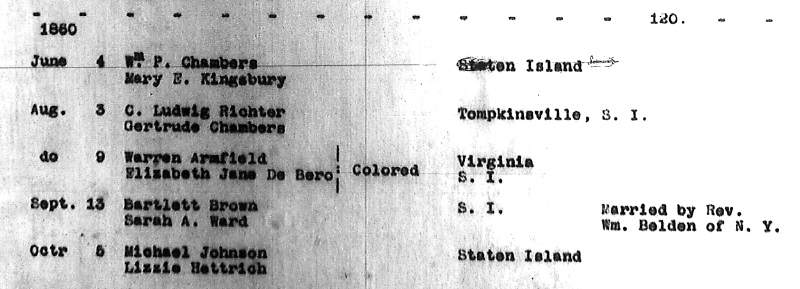
Date Married Place Pastor 1860, Sept. 13 Bartlett Brown, Sara A. Ward S. I. Married by Rev. Wm. Belden of N.Y.
— Jan 1923, Records of the Reformed Protestant Dutch Church on Staten Island, New York City, transcribed and edited by Royden Woodward Vosburgh, v2, p144, Staten Island, Richmond County, NY Genealogical Resources, FHL Film 514656 Item 5. Partial transcription.View largest available size.
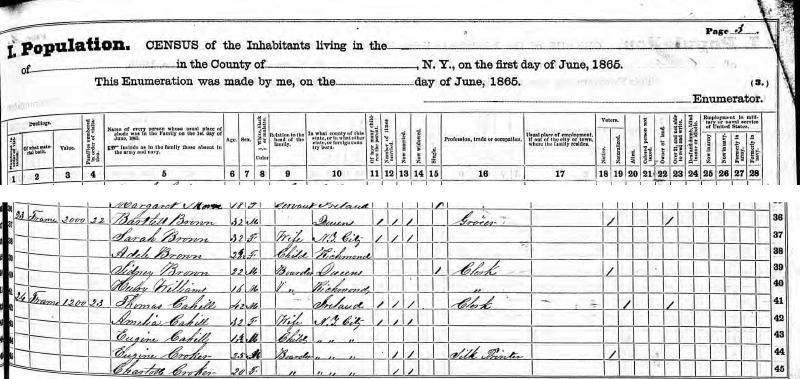
— 1865, New York State Census, p3, ancestry.com. View largest available size.
Bartlett honored his former employer and friend by naming his first son after him: Charles Pine Brown (25 Jan 1866 to 22 Jan 1887) who died of tuberculosis in West New Brighton three days before his 21st birthday. (1887, New York State Death Index, Certificate number 41287, New York Department of Health, Albany, NY, ancestry.com.) Bartlett named his second son after himself.
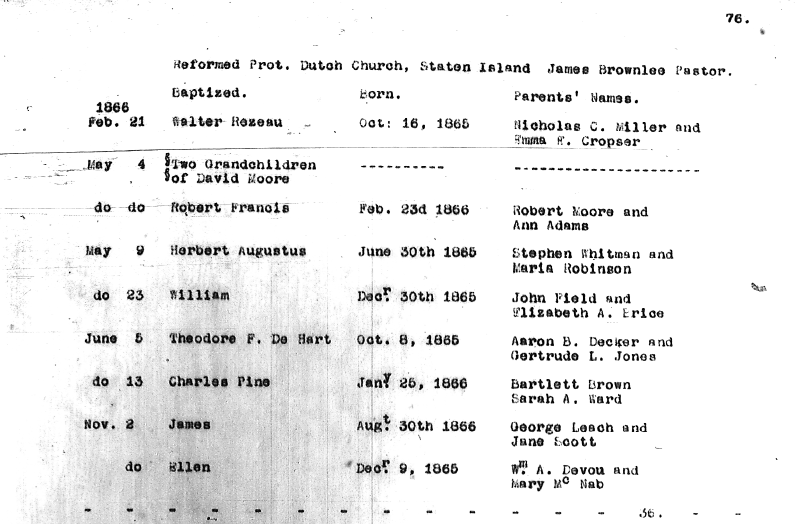
Date Baptized Born Parents’ Names 1866 June 13 Charles Pine Jany. 25, 1866 Bartlett Brown, Sarah A. Ward
— Jan 1923, Records of the Reformed Protestant Dutch Church on Staten Island, New York City, transcribed and edited by Royden Woodward Vosburgh, v2, p76, Staten Island, Richmond County, NY Genealogical Resources, FHL Film 514656 Item 5. Partial transcription.View largest available size.
Edward and Bartlett appeared to work together at Charles Pine’s store, and perhaps Edward worked for Bartlett as Bartlett was first starting his own store. Whatever role, if any, Edward had in Bartlett’s new store, it seems reasonable to assume that seeing his co-worker take this risk, and perhaps seeing the process first-hand, must have only encouraged Edward to take an even bigger risk just a few years later when he also started his own store in Corfu NY.
As described in that section, Charles M. Pine and James A. Hillyer (1831/2 to 20 Mar 1925) were listed as co-owners of E. H. Mills & Co. in Corfu:

Mills, Edward H., (Corfu,) E. H. Mills & Co.) Mills, E. H. & Co. (Corfu,) (Edward H. Mills, Charles M. Pine and James M. Hillyer,) general merchants.
— 1869-70 Gazetteer and Business Directory of Genesee County NY, p199, ancestry.com. View largest available size.
(James M. Hillyer is a presumed misprint of James A. Hillyer.)
Charles M. Pine is Mary Ann Mills’ brother. He married Elmira (sometimes spelled “Almira”) Jane Loper in 1835 in South Hempstead, New York. It was just two years later that Edward likely moved with his father Jonas to Hempstead, also known as South Hempstead.

Vol. V, No. 238 - February 21, 1835.
… In Hempstead, L.I., Mr. Charles Pine, of the firm of Weeks, Seaman & Pine to Almira Jane, daughter of Luther Loper. …
— 1835 Feb 21, Christian Intelligencer of the Reformed Dutch Church, Newspaper Extractions from the Northeast, 1704-1930, ancestry.com. View largest available size.
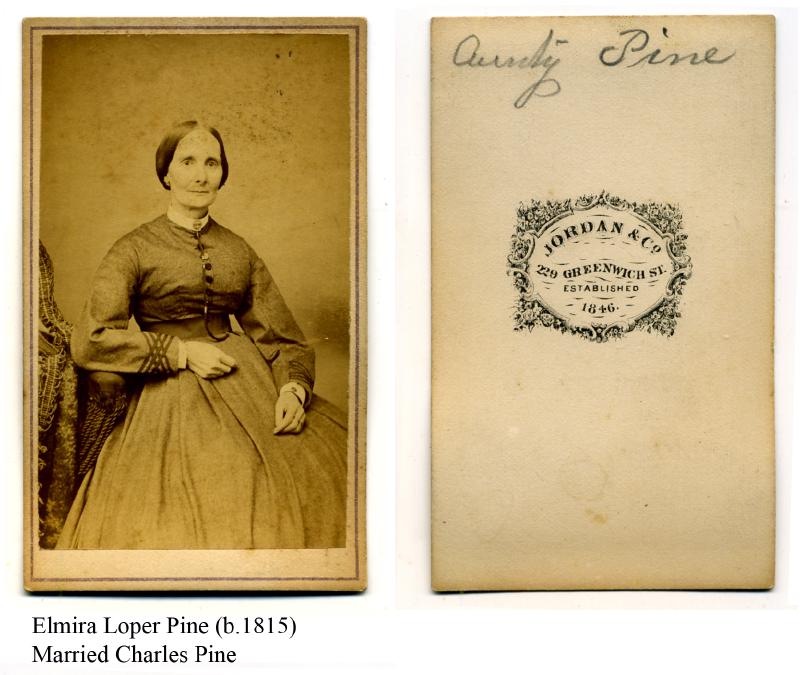
Elmira Loper Pine (b.1815)
Married Charles Pine
— Photograph and corresponding text provided by Martha Deed and used with permission. View largest available size.
Weekes, Seaman & Pine was a general store in Hempstead, possibly with some of the same partners as the previous firm of Weekes, Seaman & Co. in the same village:
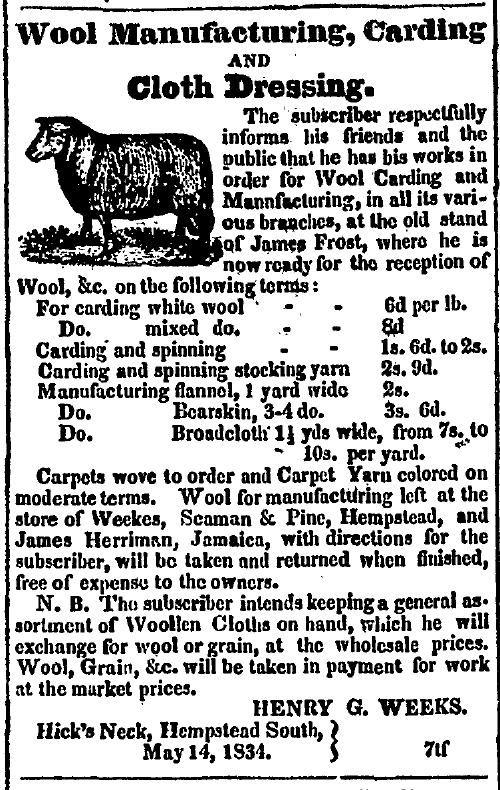
…at the store of Weekes, Seaman & Pine, Hempstead…
— 16 Jul 1834, The Long Island Farmer And Queens County Advertiser, Jamaica NY, p4, nyshistoricnewspapers.org. View largest available size.
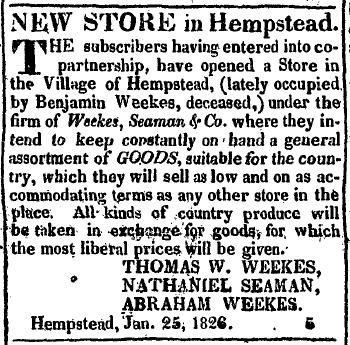
NEW STORE in Hempstead.
The subscribers having entered into copartnership, have opened a Store in the Village of Hempstead, (lately occupied by Benjamin Weekes, deceased,) under the firm of Weekes, Seaman & Co. where they intend to keep constantly on hand a general assortment of GOODS, suitable for the country, which they will sell as low and on as accommodating terms as any other store in the place. All kinds of .country produce will be taken in exchange for goods, for which the most liberal prices will be given.
THOMAS W. WEEKES,
NATHANIEL SEAMAN,
ABRAHAM WEEKES.
Hempstead, Jan. 25, 1826.
— 23 Mar 1826, The Long Island Farmer And Queens County Advertiser, Jamaica NY, p3, nyshistoricnewspapers.org. View largest available size.
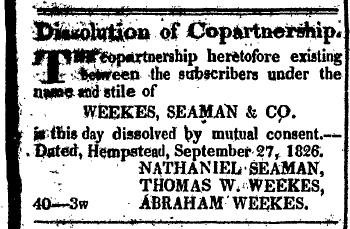
Dissolution of Copartnership.
The copartnership heretofore existing between the subscribers under the name and stile of
WEEKES, SEAMAN & CO.
is this day dissolved by mutual consent.
Dated, Hempstead, September 27, 1826.
NATHANIEL SEAMAN,
THOMAS W. WEEKES,
ABRAHAM WEEKES.
40—3w
— 05 Oct 1826, The Long Island Farmer And Queens County Advertiser, Jamaica NY, p3, nyshistoricnewspapers.org. View largest available size.
Also note that Mary Ann’s and Charles’ mother’s maiden name was Seaman, and she died a few years before the Mills moved to Corfu:
586. Rhoda Seaman, born May 24, 1786 ; married January 30, 1804, Nicholas Pine.
Charles M. Pine was a prominent and prolific business man who was a central figure in the lives of many other successful proteges and business partners that included Edward Mills, Bartlett Brown, James Hillyer, Mark Hartley, and Charles’ own sons, Charles Theodore “Theodore” Pine (1839 to 28 May 1895) and Alverade Richmond Pine (1850 to 21 Aug 1929).

Charles M Pine
— 08 Apr 1856, Last Will and Testament of Luther Loper, ancestry.com. View largest available size.

C. M. Pine
— 08 Apr 1856, Last Will and Testament of Luther Loper, ancestry.com. View largest available size.
Charles M. Pine continued his grocery career in Staten Island starting in 1848, and the Beers map (explored further below) confirms what other histories describe, that there are two stores associated with Charles Pine: C. M. Pine & Co. on Barker Street, east of Factory Lake, as well as his primary place of business, the location next to his residence that was known earlier as Pine, Hillyer & Co. and later as C. M. Pine & Son. Presumably, Edward Mills worked for Charles at least some of the time that he lived in Staten Island, and it seems likely Edward moved to Castleton because of Charles. Edward may have worked at either or both locations.
"Squire John" [Bodine] owned considerable property on the North Shore, among which was the mill, and the pond, and the land east of it, including the old Dongan Manor house, which he subsequently sold to his father, who died in that house in 1835. He also owned the property now occupied by the store of Pine, Hillyer & Co., the residence of Mr. C. M. Pine, and the dwelling west of it, in which he lived at the time of his decease.
Charles’ occupation is “merchant” in Castleton in the 1850 Federal census, and James Hillyer lives with the Pine family, as a clerk, presumably also working in Charles’ store. (h) This might suggest that James is not actually the “Hillyer” being indicated in the store’s name, but one of his relatives who were also known to be in the same line of work. And it is perhaps relevant that roughly coinciding with the establishment of Charles M. Pine’s store James Hillyer’s grandfather John Hillyer as well as Nathaniel Seaman, both died in 1848. However, other clues seem consistent with James being the indicated co-owner, as he seems to be referred to as such when he is said to be “of the firm Pine Hillyer & Co.” (1877, Annals of Staten Island From its Discovery to the Present Time by J.J. Clute, p389-390, quoted elsewhere) and the rough timeline I am aware of seems consistent with the store’s name changing after he left to form Hillyer & Egbert.
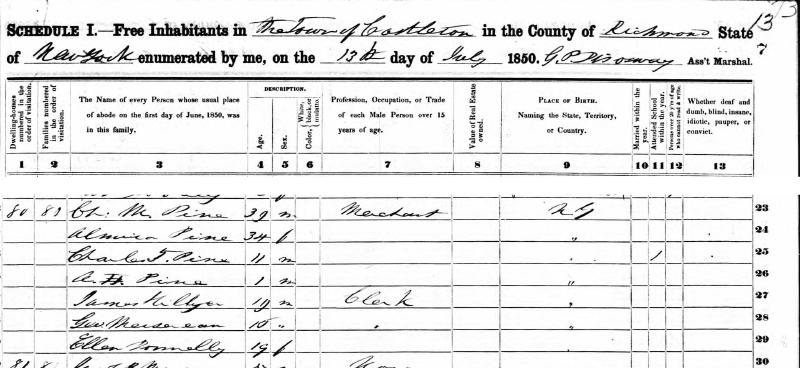
— 13 Jul 1850, United States Federal Census, Castleton NY, p13, ancestry.com. View largest available size.
Both the 1850 and 1860 census show George Mersereau (24 Apr 1835 to 08 Mar 1896) also living with the family of Charles Pine. Charles appears to have taken over the general store in Staten Island from George Mersereau’s father and brother, and George worked as a clerk for Charles for some time. George was a Civil War veteran, and he went on to become successful in business himself; in several places he is credited with rebuilding St. Andrews Church, although his obituary doesn’t explicitly mention this.
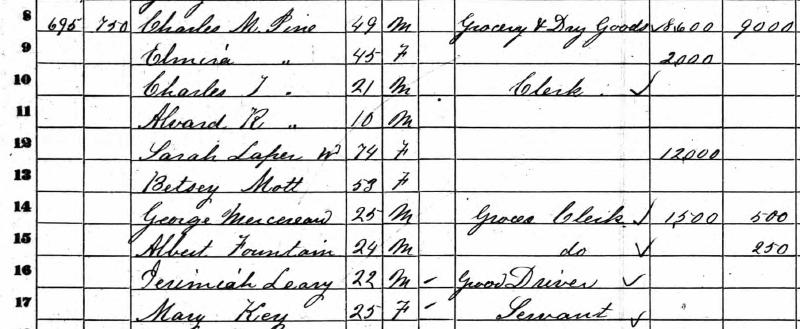
— 15 Jun 1860, United State Federal Census, Castleton NY, p96, ancestry.com. View largest available size.
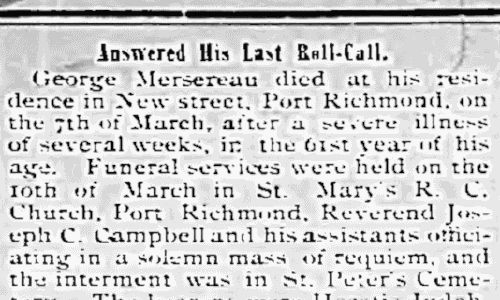
Answered His Last Roll-Call.
George Mersereau died at his residence in New street, Port Richmond, on the 7th of March, after a severe illness of several weeks, in the 61st year of his age. Funeral services were held on the 10th of March in St. Mary’s R. C. Church, Port Richmond. Reverend Joseph C. Campbell and his assistants officiating in a solemn mass of requiem and the interment was in St. Peter’s Cemetery. The bearers were Horatio Judah, Benjamin J. Bodine, Frank McWilliams, William H. Perry, Bernard Mulin, and Thomas McBurney.
An elegant pillow in choice white flowers, with the words “Our Father” upon it, in purple immortelles, and several other handsome floral tributes upon the casket and elsewhere, testified to the regard of friends. The music rendered by the organist and choir was of a superb order. The large church was nearly filled with citizens and their families who came to testify their regard for the memory of a man whom everybody had respected.
Mr. Mersereau came of an ancient French family which left France in consequence of the troubles there in 1685 immediately after the Revocation of the edict of Nantes. They intended to settle in England, but James II, having just ascended the throne, and elements of disturbance being abroad because of his religious views, they continued their way to this country. They had intended to settle in Philadelphia, but were driven to New York by stress of weather. They settled on Staten Island, in the Town of Northfield, where their descendants are found to this day. Judge Paul Mersereau who died in 1856 and who was Member of Assembly from this county in 1834, and for several years subsequently a Judge of the Court of Common Pleas, was the grandfather of Mr. Mersereau. His father, David Mersereau, with his brother Paul, for a considerable number of years kept a grocery store at West Brighton, and were the predecessors of C. M. Pine. Mr. Mersereau served as clerk with Mr. Pine for six years previous to 1860 and afterward carried on the grocery business for three or four years at Tompkinsville. He also spent two years seeking his fortune in California.
On the breaking out of the War of the Rebellion he enlisted in Company I. Capt. O. D. Jewett, 156th Regiment, New York Volunteers, and continued to serve in that connection until discharged from the service at the close of the war. His regiment served in the Department of the Gulf under General Banks and General Canby, and also in the Shenandoah Valley campaign under General Sheridan, and participated in all the occurrences of that remarkable period in our history. The regiment was then sent to garrison Savannah, and remained there and at Athens until the close of the War. It was with General Sherman when Johnston surrendered.
Mr. Mersereau was at the battles of Winchester, Cedar Creek, and Fisher’s Hill in Virginia, and at the capture of Port Hudson, and performed excellent service. He was sometimes detailed for special duty requiring peculiar qualifications, and at all such times manifested superior ability in successfully accomplishing the work entrusted to his care and won the warm encomiums of those who were in command. He attained the rank of Sergeant. A gentleman of intelligence and high character, who was in touch with Mr. Mersereau during the entire war, and who has known him intimately in all the relations of life, said: “He was a good soldier, faithful and true under all circumstances, fulfilling cheerfully and ably every requirement, and in whatever situation he was placed the army, or elsewhere, always acquitted himself in a manner worthy of praise.”
During the last twenty-five years Mr. Mersereau was engaged with his brother in the manufacture of doors, sashes, blinds, and other articles pertaining to the erection of houses, in their manufactory at Port Richmond. The trade grew into a large and prosperous business, because of the diligence shown by the partners, and the esteem in which they were held by all who dealt with them.
Mr. Mersereau had no inclination for public life, but by general desire he served for some years as a trustee of the Village of Port Richmond, in which position he was a most economical and wise administrator of its affairs, and materially contributed toward sustaining the good name which the village authorities then held before the people. In his private life, his conduct was unexceptionable, and he was always intent upon doing something for the blessing of those who were less fortunate than himself. He was exceedingly tender and considerate in his ways, and sought to prevent others from having trouble, even when it was to be taken to make him more comfortable. His last words were evidence of the truth of this statement when he urged his devoted wife “to lie down and take a rest” saying at the same time, “I will turn over and take a nap.” As he thus endeavored to get her to secure the needed rest, on the ground that he did not further require her attention, because he would go to sleep, he turned his face, closed his eyes, and died. It is a beautiful thought that his last act on earth was marked by thoughtfulness of the comfort of another.
Mr. Mersereau was a member of Richmond Post, No. 524, of the Grand Army of the Republic, and the Flag of the Union was displayed at half-mast over the hall at Port Richmond on the occasion of his death. No flag ever gave its folds to the breeze in memory of a braver man, a better citizen, or a more earnest patriot than the man in whose honor it waved.
The deceased left a widow, one son, and a daughter, who have the warm sympathy of the community in which they dwell.
— 23 May 1896, Richmond County Advance, West New Brighton NY, p4, nyshistoricnewspapers.org. Emphasis added.View largest available size.
Anglicans established the Church of St. Andrew at the head of the Fresh Kills in the early 18th century. A graveyard and church were begun by 1709 and the stone church building completed in 1712, adding a major institutional presence to the growing hamlet of Richmond. The church was granted its charter by Queen Anne in 1713.
In 1770 the original church building was enlarged and a tall, elegant steeple was added. The steeple followed a design published by the English architect James Gibbs. With its location on a hill adding to the effect of the tall steeple, the church became an important monument that was visible from miles away.
During the American Revolution, the church was a center of military activity. Rev. Richard Charlton, who was a rector of St. Andrew’s at the start of the Revolution (until 1777), is remembered as the grandfather of Saint Elizabeth Ann Bayley Seton, who was the first native-born U.S. citizen to be canonized by the Roman Catholic Church; Charlton and Seton family members are among the distinguished early citizens whose graves can be found in the church’s cemetery.
The early church building was severely damaged by fire on March 29, 1867 and again in October 1872. During the periods of rebuilding, services were held in the nearby Reformed Dutch Church.
Today, the Episcopal Church of St. Andrew is an active faith community. The current structure, attributed to builder George Mersereau in 1872, is noted for the English influences in its design. It was designated a New York City landmark in 1967 and was added to the National Register of Historic Places in 2000. The adjoining Burch Hall was built in 1924.
Note that there are also Mersereaus living in Hempstead at the same time as the Pines and Mills.
The Mersereau families were well known, five brothers were spies for George Washington.
In 1865, Mark Hartley is also living with Charles M. Pine, occupation “clerk”, presumably in Pine’s general store. Later, Mark Hartley co-owned the general store Hillyer & Hartley, along with James Hillyer’s brother Abraham Hillyer. Later still, Mark Hartley became Charles M. Pine’s assignee when Charles’ store failed.
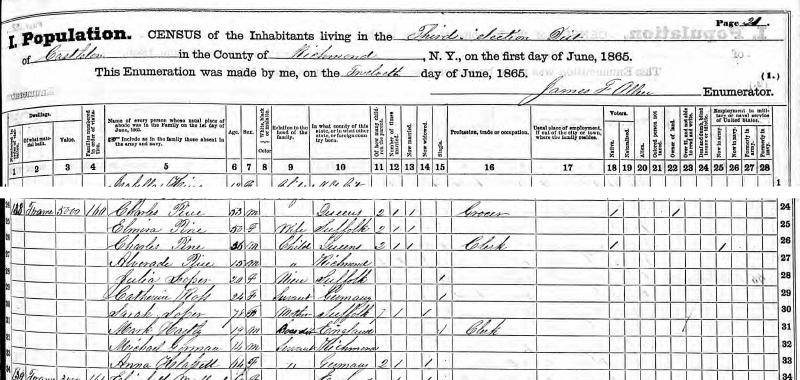
— 12 Jun 1865, New York State Census, Castleton NY, p21, ancestry.com. View largest available size.
By 1859, Charles’ general store is known as Pine, Hillyer & Co., presumably co-owned with James Hillyer. The 1874 Beers map shows “General Store of Pine, Hillyer & Co.”, in an area described below as “the bend between Van Street and Broadway” at 188 Richmond Terrace (also called “Shore Road”, at least to the west of Pine’s store). Comparing a number of historical maps of Castleton to present day maps, it is striking how the major road names and their courses have remained consistent over these many years, as exemplified by the bends in this stretch of Richmond Terrace.
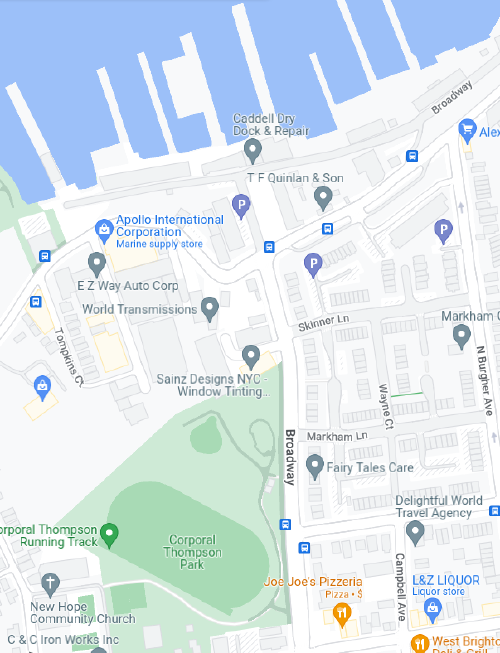
— 20 Jan 2023, screenshot of West New Brighton streets, Google Maps. View largest available size.
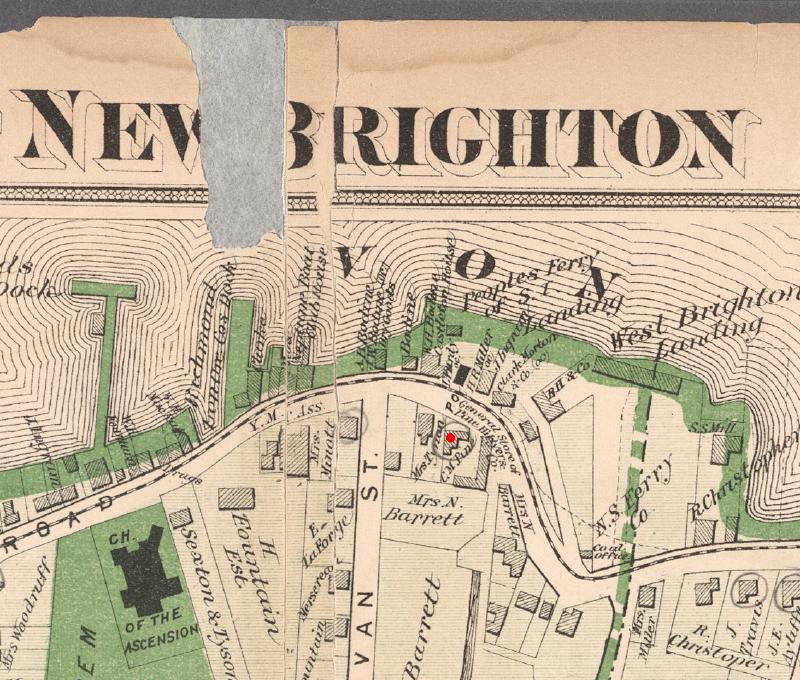
General Store of Pine, Hillyer & Co.
C. M. Pine
— Lionel Pincus and Princess Firyal Map Division, The New York Public Library. “Atlas of Staten Island, Richmond County, New York, from official records and surveys; compiled and drawn by F. W. Beers” The New York Public Library Digital Collections. 1874. Cropped and highlighted in red. https://digitalcollections.nypl.org/items/510d47e2-0b93-a3d9-e040-e00a18064a99. View largest available size.
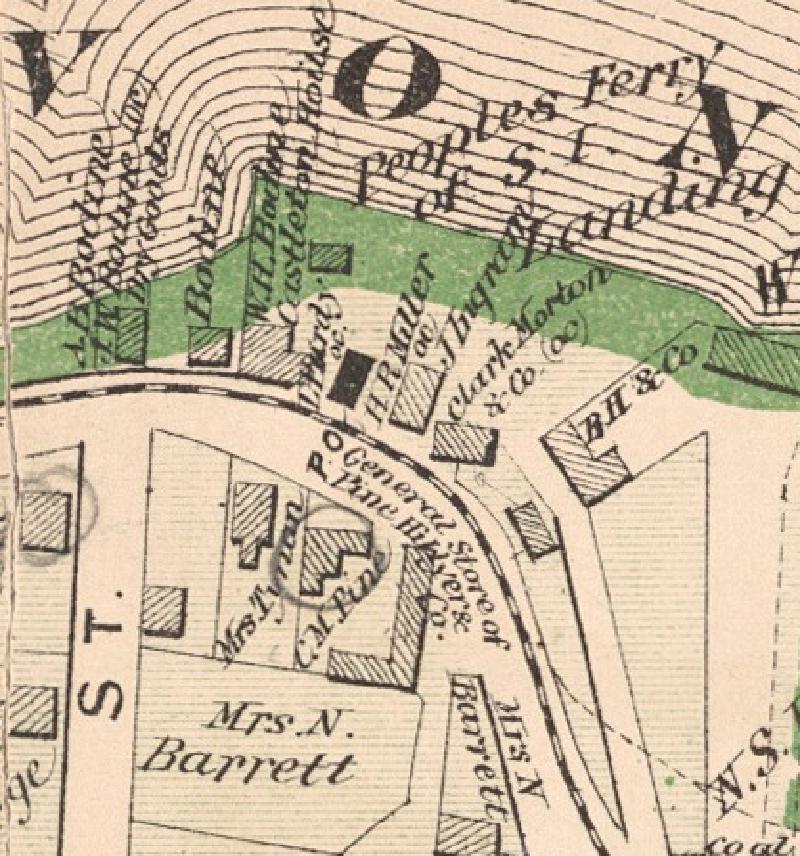
General Store of Pine Hillyer & Co.
C. M. Pine
— Lionel Pincus and Princess Firyal Map Division, The New York Public Library. “Atlas of Staten Island, Richmond County, New York, from official records and surveys; compiled and drawn by F. W. Beers” The New York Public Library Digital Collections. 1874. Cropped. https://digitalcollections.nypl.org/items/510d47e2-0b93-a3d9-e040-e00a18064a99. View largest available size.
The 1885 Sanborn Fire Insurance Map shows the structures in more detail, including important aspects of what the buildings were made of and some other characteristics of their appearance. Note the hydrant on the corner of Pine’s store.
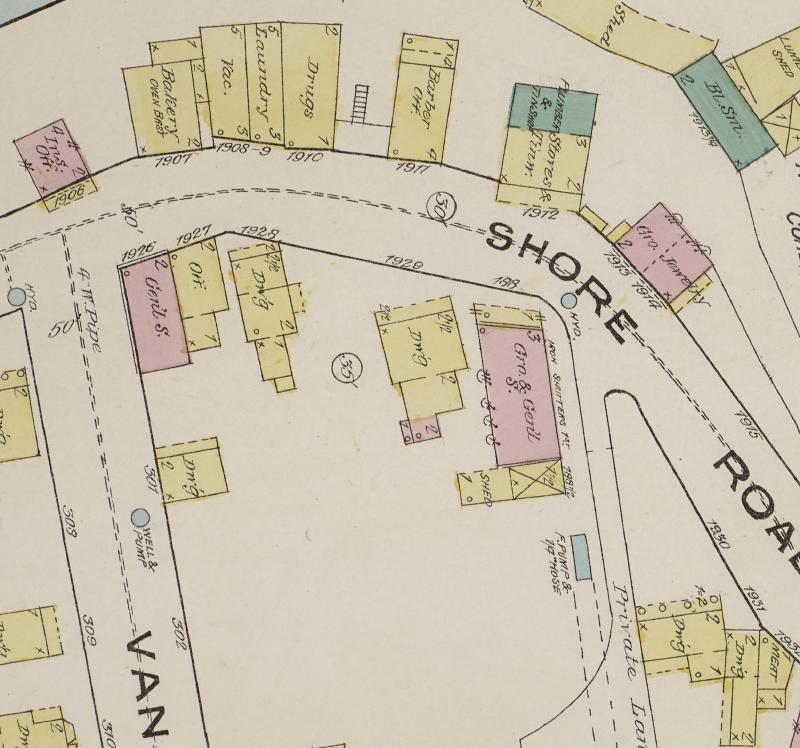
— 1885, Sanborn Fire Insurance Map from Staten Island Borough Of Richmond, Richmond County, New York. Sanborn Map Company, Jul. [Map] Retrieved from the Library of Congress, https://www.loc.gov/item/sanborn06213_001/, p20, cropped. View largest available size.

— 1885, Sanborn Fire Insurance Map from Staten Island Borough Of Richmond, Richmond County, New York. Sanborn Map Company, Jul. [Map] Retrieved from the Library of Congress, https://www.loc.gov/item/sanborn06213_001/, p1, cropped. View largest available size.
The structural notations in the Sanborn map confirms what can be seen in the following photo of the Pine residence, which also shows the side of Pine’s “Gro. & Gen’l S.”. The residence is a 2 1/2 story frame building with a shingled roof, and the store next to it is a 3 story brick structure, with windows on the alley wall on all three floors toward the front, with three more windows on the ground floor behind those. Also visible is the wood cornice on the storefront that is indicated in the Sanborn map, as well as the side of the shed in the rear of the store next to the stables.
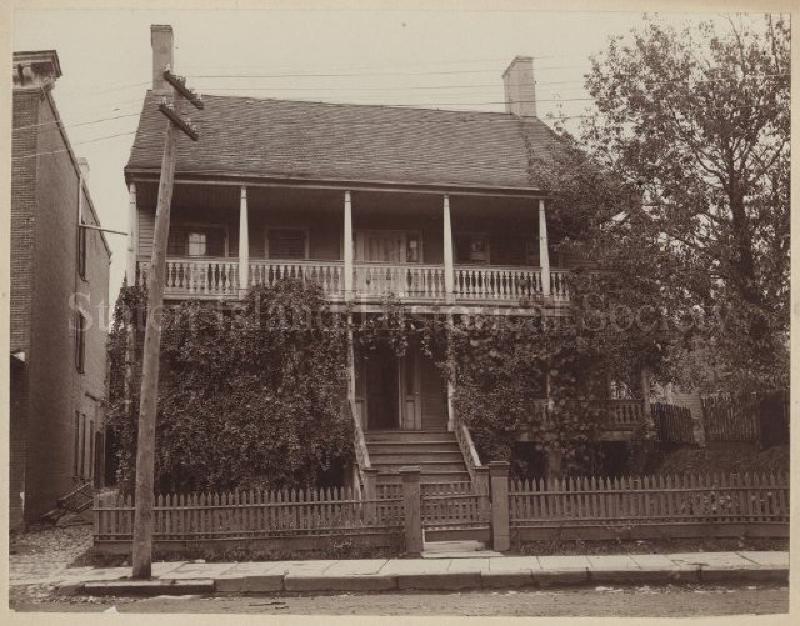
— ca. 1895, Pine Residence, Charles M. Steinrock, Catalog Number PH01.1599, Staten Island Historical Society, Historic Richmond Town, historicrichmondtown.org. View largest available size.
Although I don’t have documentary evidence for this currently, I think it is reasonably likely that the Mills family lived at the Pine residence at some point, as other employees, proteges, and extended family lived with Charles Pine over the years.
The following are Google Maps street view images from Richmond Terrace captured in 2022 that show the buildings in the footprint of Pine’s store and residence. “Apollo Intl.” is in the area of Pine’s residence, but the brick building to the left appears to be Pine’s store intact, a fact confirmed further below.
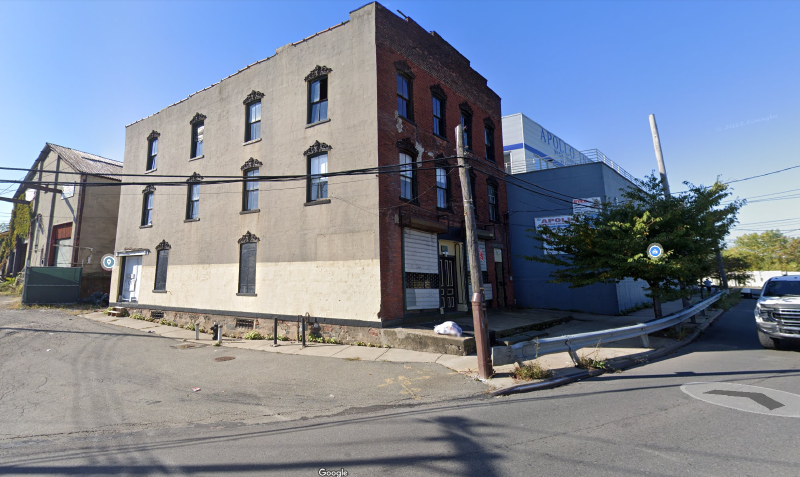
— Oct 2022, Richmond Terrace and Barrett Lane, Staten Island NY, Google Maps. View largest available size.
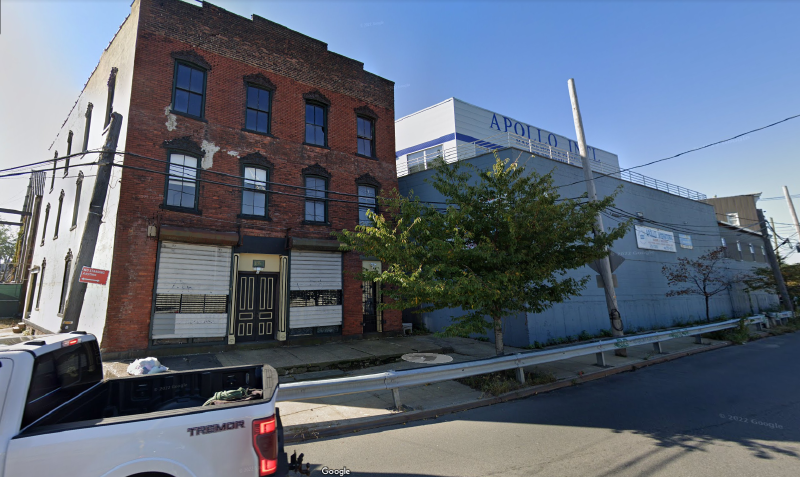
— Oct 2022, Richmond Terrace and Barrett Lane, Staten Island NY, Google Maps. View largest available size.
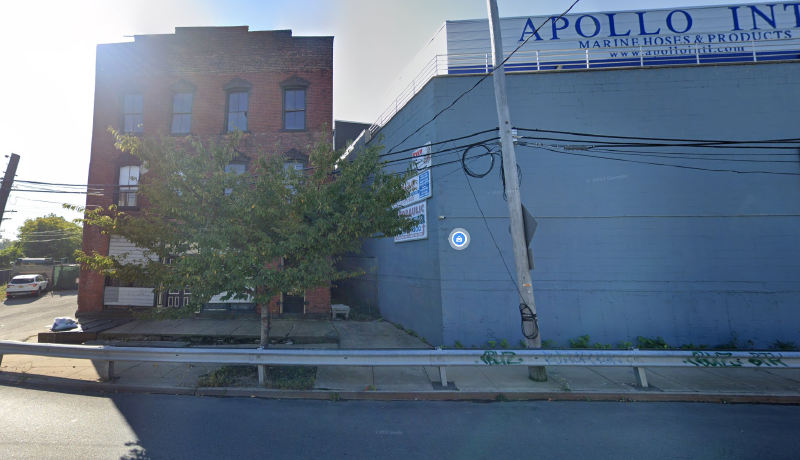
— Oct 2022, Richmond Terrace and Barrett Lane, Staten Island NY, Google Maps. View largest available size.

— Oct 2022, Richmond Terrace and Barrett Lane, Staten Island NY, Google Maps. View largest available size.
It is also interesting to note that the Factory Lake (sometimes referred to as Factory Pond) raceway flows behind Pine’s store, where stables are indicated. Factory Lake became quite polluted and was filled in by the early 1900’s, and is the present location of Corporal Thompson park, named after the first African-American from Staten Island to be killed in action in the Vietnam War, in 1967.
At West New Brighton there were in 1859:
William Bamber, painter, on Water Street; Abraham Jones, painter, on Water Street; James Burgher, mason and builder; Daniel A. Smith, mason and builder; William Vroom, mason and builder; J. J. Clute, engineer and surveyor; R. M. Cary, Comfort Home, engineer and surveyor; F. Rossback, tailor; Benjamin F. Cook, tailor; T. Smith, Cherry Lane Nursery, whose plantings may still be recognized; J. M. Snedeker, merchant; C. M. Pine, merchant; John Balzer, hotel; Matthew Cain, Castleton Shade House, George W. Vroom, grocer, Castleton Four Corners; Stephen Martling, grocer; W. J. Bodem (Bodine), building material and fuel; Bodine Bros., building materials, at the mouth of Palmer’s Run, planing mill on the water side of the Shore Road; Bodine Bros. Mill Pond; Ford’s Dock, opposite Church of the Ascension; Pine Hillyer & Co., general store on the bend between Van Street and Broadway; W. H. Bodine, Castleton House, foot of Van Street; Cornelius DuBois, 22 acre Manor Farm; J. De Groot’s store; P. Carlin’s store, near brook crossing Broadway above South Street; H. Fountain’s Hotel, near Trinity Chapel, now Church of Ascension; Old Store and Mill, and C. M. Pine & Co’s., store; Coal Yard; Frederick Reissenweber, tinsmith at Four Corners.
In the vicinity of New Brighton there were in 1859:
Mark Cox, painter, Jersey Street; Joseph Easterbrook, mason and builder; James Easterbrook, mason and builder; Cary Deven, mason and builder; James Dowd, mason and builder; William Heath, mason and builder; Benjamin P. Brower, merchant, store and post office ; Martin Weiner, Ferry House Saloon ; G. Pero, planing mill, near foot of York Avenue ; Pero Bros., lumber yard, near foot of York Avenue ; James Dempsey, livery stable, foot of York Avenue ; Hillyer & Hartley, grocers ; Assembly Rooms, on Fifth Street near Westervelt Avenue; Pavilion Hotel, M. Blanchard; Belmont Hotel, Richmond Terrace and Westervelt Avenue; St. Mark’s Hotel, DeCamp & Johnson, proprietors; Hotel on Wilkinson Estate; Cottage Tavern, M. Farley, on Lafayette Avenue; Carey’s Hotel, on New Brighton Dock; T. Dunn’s Hotel, on York Avenue; Half Way House, on Jersey Street.
It appears that by 1878, James Hillyer had left Pine’s store and started a new store on Richmond Terrace with his brother-in-law Barnett Egbert (1837 to 1916), called Hillyer & Egbert. At some point, Charles’ son joins his grocery business which is then called C. M. Pine & Son or, in some places, Charles M. Pine & Son.
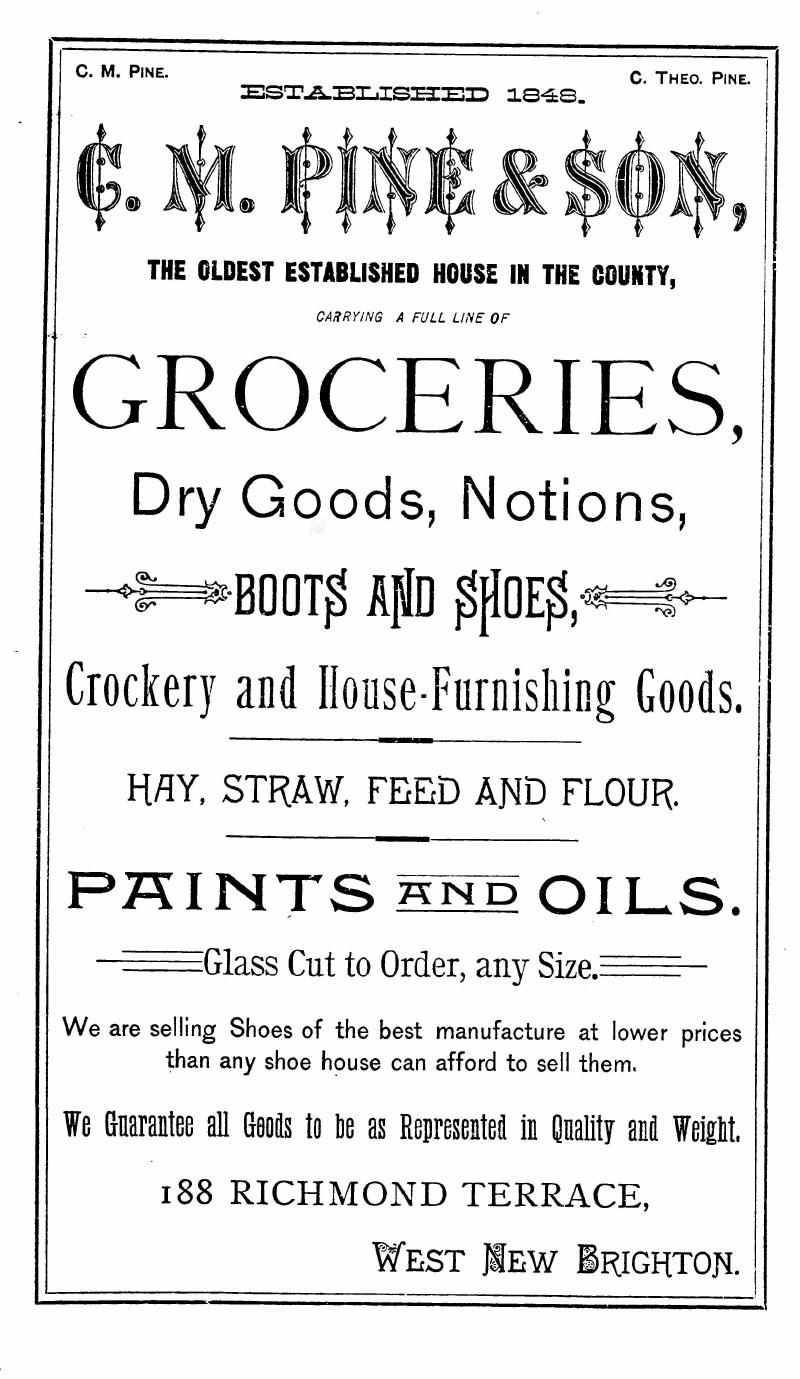
C. M. Pine. C. Theo. Pine.
Established 1848.
C.M. Pine & Son, the oldest established house in the county, carrying a full line of groceries, dry goods, notions, boots and shoes, crockery and house-furnishing goods.
Hay, straw, feed and flour.
Paints and oils.
Glass cut to order, any size.
We are selling shoes of the best manufacture at lower prices than any shoe house can afford to sell them.
We guarantee all goods to be as represented in quality and weight.
188 Richmond Terrace, West New Brighton.
— 1886 Webb’s Consolidated Directory of the North and South Shores Staten Island, inside front cover, ancestry.com. View largest available size.
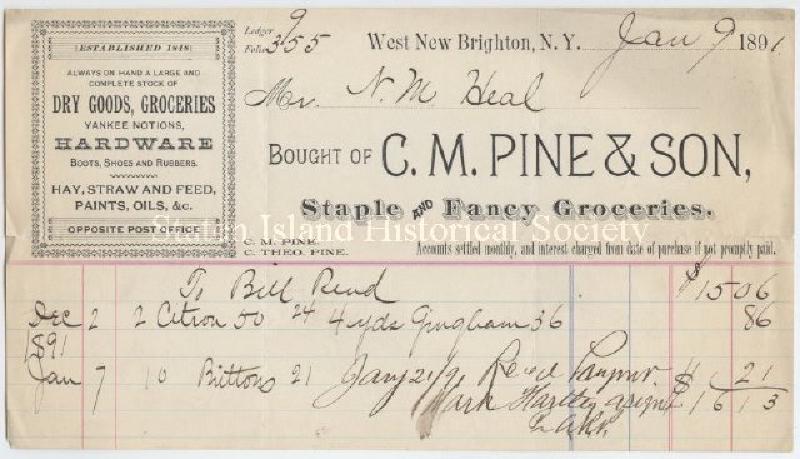
— 09 Jan 1891, C. M. Pine & Son invoice, Catalog Number X17.0031, Staten Island Historical Society, Historic Richmond Town, historicrichmondtown.org. View largest available size.
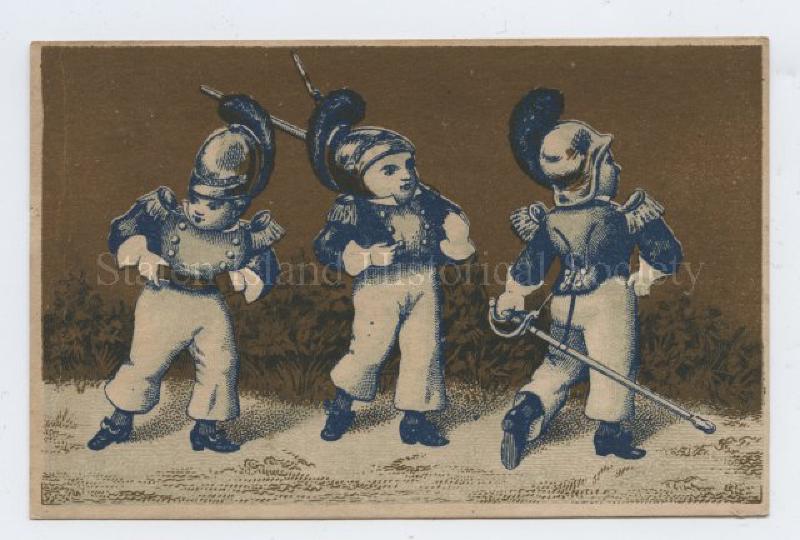
— ca. 1880-1890, C. M. Pine & Son Trade Card, front side, Catalog Number X12.0033, Staten Island Historical Society, Historic Richmond Town, historicrichmondtown.org. View largest available size.
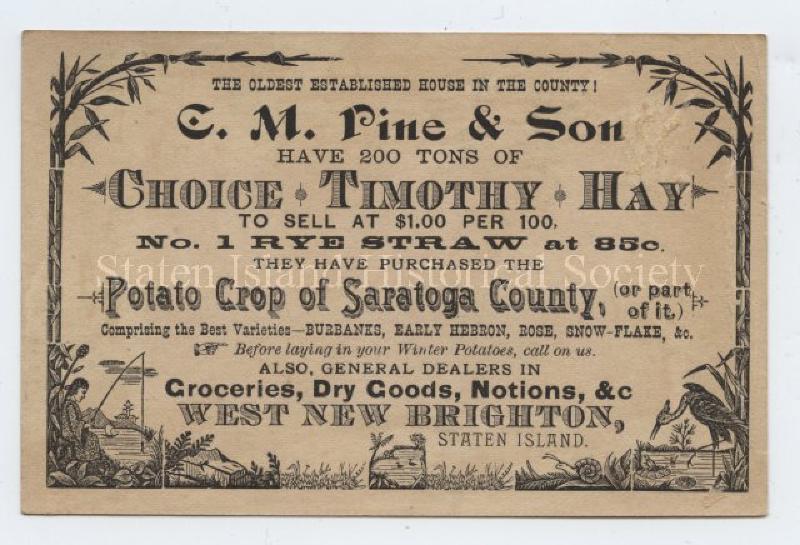
— ca. 1880-1890, C. M. Pine & Son Trade Card, back side, Catalog Number X12.0033, Staten Island Historical Society, Historic Richmond Town, historicrichmondtown.org. View largest available size.

HILLYER (Abram C.) & HARTLEY (Mark), grocers, 373 Richmond ter, N B, h 16 Jewett av, P R
Hillyer Horace, grocer, h 13 Taylor, W N B
Hillyer (James A.) & Egbert (Barnet), gro, 27 Rich ter, h 4 Taylor, W N B
Hillyer John D. Jr., clerk, b 117 York av, N B
Hillyer William, h 69 Tompkins av, T
— 1886 Webb’s Consolidated Directory of the North and South Shores Staten Island, p160, ancestry.com. View largest available size.

General Store.
Brown Bartlett, 114 Broadway, W N B
PINE CHARLES M & SON, 188 Rich ter, W N B
— 1890-91 Webb’s Consolidated Directory of the North and South Shores Staten Island, p315, ancestry.com. View largest available size.

Pine Alverade R., clerk, h 4 New, W B
Pine C. Theodore (C. M. Pine & Son), b 186 Rich ter, W N B
Pine Charles M. & Son (C. Theodore Pine), gen’l store, 188 Rich ter, h 186 do, W N B
— 1890-91, Webb’s Consolidated Directory of the North and South Shorts Staten Island, p287, ancestry.com. View largest available size.

General Stores
Brown Bartlett, 114 Broadway, W N B
DRAKE J. STERLING, Washington av c Harbor rd, MH
Pine Charles M & Son, 183 Rich ter, W N B
Snyder W. J. & Sons, 372 Shore rd, E
— 1890-91 Webb’s Consolidated Directory of the North and South Shores Staten Island, p388, ancestry.com. View largest available size.
John Hillyer, sometimes written Hilliard, lived on Staten Island in 1693, and married Elizabeth Dey in 1714.
Their children were John, (supervisor in 1767) Elizabeth, Mary, James, William, Nathaniel, Simon and Lawrence.
The present families of the name are descended from the youngest son Lawrence. His son John (sheriff in 1799 and 1819), was born in July, 1763, and died in July, 1848. His wife Elsie Merrill was born in November, 1768, and died in August, 1858. Their children were Lawrence, (sheriff in 1831 and Member of Assembly 1835 and 1837.) John B. (Member of Assembly 1873.)
John B. is the father of James A., late of the firm of Pine, Hillyer & Co., of West New Brighton; and Abraham, of the firm of Hillyer and Hartley, of New Brighton, beside several other children.
Other Hillyers are mentioned in the records of St. Andrew’s Church, as follows
John and Esther his wife had
A daughter, born Sept. 19, 1756.
A son, Nathaniel, born Oct. 2, 1765.
A daughter, born Nov. 14, 1768.
John, Jr., had a son Abraham, born Jan. 20, 1759.
William and Dinah his wife had
A daughter, born Dec. 24, 1748.
A daughter, born Sept. 11, 1756.
John and Mary his wife had
A daughter, born Mar. 29, 1774.
A son John, born April 18, 1776.
Lawrence and Ann Larzalere married Dec. 4, 1808.
Along the north shore we note the following at New Brighton:
Hillyer & Hartley, established 1866; John Holtkamp & Sons, established 1857; W. T. Vredenburgh, established 1867; John J. Wood, established 1890; Victor F. Meyer, a pioneer bicycle dealer; Joseph Kaiser, successor to John J. Fetherston, established in 1867; Thomas Howarth, established in 1854; C. Bardes, established in 1874; C. J. Driscoll, established in 1864; Wm. Russell, established in 1887.
At West New Brighton in 1893 were:
Benedict Parker, established 1872; F. Klemcke, established 1887; M. A. Bamber, established 1867; Hillyer & Egbert, established 1878; W. J. Grimshaw, established 1876;

Hillyer & Hartley, wholesale and retail grocers, 373 Richmond Terrace, New Brighton, S.I.
Dealers in paints, oils, glassware, crockery, hardware, &c.
Goods delivered free of charge.
— 1890-91 Webb’s Consolidated Directory of the North and South Shores Staten Island, p90, ancestry.com. View largest available size.
Hartley — The Hartley family came from England about 1844 and became identified with the retail grocery business. Mark Hartley appears in the directory of 1882, and Hillyer and Hartley, whose store was in New Brighton, will be remembered by many readers.

Hillyer & Egbert, General Merchandise, Nos. 28 and 30 Richmond Terrace, S. I.
The premises are 25x60 feet in dimensions, well fitted up, and contain a stock of crockeryware, decorated sets, plain and fancy pieces, dinner and tea sets, also glassware, wood and willow ware, cutlery and silver-plated ware, lamps, fixtures, shades, illuminating oils, etc., all of which are sold at the lowest prices. Their groceries consist of fancy and staple articles, provisions, poultry, vegetables, etc. Popular prices prevail and all orders are promptly filled. Competent and clever clerks are employed, and customers are liberally dealt with. The individual members of the firm are James A. Hillyer and Barnett Egbert, and they have been in business together for the past eight years. Previous to that time Mr. Hillyer was engaged for twenty-five years with Mr. C. M. Pine in another portion of the place. Mr. Egbert is a native of Staten Island, and Mr. Hillyer of New York city,
— 1886, Illustrated sketch book of Staten Island, New York : its industries and commerce.. New York: S.C. Judson, p81, ancestry.com. View largest available size.
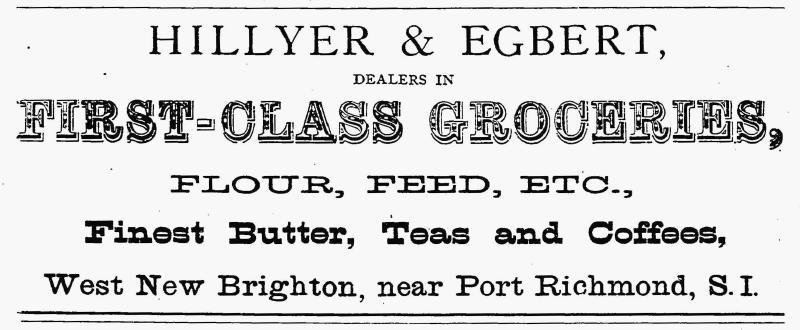
Hillyer & Egbert, dealers in first-class groceries, flour, feed, etc., finest butter, teas and coffees, West New Brighton, near Port Richmond, S.I.
— 1886, Illustrated sketch book of Staten Island, New York : its industries and commerce.. New York: S.C. Judson, p85, ancestry.com. View largest available size.
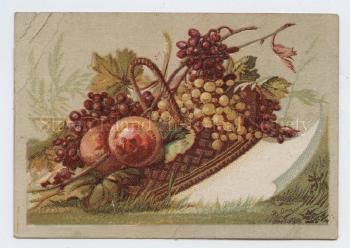
— 1880s-1890s, Trade Card, Front, Catalog Number X12.00031, Staten Island Historical Society, Historic Richmond Town, historicrichmondtown.org. View largest available size.
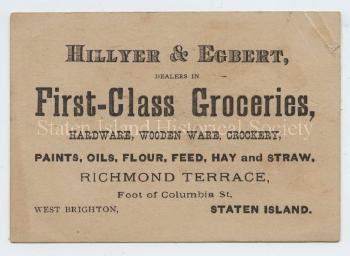
— 1880s-1890s, Trade Card, Back, Catalog Number X12.00031, Staten Island Historical Society, Historic Richmond Town, historicrichmondtown.org. View largest available size.
James A. Hillyer’s business partner is his brother-in-law Barnett Egbert Jr. (1837 to 1916), who married James’ sister Alice Elizabeth (Hillyer) Egbert (1841 to 1915).
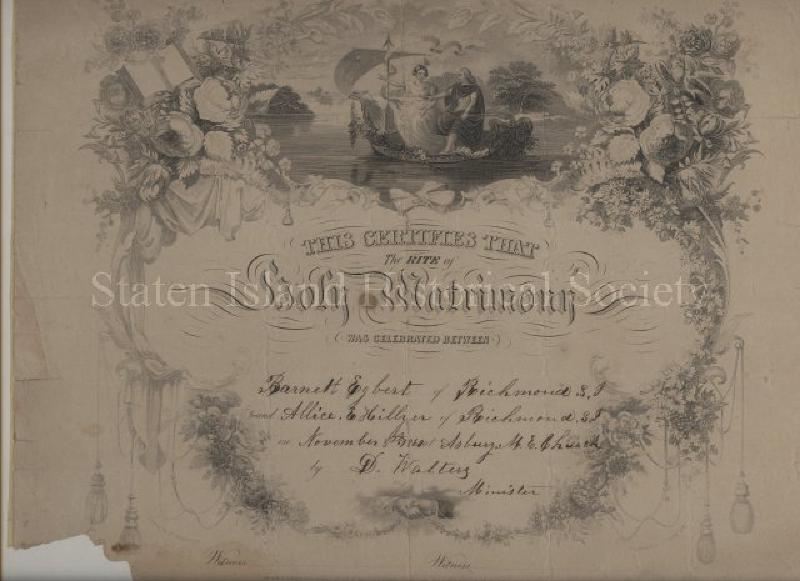
— 08 Nov 1860, Marriage Certificate, Catalog Number 76.045.0001, Staten Island Historical Society, Historic Richmond Town, historicrichmondtown.org. View largest available size.
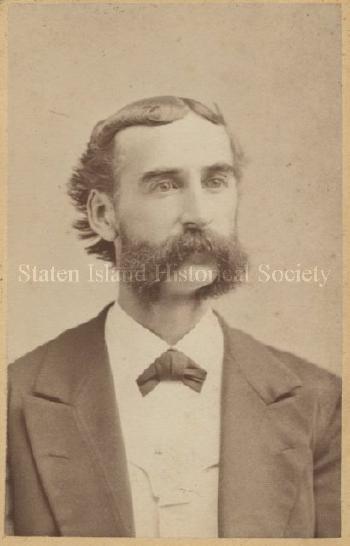
— 1880, Portrait Photograph of Barnett Egbert Jr., Catalog Number 12.005.0004, Staten Island Historical Society, Historic Richmond Town, historicrichmondtown.org. View largest available size.
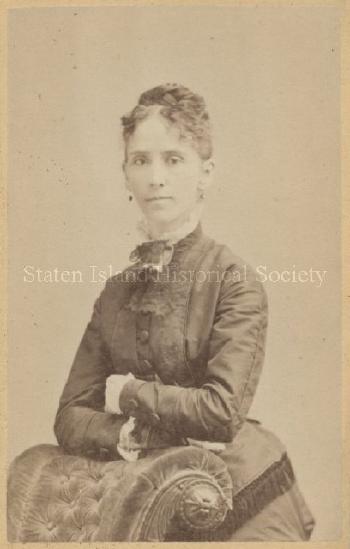
— 1880, Portrait Photograph of Alice Elizabeth (Hillyer) Egbert, Catalog Number 12.005.0005, Staten Island Historical Society, Historic Richmond Town, historicrichmondtown.org. View largest available size.
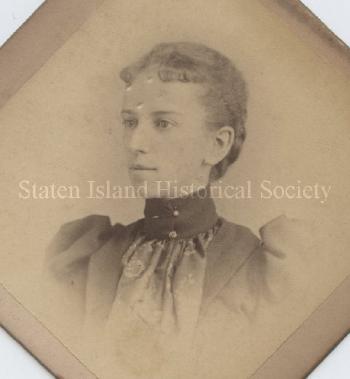
— 1891, Portrait Photograph of Joanna Egbert, Catalog Number 12.005.0006, Staten Island Historical Society, Historic Richmond Town, historicrichmondtown.org. View largest available size.
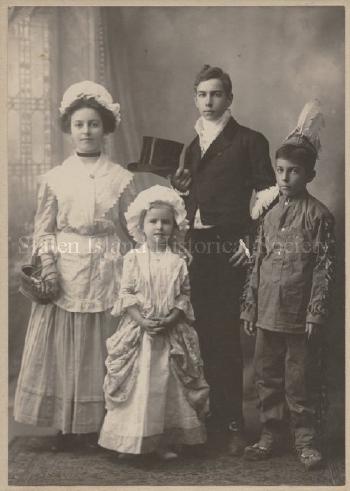
— 1909, Portrait Photograph of Benjamin Children, Catalog Number 12.005.0009, Staten Island Historical Society, Historic Richmond Town, historicrichmondtown.org. View largest available size.
James Hillyer appears to also be connected with William Snedeker, who married Charles’ and Mary Ann’s sister Lois Almy (Pine) Snedeker (1805? to 07 Nov 1890). William and Lois moved to Staten Island in the 1850’s, and William was also in the dry goods business. William Snedeker and James A. Hillyer were also leaders within the congregation of the Trinity Methodist Episcopal Church, near James’ home.
The 1870 US Census and the 1875 NY Census show William Snedeker’s family living near James Hillyer’s family, and near both the Methodist Church and C. M. Pine & Co.
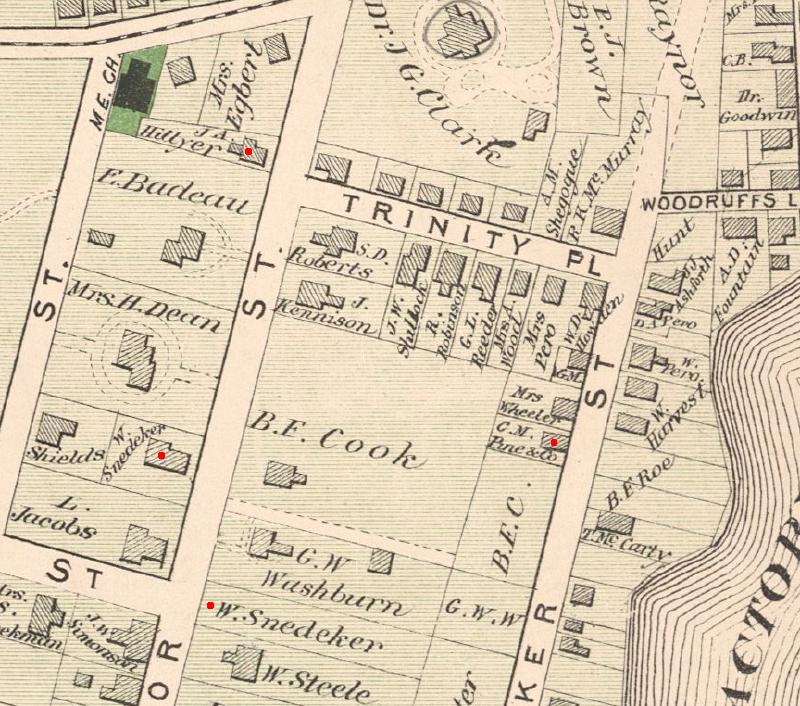
— Lionel Pincus and Princess Firyal Map Division, The New York Public Library. “Atlas of Staten Island, Richmond County, New York, from official records and surveys; compiled and drawn by F. W. Beers” The New York Public Library Digital Collections. 1874. Cropped and highlighted in red. https://digitalcollections.nypl.org/items/510d47e2-0b93-a3d9-e040-e00a18064a99. View largest available size.

— 14 Jun 1860, United States Federal Census, Castleton NY, p82, ancestry.com. View largest available size.

— 07 Jun 1865, New York State Census, Castelton NY, p66, ancestry.com. View largest available size.
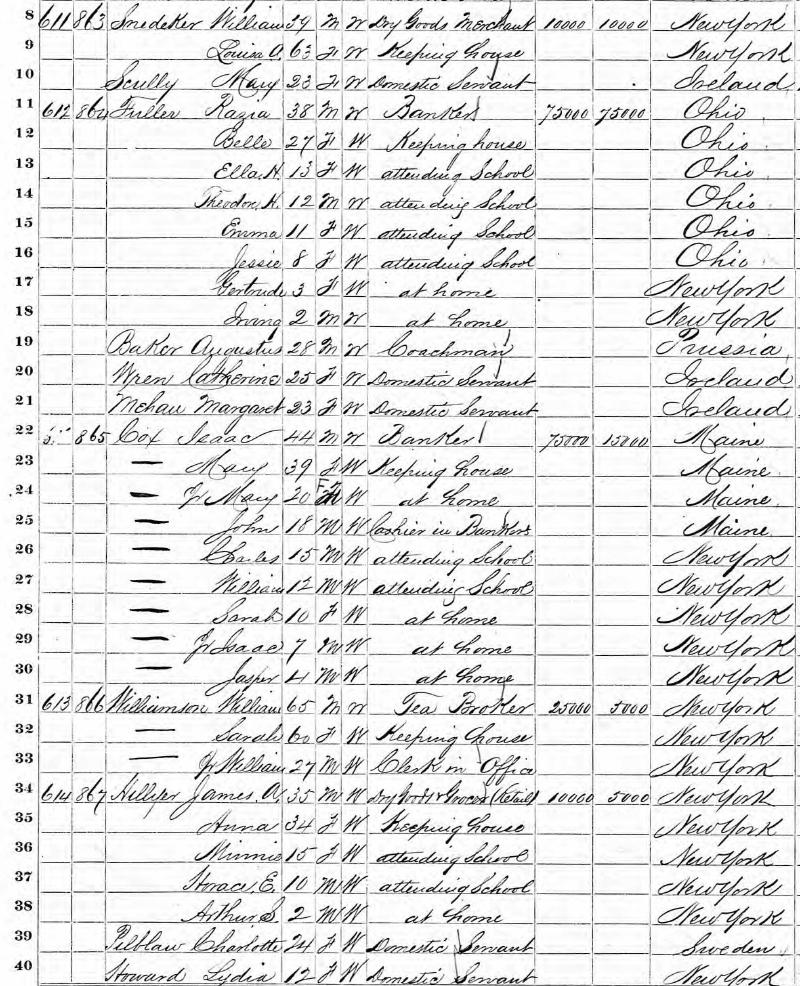
— 07 Jul 1870, United States Federal Census, Castleton NY, p122, ancestry.com. View largest available size.
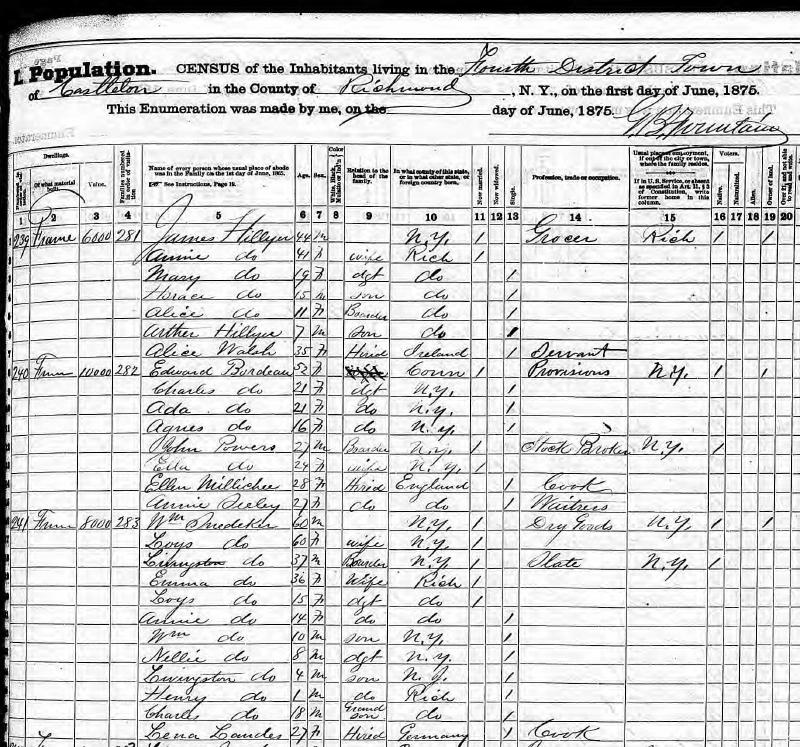
— 1875 Jun, United States Federal Census, Castleton NY, p33, ancestry.com. View largest available size.
(As is evident from these census entries, James A. Hillyer’s wife Phoebe (22 Jul 1834 to 05 Feb 1914) had the middle name “Anna” and apparently had the nickname “Annie”.)
A summary of the census data for William Snedeker during the relevant time period:
| Year | Location | Age | Occupation |
|---|---|---|---|
| 1850 | NY Ward 17 | 39 | hosiery |
| 1860 | Castleton | 48 | merchant (son and neighbor, Livingston is “merchants clerk”) |
| 1870 | Castleton | 59 | dry goods merchant |
| 1875 | Castleton | 60 | dry goods (son Livingston and wife are “boarders”) |
| 1880 | Castleton | 69 | boarder (living with son Livingston) |
(At different times, Livingston was a reporter for the Richmond County Advance as well as a “slate dealer” among other careers.)
Before he moved to Staten Island, the firm of Wm. Snedeker & Co. “dry goods jobbers” was located in the Manhattan financial district just a few blocks northeast of the future site of 1 World Trade Center and 2 World Trade Center, the “Twin Towers” that collapsed in the September 11 attacks of 2001. (Upon their completion on 04 April 1973, the Twin Towers were the tallest buildings in the world, at 1,368 feet and 1,362 feet respectively.) Dry goods jobbers were wholesalers, essentially middle-men between the factories from whom they purchased goods and the retail stores, such as Pine, Hillyer & Co., to whom they subsequently sold those same goods.
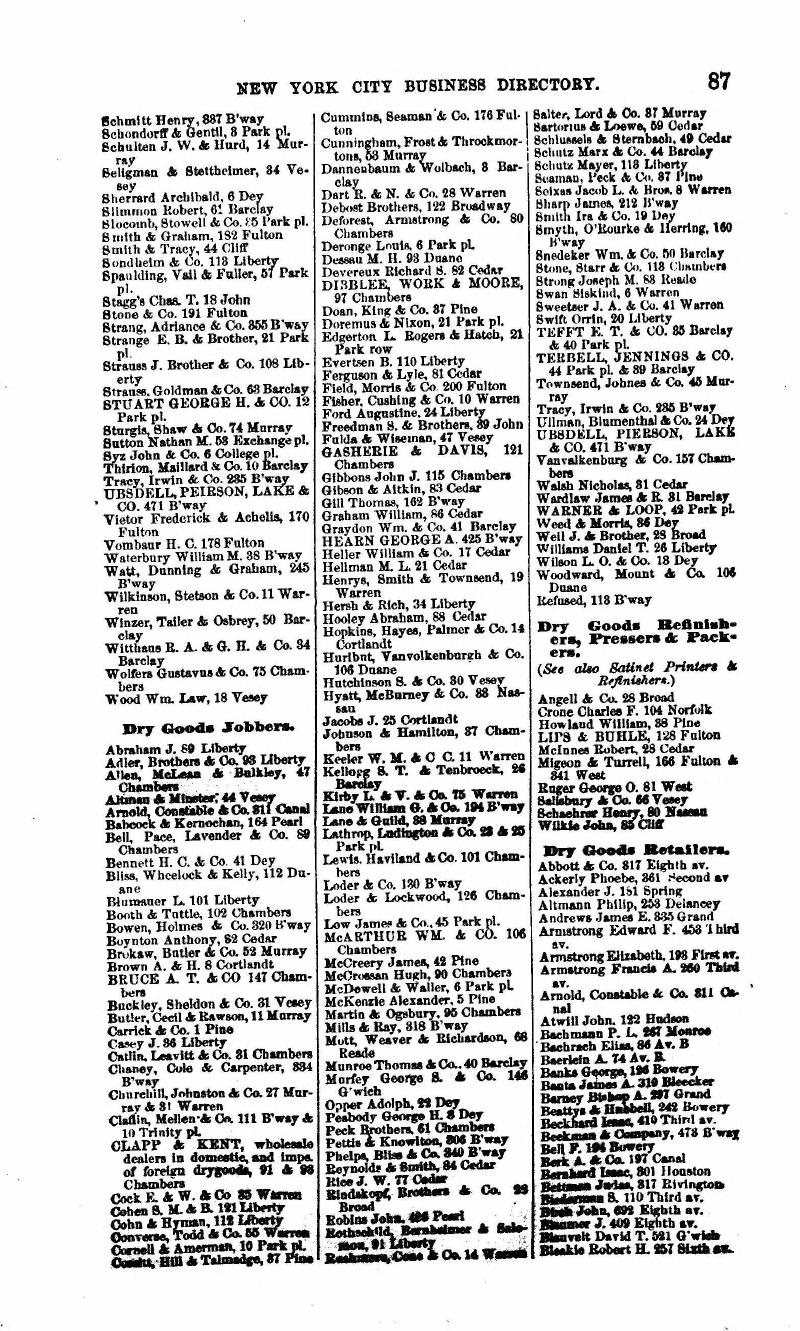
…Bliss, Wheelock & Kelly, 112 Duane
…Snedeker Wm. & Co. 50 Barclay
— 1859, New York City Business Directory, p87, ancestry.com. Partial transcription. View largest available size.
A dry-goods jobber is a wholesale buyer and seller, for cash or for approved credit, of all manner of goods, wares, and materials, large and small, coarse and fine, foreign and domestic, which pertain to the clothing, convenience, and garnishing, by night and by day, of men, women, and children: from a button to a blanket; from a calico to a carpet; from stockings to a bead-dress; from an inside handkerchief to a waterproof; from a piece of tape to a thousand bales of shirtings; not forgetting linen, silk, or woollen fabrics, for drapery or upholstery, for bed or table, including hundreds of items which time would fail me to recite. All these the dry-goods jobber provides for his customer, the retailer, who in his turn will dispense them to the consumer.
A factory having produced a stock of goods from the best designs to be obtained by its agents here and abroad, the next step is to sell at a profit. Twenty-five years ago the mill or factory sold all its goods to the jobbers, who in turn distributed them to the retailers throughout the country. Each mill had its selling agents who undertook to dispose of its product to the jobbers. A retailer could buy nothing directly from the agent of the mill. Within the last ten or fifteen years the small jobber has been eliminated. In 1850 there were half a hundred dry-goods jobbers in New York City and as many in Boston all doing a good business. Today the number has dwindled to half a dozen in each city. The same thing is true of Philadelphia and Chicago. Only a few of the very largest jobbing houses have survived. The selling agents of the mills now go direct to the retailer, because the retailers have in many instances become buyers upon a much larger scale than the small jobber of former days. Go into the Boston or New York office of the agent of any important mill, and you will find plenty of samples and clerks, but almost no buyers. The agent now goes to the buyer. The agent of the largest cotton-mill in western Massachusetts told me that he sent his men to every large drygoods shop in Boston every day, and his partner in New York did the same thing there. At certain seasons Boston and New York, twenty-five or thirty years ago, were overrun with the buyers of dry-goods houses from all parts of the country. There were hotels and even newspapers devoted to these buyers and their doings. Much of this business has passed away. To-day the travelling men, “drummers,” of the mills and the few large jobbing houses that have survived, scour the country, taking their samples to the retailer. A few large jobbers, doing an immense business, still survive in all our large centres because they have the machinery for the distribution of goods in channels where it is not worth the while of the agent to enter—small shops in small towns. The small jobber who gave up business when he found the mills selling directly to the retail shops who could buy even more goods at a time than he could, had neither the capital nor the army of travelling men necessary to do business upon this scale. The jobber who could buy five thousand cases of goods at a time, and had the machinery and the means for disposing of it, survives because the mills sell cheapest to the largest buyer, and the jobber who buys on this scale is more important that even the largest retail store. But the small jobber, buying one hundred cases of the same goods, gets no better terms than the big retailer and has therefore no excuse for being. Some of the big department stores now obtain a monopoly of certain patterns or designs by taking the whole output of the mill, thus doing what was formerly in the power of only the greatest of jobbers.

Snedeker.–On Friday at West New Brighton, Lois Almy Snedeker aged 84 years, relict of the late William Snedeker. Funeral services at Trinity M. E. Church to-morrow at [3?] p.m. Interment at Hempstead, L. I. on Monday.
— 08 Nov 1890, Richmond County Advance, West New Brighton NY, p5, nyshistoricnewspapers.org. View largest available size.
Charles and his son Theodore also had significant business dealings beyond their store. According to data provided by the Empire State Postal History Society, Charles M. Pine was also postmaster of what was then called the North Shore, Staten Island post office from 16 Dec 1850 to 26 Oct 1853. This post office became the West New Brighton station of Staten Island on 21 Jan 1917.
The most interesting of these 1856 advertisements are those which relate to the Richmond County Mutual Insurance Company. On March 27, 1856, it advertised that its charter had been extended for twenty years, the notice being signed by H. B. Metcalfe, secretary, he being also the county judge and surrogate. Elsewhere this company advertised the names of its agents, viz. ; C. M. Pine, Castleton ; Elwood Taylor, Southfield; Michael Van Name, Jr., Northfield; Bornt P. Winant, West- field. The junior author remembers policies issued by this company among his grandfather’s papers.
Charles M. Pine was also one of the incorporators of The Staten Island Savings Bank, which was organized on December 21, 1866, at Stapleton. His son Theodore Pine was a trustee of Richmond County Savings Bank.
The Richmond County Savings Bank was organized on October 30, 1886. It was at first located in Odd Fellows Hall, West New Brighton, until 1899 when it removed to its own building on Richmond Terrace. From that it moved to the handsome building it now owns and occupies at the corner of Castleton Avenue and Taylor Street, West New Brighton. Its first officers were Monroe Eckstein, president; John Westbrook, first vice-president; Jacob I. Housman, second vice-president; Robert Moore, cashier. Trustees : George Bechtel, Thomas Humphrey, Stephen D. Simonson, Richard L’H. Finch, Charles T. Pine, Charles W. Hunt, Charles W. Kennedy, John W. Winmill, Otto Ahlmann, Daniel T. Cornell, Thomas Byrne, David Soloman. By 1900 John Westbrook had become president and the following had joined the board, Henry P. Morrison, Frank W. Tompkins, Herbert Crabtree, J. A. Snyder, Benedict Parker, Azel F. Merrell, Samuel A. Robinson, George M. Matthius, John F. Smith, Edward D. Clark. In 1911 Mr. Smith was president with the late G. H. Tredwell as secretary. Upon Mr. Tred- well’s death, Mr. Matthius became secretary.
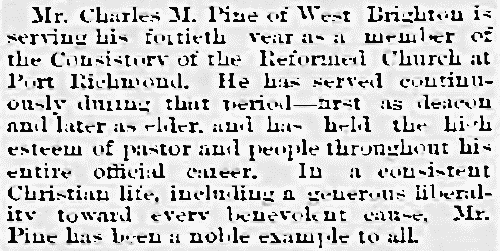
Mr. Charles M. Pine of West Brighton is serving his fortieth year as a member of the Consistory of the Reformed Church at Port Richmond. He has served continuously during that period-first as deacon and later as elder, and has held the high esteem of pastor and people throughout his entire official career. In a consistent Christian life, including a generous liberality toward every benevolent cause, Mr. Pine has been a noble example to all.
— 14 Jun 1890, Richmond County Advance, West New Brighton NY, p4, nyshistoricnewspapers.org. View largest available size.

LOPER—At West New Brighton, Jan, 6th, at the residence of her son in-law, Charles M Pine, Esq., Mrs. Sarah Loper, widow of Luther Loper, formerly of Hempstead, L. I., AE 83 yrs 2 months. Remains taken to Hempstead for interment.
— Jan 1870, New York Tribune, fultonhistory.com. View largest available size.

LOPER–Jan. 6, at the residence of her son-in-law, Charles M. Pine, West Brighton, Staten Island, Mrs. Sarah Loper, widow of the late Luther Loper, aged 83 years, 1 month and 27 days.
Remains to be taken to Hempstead, L.I., by 10 o’clock train L. I. Railroad on Saturday, Jan. 8.
— 08 Jan 1870, New York Daily Tribune, New York NY, p?, fultonhistory.com. View largest available size.

Recent attempts have been made by scandal-mongers and gossips to injure the reputation of groceryman Bohan of West Brighton, by circulating rumors to the effect that he was discharged from the employ of Messrs. C. M. Pine & Son, and throwing reflections on the young man’s character. Mr. Bohan has been considerably annoyed by these cowardly insinuations, and in order to prove the falseness of the rumors, he applied to the Messrs. Pine for a letter, which we publish in another column. Gossip mongers should be careful how they talk.
— 15 Mar 1890, Richmond County Advance, West New Brighton NY, p4, nyshistoricnewspapers.org. View largest available size.
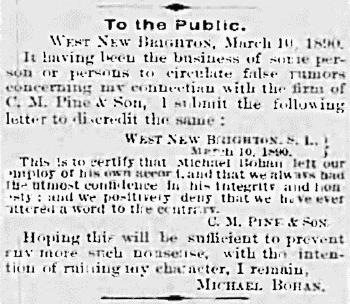
To the Public.
West New Brighton, March 10, 1890.
It having been the business of some person or persons to circulate false rumors concerning my connection with the firm of C. M. Pine & Son, I submit the following letter to discredit the same:
West New Brighton, S. I., March 10, 1890.
This is to certify that Michael Bohan left our employ of his own accord and that we always had the utmost confidence in his integrity and honesty; and we positively deny that we have ever uttered a word to the contrary. C. M. PINE & SON
Hoping this will be sufficient to prevent any more such nonsense, with the intention of ruining my character, I remain, Michael Bohan.
— 15 Mar 1890, Richmond County Advance, West New Brighton NY, p1, nyshistoricnewspapers.org. View largest available size.
Despite many decades of success in varied endeavors that were important in the growth of Staten Island, both Charles M. Pine and his son Theodore were financially ruined by the actions of Charles’ other son Alverade. Alverade’s indiscretions became public approximately six months after the death of his young wife, although I do not presently know if the two events are related in any way. Also, note the role that Mark Hartley played in the aftermath.

Pine.—On Thursday, at West Brighton. Serena, wife of Alverade R. Pine in the 32nd year of her age. Funeral private.
— 10 May 1890, Richmond County Advance, West New Brighton NY, p8, nyshistoricnewspapers.org. View largest available size.
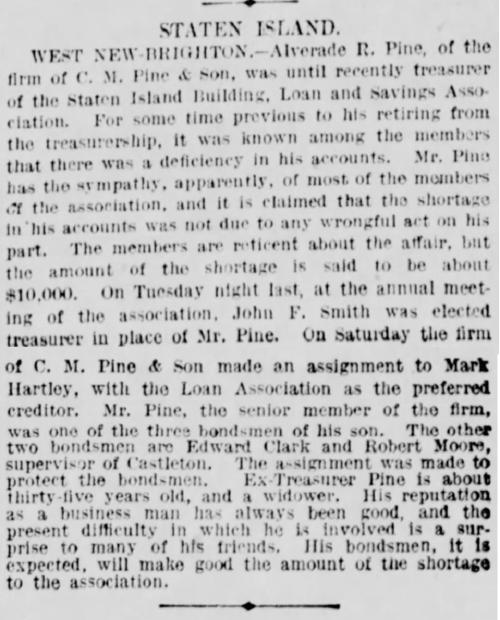
STATEN ISLAND.
WEST NEW BRIGHTON.—Alverade R. Pine, of the firm of C. M. Pine & Son, was until recently treasurer of the Staten Island Building, Loan and Savings Association. For some time previous to his retiring from the treasurership, it was known among the members that there was a deficiency in his accounts. Mr. Pine has the sympathy, apparently, of most of the members of the association, and it is claimed that the shortage in his accounts was not due to any wrongful act on his part. The members are reticent about the affair, but the amount of the shortage is said to be about 10,000. On Tuesday night last, at the annual meeting of the association, John F. Smith was elected treasurer in place of Mr. Pine. On Saturday the firm of C. M. Pine & Son made an assignment to Mark Hartley, with the Loan Association as the preferred creditor. Mr. Pine, the senior member of the firm, was one of the three bondsmen of his son. The other two bondsmen are Edward Clark and Robert Moore, supervisor of Castleton. The assignment was made to protect the bondsmen. Ex-Treasurer Pine is about thirty-five years old, and a widower. His reputation as a business man has always been good, and the present difficulty in which he is involved is a surprise to many of his friends. His bondsmen, it is expected, will make good the amount of the shortage to the association.
— 12 Jan 1891, New York Tribune, New York NY, p3, newspapers.com. View largest available size.
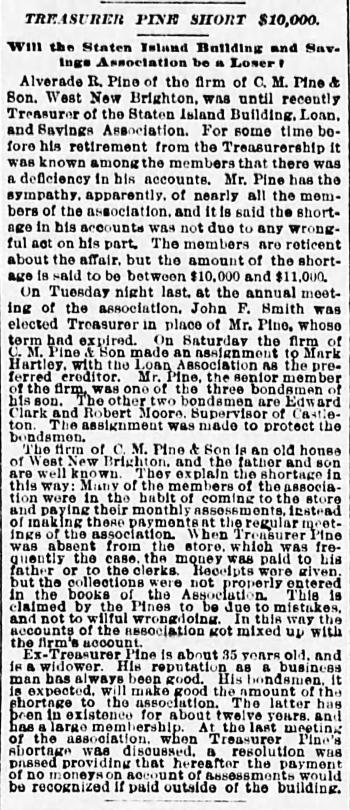
TREASURER PINE SHORT $10,000.
Will the Staten Island Building and Savings Association be a Loser?
Alverade R. Pine of tho firm of C. M. Pine & Son, West New Brighton, was until recently Treasurer of the Staten Island Building, Loan, and Savings Association. For some time before his retirement from the Treasurership it was known among the members that there was a deficiency in his accounts. Mr. Pine has the sympathy, apparently, of nearly all the members of the association, and it is said the shortage in his accounts was not due to any wrongful act on his part. The members are reticent about the affair, but the amount of the shortage is said to be between $10,000 and $11,000.
On Tuesday night last, at the annual meeting of the association, John F. Smith was elected Treasurer in place of Mr. Pine, whose term had expired. On Saturday the firm of C. M. Pine & Son made an assignment to Mark Hartley, with the Loan Association as the preferred creditor. Mr. Pine, the senior member of the firm, was one of the three bondsmen of his son. The other two bondsmen are Edward Clark and Robert Moore, Supervisor of Castleton. The assignment was made to protect the bondsmen.
The firm of C. M. Pine & Son is an old house of West New Brighton, and the father and son are well known. They explain the shortage in this way: Many of the members of the association were in the habit of coming to the store and paying their monthly assessments, instead of making these payments at the regular meetings of the association. When Treasurer Pine was absent from the store, which was frequently the case, the money was paid to his father or to the clerks. Receipts were given, but the collections were not properly entered in the books of the Association. This is claimed by the Pines to be due to mistakes, and not to willful wrongdoing. In this way the accounts of the association got mixed up with the firm’s account.
Ex-Treasurer Pine is about 35 years old, and is a widower. His reputation as a business man has always been good. His bondsmen, it is expected, will make good the amount of the shortage to the association. The latter has been in existence for about twelve years, and has a large membership. At the last meeting of the association, when Treasurer Pine’s shortage was discussed, a resolution was passed providing that hereafter the payment of no moneys on account of assessments would be recognized if paid outside of the building.
— 12 Jan 1891, The Sun, New York NY, p1, newspapers.com. View largest available size.
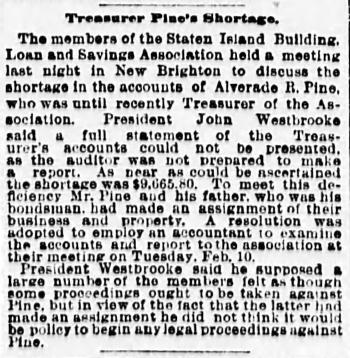
Treasurer Pine’s Shortage.
The members of the Staten Island Building, Loan and Savings Association held a meeting last night in New Brighton to discuss the shortage in the accounts of Alverade R. Pine, who was until recently Treasurer of the Association. President John Westbrooke said a full statement of the Treasurer’s accounts could not be presented, as the auditor was not prepared to make a report. As near as could be ascertained the shortage was $9,665.80. To meet this deficiency Mr. Pine and his father, who was his bondsman, had made an assignment of their business and property. A resolution was adopted to employ an accountant to examine the accounts and report to the association at their meeting on Tuesday, Feb, 10.
President Westbrooke said he supposed a large number of the members felt as though some proceedings ought to be taken against Pine, but in view of the fact that the latter had made an assignment he did not think it would be policy to begin any legal proceedings against Pine.
— 15 Jan 1891, The Sun, New York NY, p3, newspapers.com. View largest available size.

Failure of an Old Firm
The people of West Brighton were greatly surprised on Saturday last by the report that C. M. Pine & Son had failed. Charles M. Pine, the senior member of the firm, had been engaged in the grocery and general merchandise business in the community for nearly half a century, and was, at one time, reputed to be worth nearly or quite $25,000. It was, therefore, as many said, about the last concern on the North Shore that would have been expected to fail. The news spread rapidly, and everyone began to ask what had caused so unexpected an occurrence. The facts, briefly stated, appear to be these:
For several years, C. Theodore Pine, the junior member of the firm, was treasurer of the Staten Island Building-Loan and Savings Association. His health failed about two years ago and he lost his eyesight. His brother, Alverade R. Pine, who was a clerk in the store was then elected to the treasurership of the Association, as everybody had implicit confidence in the family. It now comes out that the funds of the Association have been used in the business of the firm in a free and easy manner year after year, unknown and unsuspected by the directors and auditors of the Association, until is is now suddenly discovered that there is a shortage in his account amounting to about $10,000.
When this became known, C. M. Pine & Son, the former of whom was one of the bondsmen, made an assignment in favor of the other two bondsmen, Edward D. Clark and Robert Moore, with A. R. Pine as a preferred creditor. The later then made an assignment of his claim on the assets of the firm (also turning over a mortgage and his household furniture) and made the Building-Loan Association his preferred creditor. Mark Hartley of New Brighton is the assignee.
A special meeting of the stockholders of the Association was held, on Wednesday evening, but President Westbrook stated that the auditors were not yet prepared to make a full report, notwithstanding the fact that they have been working on the accounts until late at night ever since the assignment. There were several matters which they had been unable to get at thus far, but they hoped to get them all straightened out before the next regular meeting. O. P. Geoffroy, one of the auditors made a partial statement, which indicated a shortage of $9,056.53 in cash, and a deficiency in vouchers drawn on the treasurer amounting to $1,998.45, making a total of $11,054.98. They expect that a further examination will reduce this sum considerably. Secretary Wheeler stated that it would be necessary for them to call in all the passbooks of parties who appear to be in arrears on his books before the exact shortage could be determined.
Mr. C[undlear] asked if there was any likelihood of the Association losing anything. Mr. Clark said he did not see how it could lose one cent. Should there be anything lacking after the assignment is settled, the businessmen will have to make it good. He, for one, expected to meet that obligation. Daniel [unclear] declared that the auditors and directors had been deceived by Treasurer Pine, [text unclear] some way to deposit in bank so that he could show a certificate of deposit for the amount the books called for, and then, perhaps, drawn it out the next day after the auditors had examined his account-!
Mr. Brill—that does not exonerate the auditors and directors of this Association. I joined in good faith and with full confidence in the officers, but if I had known what I do now I would never have put a dollar in here!
President Westbrook reminded the gentleman that each member of the Association was at fault if the officers were. The trouble had come about as a result of the lax methods under which they had been satisfied to do business. There had been no check on the treasurer, either in depositing or drawing out money. At the annual meeting, however, resolutions had been adopted requiring the treasurer to show the president a certificate of deposit within 24 hours after the money is received, and no money can be drawn out without the signatures of the president and secretary. All moneys must hereafter be paid in at the office of the Association. To make it easier for members to do this, the secretary will sit at the Richmond County Savings Bank (in the same building) on the Saturday evening previous to the regular monthly meeting (the second Friday evening of each month), and the Saturday evening following the monthly meeting. The money taken in at such times will be deposited before leaving the building, as the savings bank is authorized to receive deposits for the Bank of Staten Island.
W. H. Prall said a report reflecting the clerks in Pine’s store had been published in some of the papers. He thought it very unjust that these young men should be charged, even by insinuation, with appropriating any of the money belonging to [the Association?]. No one present believed such to be the case, for so many incorrect statements about these matters get in the city papers that people make allowance for them. The meeting adjourned till Tuesday evening, Feb. 10th, when the auditors will make a full report.
— 17 Jan 1891, Richmond County Advance, West New Brighton NY, p1, nyshistoricnewspapers.org. View largest available size.
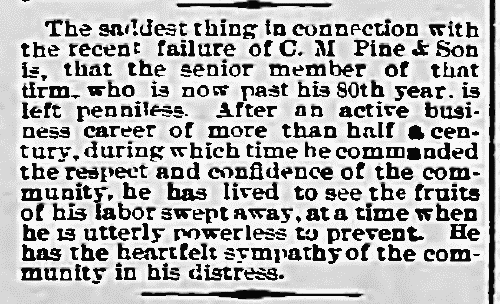
The saddest thing in connection with the recent failure of C. M. Pine & Son is, that the senior member of that firm, who is now past his 80th year, is left penniless. After an active business career of more than half a century, during which time he commanded the respect and confidence of the community, he has lived to see the fruits of his labor swept away, at a time when he is utterly powerless to prevent. He has the heartfelt sympathy of the community in his distress.
— 24 Jan 1891, Richmond County Advance, West New Brighton NY, p4, nyshistoricnewspapers.org. View largest available size.
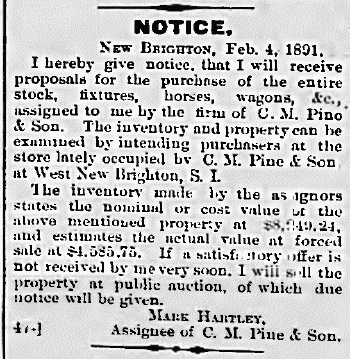
NOTICE.
New Brighton, Feb. 4, 1891.
I hereby give notice, that I will receive proposals for the purchase of the entire stock, fixtures, horses, wagons, &c., assigned to me by the firm of C. M. Pine & Son. The inventory and property can be examined by intending purchasers at the store lately occupied by C. M. Pine & Son at West New Brighton, S. I.
The inventory made by the assignors states the nominal or cost value of the above mentioned property at $8,[3?]49.24, and estimates the actual value at forced sale at $4,585.75. If a satisfactory offer is not received by me very soon, I will sell the property at public auction, of which due notice will be given.
Mark Hartley, Assignee of C. M. Pine & Son.
— 07 Feb 1891, Richmond County Advance, West New Brighton NY, p4, nyshistoricnewspapers.org. View largest available size.

Assignee’s Sale.
MERLIN F. HATCH, Auctioneer, BY H. T. METCALFE & SON, Will sell on Monday, March 2, 1891, Commencing at 10 a. m., by order of MARK HARTLEY, Esq, Assignee of C. M. PINE & SON, The Stock and Fixtures contained in the store occupied by them at west Brighton, S. I. Comprising a large and varied assortment of Groceries and Canned Goods, Boots and Shoes, Dry Goods, Paints, and General Merchandise. Also to be sold promptly at 12 m. on Monday, March 2nd, 4 horses, 4 covered delivery wagons, 1 heavy grocer’s truck, 4 double bob sleighs, 1 two seated pleasure sleigh, 4 sets single harness, 4 strings of bells, blankets, horse covers, etc.
The sale will be continued from day to day commencing at the same hour, until entirely sold.
TERMS CASH ON DELIVERY
Catalogues on the morning of sale.
— 28 Feb 1891, Richmond County Advance, West New Brighton NY, p7, nyshistoricnewspapers.org. View largest available size.
Left penniless, Charles M. Pine was forced to return to work, and to do so for the first time in many years as an employee in someone else’s business. Elmira died just over a year later. Theodore, who had been blind for two years prior to the business failure, continued to decline, becoming “perfectly helpless” in his final years. Theodore died more than 2 years before Charles, and approximately six months prior to Charles’ sister Mary Ann (Pine) Mills’s death in Brookton.
| Date | Events in Charles M. Pine’s Final Years |
|---|---|
| 1889-01-01 (approx) | Son Theodore goes blind. |
| 1890-05-08 | Son Alverade’s wife Serena died. |
| 1890-11-07 | Sister Lois Almy (Pine) Snedker died two months before the business failed. |
| 1891-01-10 | Charles’ grocery business failed after more than 40 years in the same location. |
| 1892-03-07 | Wife Elmira Jane (Loper) Pine died. |
| 1895-05-28 | Son Theodore died at 56 years old. |
| 1895-12-28 | Sister Mary Ann (Pine) Mills died in Brookton three days after Christmas. |
| 1897-10-08 | Charles M. Pine died. |
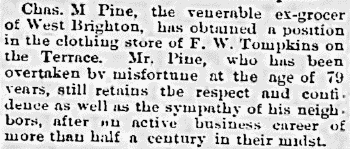
Chas. M. Pine, the venerable ex-grocer of West Brighton, has obtained a position in the clothing store of F. W. Tompkins on the Terrace. Mr. Pine, who has been overtaken by misfortune at the age of 79 years, still retains the respect and confidence as well as the sympathy of his neighbors, after an active business career of more than half a century in their midst.
— 04 Apr 1891, Richmond County Advance, West New Brighton NY, p4, nyshistoricnewspapers.org. View largest available size.
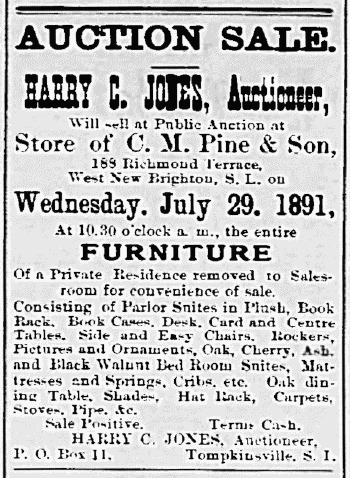
AUCTION SALE.
HARRY C. JONES, Auctioneer, Will sell at Public Auction at Store of C. M. Pine & Son, 188 Richmond Terrace, West New Brighton, S. I. on Wednesday, July 29, 1891, at 10.30 o’clock a. m., the entire FURNITURE Of a Private Residence removed to Salesroom for convenience of sale.
Consisting of Parlor Suites in Plush, Book Rack, Book Cases, Desk, Card and Centre Tables, Side and Easy Chairs, Rockers, Pictures and Ornaments, Oak, Cherry, Ash, and Black Walnut Bed Room Suites, Mattresses and Springs, Cribs, etc. Oak dining Table, Shades, Hat Rack, Carpets, Stoves, Pipe, &c.
Sale Positive. Terms Cash.
HARRY C. JONES, Auctioneer, P. O. Box 11, Tompkinsville, S. I.
— 25 Jul 1891, Richmond County Advance, West New Brighton NY, p7, nyshistoricnewspapers.org. View largest available size.

OBITUARY.
PINE.—Elmira J., wife of Charles M. Pine, died at her home in West Brighton on Monday, in her 77th year. Funeral services were held at the house on Wednesday. Rev. Dr. Brownlee and Rev. A. H. Demarest officiating, and the interment was in the family plot at the Moravian Cemetery. The exercises at the funeral were of a very interesting character, and it is worthy of notice that the two clergymen in attendance were pastors of the church of which Mrs. Pine had been a consistent member for nearly forty years, and were thus better than any one else able to speak of her religious life during that period. Dr. Brownlee based his address upon the words “There remaineth a rest for the people of God,” and spoke with the point, vigor, and earnestness which have always characterized his public utterances. He paid a feeling tribute to the work of the departed, and particularly referred to her patiences and submission in the midst of the severe sufferings which she was often compelled to undergo. Mr. Demarest followed with appropriate remarks based upon the words “For me to live is Christ, to die is gain.” Dr. Brownlee closed the services with a fervent prayer and benediction. Mrs. Pine was well known to a large circle of Christian and benevolent workers as one of the most active and zealous in the performance of duty. In the Ladies Aid Society of her own church she accomplished much good and was largely instrumental in gathering a large sum of money to be used toward the erection of a new Sunday School building. As one of the Managers for many years of the Old Ladies Home at Stapleton she was also highly esteemed for faithful work for the cause, and loving ministry to the inmates. She will be remembered and missed by many others toward whom she manifested kindly regard, and whose lives she sought to bless.
— 22 Mar 1892, Richmond County Advance, West New Brighton NY, p7, nyshistoricnewspapers.org. View largest available size.

Pine:—At West Brighton; S. I. Monday, March 8th, Elmira J. Pine, wife of Charles M. Pine, in the 77th year of her age.
— 12 Mar 1892, The Long Islander, Huntington NY, fultonhistory.com. View largest available size.
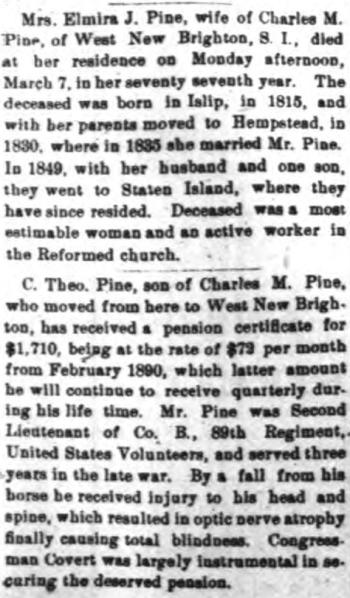
Mrs. Elmira J. Pine, wife of Charles M. Pine, of West New Brighton, S. I., died at her residence on Monday afternoon, March 7, in her seventy seventh year. The deceased was born in Islip, in 1815, and with her parents moved to Hempstead, in 1830, where in 1835 she married Mr. Pine. In 1849, with her husband and one son, they went to Staten Island, where they have since resided. Deceased was a most estimable woman and an active worker in the Reformed church.
C. Theo. Pine, son of Charles M. Pine, who moved from here to West New Brighton, has received a pension certificate for $1,710, being at the rate of $73 per month from February 1890, which latter amount he will continue to receive quarterly during his life time. Mr. Pine was Second Lieutenant of Co. B, 89th Regiment,. United States Volunteers, and served three years in the late war. By a fall from his horse he received injury to his head and spine, which resulted in optic nerve atrophy finally causing total blindness. Congressman Covert was largely instrumental in securing the deserved pension.
— Mar 1892, The Sentinel, Hempstead NY, p2, fultonhistory.com. View largest available size.
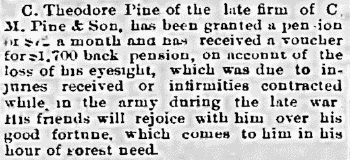
C. Theodore Pine of the late firm of C. M. Pine & Son, has been granted a voucher for $1,700 back pension, on account of the loss of his eyesight, which was due to injuries received or infirmities contracted while in the army during the late war. His friends will rejoice with him over his good fortune, which comes to him in his hour of sorest need.
— 12 Mar 1892, Richmond County Advance, West New Brighton NY, p4, nyshistoricnewspapers.org. View largest available size.

Archie Frary, at one time a popular clerk in the store of C. M. Pine & Son, but for over two years residing in Leavenworth County, Kansas, is paying a visit to relatives in Port Richmond.
— 11 Feb 1893, Richmond County Advance, West New Brighton NY, p4, nyshistoricnewspapers.org. View largest available size.
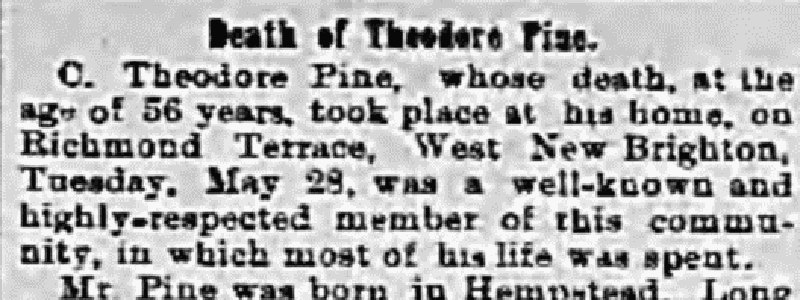
Death of Theodore Pine.
C. Theodore Pine, whose death, at the age of 56 years, took place at his home, on Richmond Terrace, West New Brighton, Tuesday, May 28, was a well-known and highly-respected member of this community, in which most of his life was spent.
Mr. Pine was born in Hempstead, Long Island, June 20, 1839. When he was 10 years old his parents removed to West Brighton, Staten Island (then known as Factoryville), where his father, Charles M. Pine (who still survives), established himself in the grocery and general merchandise business, the firm of which he was senior member being for many years the leading one in its line on the North Shore.
Theodore remained at Hempstead, and graduated from the Academy some three years later. For a long time previous to the winding up of the concern, which occurred a few years ago, the subject of this notice was associated with his father, under the firm name of C. M. Pine & Son, and earned for himself an excellent reputation as a sagacious, straight-forward man of business, and an energetic, public-spirited citizen.
Shortly after the breaking out of the civil war, Mr. Pine, with a number of Staten Islanders—among them our present Police Commissioner, Maj. Clarence T. Barrett—enlisted in Company I, 156th N. Y. Volunteers and served with his regiment, under command of Majors-General Banks and Canby. When the celebrated Corps d’Afrique was organized, Mr. Pine was offered a commission as lieutenant in a colored regiment, which he accepted, and, after the fall of Port Hudson, he was detailed on the staff of his brigade commander, serving first as Aide and afterward as Brigade Commissary. It was while filling the latter position that he was thrown from his horse, receiving injuries to the spine from which he never fully recovered, and which finally resulted in the total loss of his sight and in the brain trouble which for several years past left him perfectly helpless, and to which he at last succumbed. Since the date of his entire disability, he has been in receipt of a pension from the United States government for the injuries received in its service, and it is a great comfort to Mr. Pine’s many friends to know that during the sad years of his helplessness he was blessed by the loving care of a devoted wife and son, whose faithful, unwearied ministrations attended him to the last moment of life.
Mr. Pine was a deacon of the Reformed Church, Port Richmond, and for twelve years served as its Treasurer. He enjoyed the warm personal friendship of the late Dr. James Brownlee, who, up to the time of his death, manifested the liveliest interest in the condition of his friend, whose sad affliction evoked his warmest sympathy.
The funeral services were held in the Reformed Church, Port Richmond, yesterday, Rev. Mr. Demarest officiating, and were largely attended. Among those present were representatives of Richmond Lodge, F. & A. M., and James A. Rice Post, G. A. R., of which the deceased was a member. The interment was in the family plot in the Moravian Cemetery, at New Dorp.
— 01 Jun 1895, Richmond County Advance, West New Brighton NY, p4, nyshistoricnewspapers.org. View largest available size.
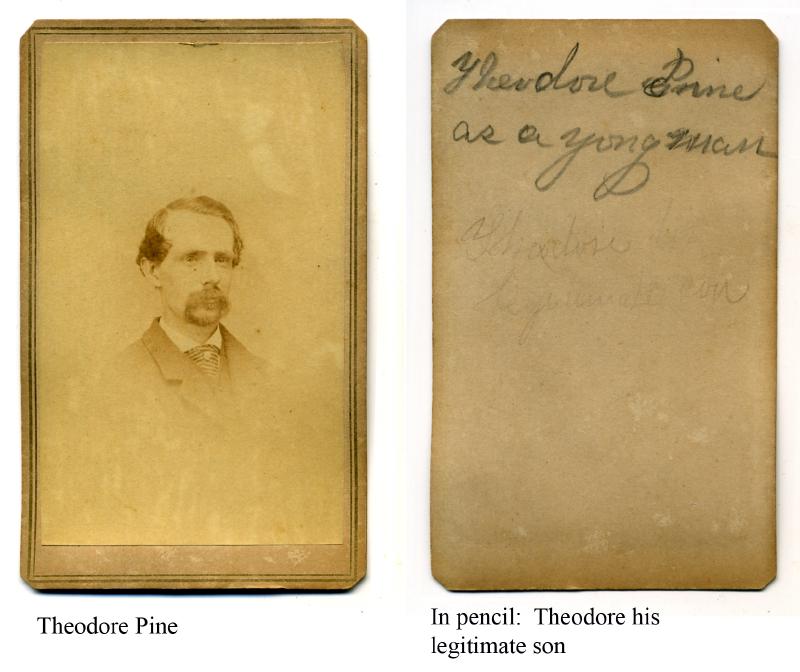
Theodore Pine
In pencil: Theodore his legitimate son
— Photograph and text provided by Martha Deed and used with permission. View largest available size.
The phrase “Theodore his legitimate son” may be understood in light of Alverade’s scandal.
For more information about Theodore’s time in the Civil War see Milton Loper’s Civil War Letters, below, which also mention Charles and Elmira Pine and indirectly reference Pine’s general store.
When Bartlett Brown Sr. completed his will on 23 October 1972, both of Charles M. Pine’s sons, Theodore and Alverade were his witnesses, and after his death, Alverade notes that he was “well acquainted with Bartlett Brown” having known him “for many years before his death.” Because Theodore died before Bartlett, fellow grocer Abram C. Hillyer, James A. Hillyer’s brother, was also called upon to verify Theodore’s signature, as Abram “was well acquainted with C. Theodore Pine, late of Castleton, Staten Island, and with his manner and style of writing, having often seen him write” (Wills, Vol 8-9, 1903-1906, Surrogate’s Court, Richmond County NY, ancestry.com).

PINE—At his late residence, Port Richmond, Staten Island, Charles M. Pine, in hie 86th year.
Funeral Sunday, October 10, at 2 p.m., from the Reformed Church, Port Richmond, Staten Island.
— 09 Oct 1897, The New York Daily Tribune, New York NY, p7, fultonhistory.com. View largest available size.
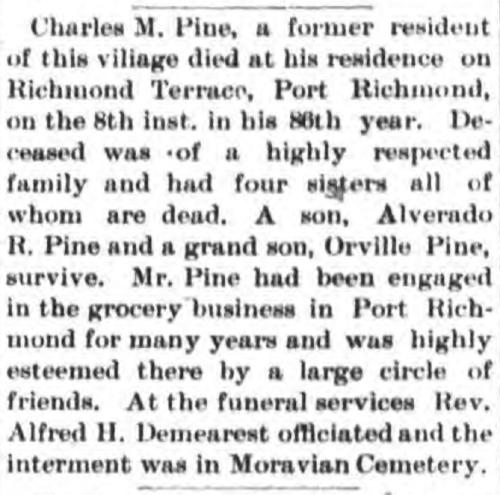
Charles M. Pine, a former resident of this village died at his residence on Richmond Terrace, Port Richmond, on the 8th inst. in his 86th year, Deceased was of a highly respected family and had four sisters all of whom are dead, A son, Alverado R. Pine and a grand son, Orville Pine, survive, Mr. Pine had been engaged in the grocery business in Port Richmond for many years and was highly esteemed there by a large circle of friends, At the funeral services Rev. Alfred H. Demearest officiated and the interment was in Moravian Cemetery.
— 21 Oct 1897, Queens County Sentinel, Hempstead NY, p1, fultonhistory.com. View largest available size.
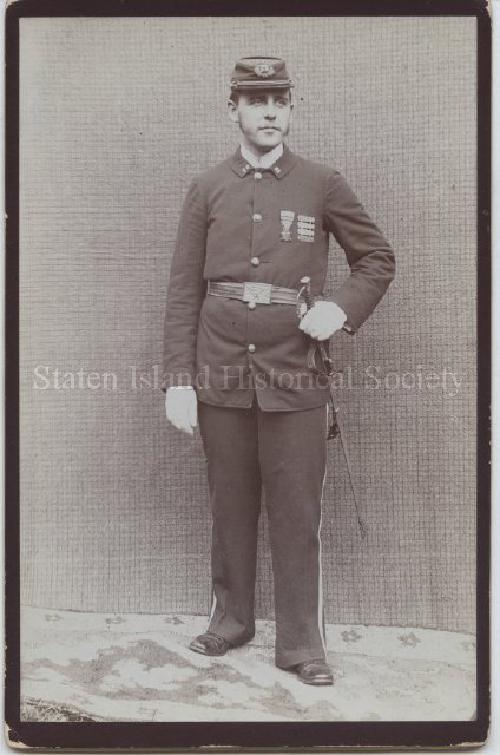
— ca. 1895-1905, Portrait of Orville B. Pine, Charles M. Steinrock Photographic Collection, Catalog Number 59.004.0034, Staten Island Historical Society, Historic Richmond Town, historicrichmondtown.org. View largest available size.
As I write this, the Richmond County Clerk makes deeds available online going back to the early 1900’s, and I found Orville Pine’s name among them.
Read more about the Pine family in the Hempstead section.
Interestingly, in the 1910 United States Federal Census, James Hillyer and wife Phoebe are renting a home on Cary Avenue on Staten Island, and James lists his occupation as “furniture salesman”, which is a bit inconsistent with his obituary below.

HILLYER.—Thursday, Feb. 5, 1914, suddenly, Phoebe A., Wife of James A. Hillyer, in her 80th year. Funeral services at Trinity Church, Prospect St., West New Brighton, on Saturday, at 3 P. M.
— 06 Feb 1914, The New York Times, New York NY, p9, newspapers.com. View largest available size.
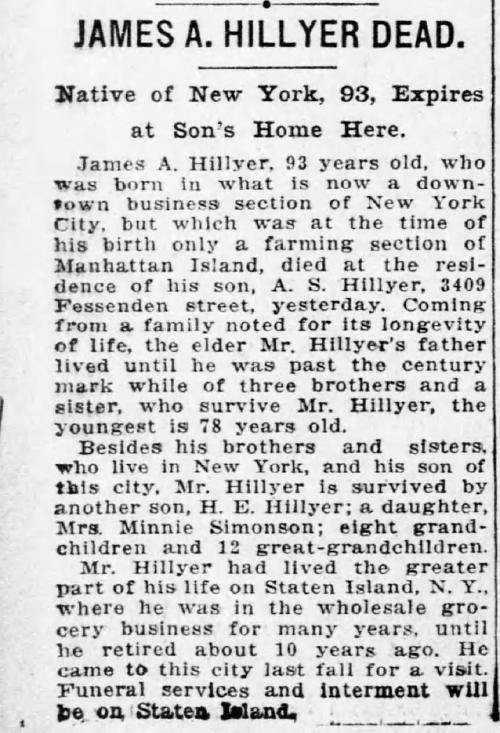
JAMES A. HILLYER DEAD.
Native of New York, 93, Expires at Son’s Home Here.
James A. Hillyer, 93 years old, who was born in what is now a downtown business section of New York City, but which was at the time of his birth only a farming section of Manhattan Island, died at the residence of his son, A. S. Hillyer, 3409 Fessenden street, yesterday. Coming from a family noted for its longevity of life, the elder Mr. Hillyer’s father lived until he was past the century mark while of three brothers and a sister, who survive Mr. Hillyer, the youngest is 78 years old.
Besides his brothers and sisters who live in New york, and his son of this city, Mr. Hillyer is survived by another son, H. E. Hillyer; a daughter, Mrs. Minnie Simonson; eight grand-children and 12 great-grandchildren.
Mr. Hillyer had lived the greater part of his life on Staten Island, N. Y., where he was in the wholesale grocery business for many years, until he retired about 10 years ago. He came to this city last fall for a visit. Funeral services and interment will be on Staten Island.
— 21 Mar 1925, The Evening Star, Washington DC, p32, newspapers.com. View largest available size.
Regarding your search, we do not have any identified images of the Pine store, the Bartlett Brown store or residence, or Edward H. Mills, unfortunately.
Charles M. Pine has direct descendants still living as I write this.
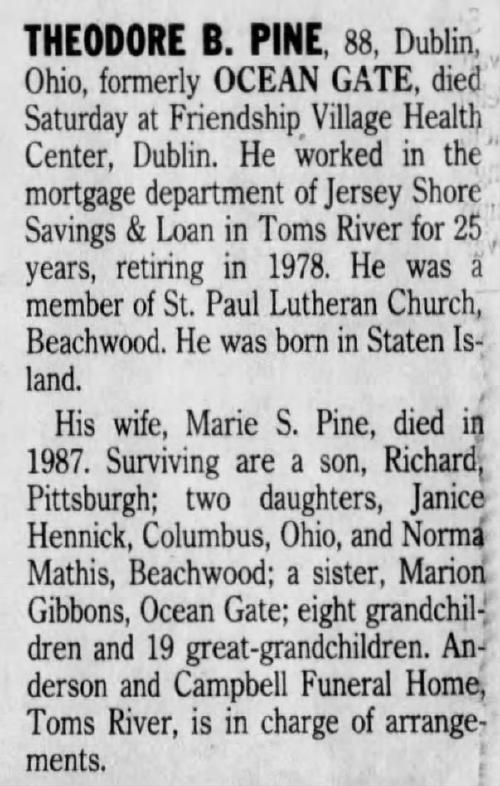
THEODORE B. PINE, 88, Dublin, Ohio, formerly OCEAN GATE, died Saturday at Friendship Village Health Center, Dublin. He worked in the mortgage department of Jersey Shore Savings & Loan in Toms River for 25 years, retiring in 1978. He was a member of St. Paul Lutheran Church, Beachwood. He was born in Staten Island.
His wife, Marie S. Pine, died in 1987. Surviving are a son, Richard, Pittsburgh; two daughters, Janice Hennick, Columbus, Ohio, and Norma Mathis, Beachwood; a sister, Marion Gibbons, Ocean Gate; eight grandchil+ dren and 19 great-grandchildren. Anderson and Campbell Funeral Home, Toms River, is in charge of arrangements.
— 27 Oct 1997, Asbury Park Press, Asbury Park NJ, p4, newspapers.com. View largest available size.
Milton Loper’s Civil War Letters
Martha Deed, the great-granddaughter of Juliett (Loper) Shepard (06 Jan 1845 to 02 Apr 1911), has done considerable work on her family history including transcribing many letters written to Juliett. The letters presented below were written by Juliett’s cousin Milton Loper while he fought in the Union Army in the Civil War, and within, Milton mentions Theodore Pine and the Pine residence on Staten Island, providing insight into the Pine family residence at that time, just a few years after Edward Mills’ family departed from Staten Island for Corfu.
“we have all three of us been exposed to immediate danger and have escaped. ought we not to be thankful to our heavenly Father. who alone hath preserved our lives?”
“Rogers proposes to meet me somewhere in New York, and go home together. I have named Staten Island as a substitute — won’t it be pleasant for us to meet there?”
“…time drags heavily to me now. that I am looking forward so anxiously to a time when I can go home. Why! Since the order came to muster us out, I have become almost homesick − But I think I shall survive…”
In the following letter to Juliett, Milton specifically mentions Charles M. Pine and alludes to Pine, Hillyer & Co.:
Camp of the 115th N.Y. Inft
Near Petersburg Va
Sept 21st 1864Cousin Juliett
There is one thing I forgot to mention in my last to you so for fear I may forget again, and the thought not return in season to be of any benefit I write this soon. I am well aware too. that when you peruse this, you will think strange that I do not write to Uncle Charles instead of you. My reply to this is. That I prefer writing to those I have reason to believe are at home rather than to those whome I know are absent. I wrote to Uncle requesting him to order a pair of boots for me. Very soon after. I concluded that a small hatchet − (one that I can carry in my waist belt.) would be very convenient, and intended to ask you to mention it to him. but forgot until now. So I now wish you would be so kind as to say to Uncle. that I would like very much to have him send me such a hatchet. as I have described. Send it when he does the boots −I would like one that I can draw nails with and want it sharpened . for I can’t find any thing here to sharpen my knife even. Now that the business part of my letter is finished. I will devote the remainder of this sheet to something that may be more interesting.
— From Civil War Letters: Luther Milton Loper to Juliett Loper, Staten Island References, Excerpts from letters, compiled by Martha Deed. Provided by Martha Deed and used with permission.
The belts provided to the Union soldiers as part of their uniform were mass produced and so, nearly identical across the Army. Milton, Rogers, and Theodore would all have worn a belt very similar to the belt found within the walls of Mills' Home in Brooktondale.
The following text was provided by Martha Deed and is reproduced here with her permission. This text is also publicly available through the New York Military Museum, as Martha donated it along with an Army photograph of Charles Theodore Pine, also shown further below.
References to Charles Theodore Pine and to Jarvis Rogers Loper in Luther Milton Loper’s letters to Juliett Loper
Compiled by Martha Deed May 11, 2015
Luther Milton Loper (1837-1865) had two close male relatives in the Civil War: Jarvis Rogers Loper (1835-1883) was his older brother, and Charles Theodore Pine (1839-1895) was his first cousin. He referred to them frequently in his letters to his first cousin, Juliett Loper.
Note that members of the family were often called by their middle names. Thus, Luther (named after his paternal grandfather) was “Milton,” Jarvis Rogers was “Rogers,” and Charles Theodore Pine (named after his father) was “Theodore.”
Milton, Rogers, Theodore and Juliett were all grandchildren of Luther Loper (1780-1856) and Sarah Bishop Loper (1786-1870). Jarvis Rogers and Luther Milton’s father was their son, Isaac; Juliett’s father was their son, Erastus; and Theodore’s mother was their daughter, Elmira.
Luther Milton Loper enlisted at Saratoga Springs, New York in August 1862, Charles Theodore Pine enlisted at Castleton, Staten Island, New York in August 1862, and Jarvis Rogers enlisted in the Rhode Island Volunteers (date unknown).
Milton mentions Rogers and Theodore and the Pine family with some frequency in his letters to Juliett, including the following:
You say Theodore was thinking about enlisting. So it seems we were both thinking of it at the Same time. and I for one decided to enlist. and did. on 6" August. left the state of N.Y. the 21‘. went to Harper’s Ferry. .. Rogers is also in the Army. though not in the same Regmt that I am. . .
Please write soon and let me know whether Theodore is in the Army. Your loving Cousin, Milton Oct 22/62
Roger’s address is J. R. Loper, Co “I”, 2" R.I.V. Washington D C
Dec 25/62
Since I received your letter I have received one from Aunt Mary (Smith). She wrote that Theodore was with Banks Expedition, and that the boat he was in. grounded on the Florida Reefs, but he escaped unhurt. . Rogers was in the Battle at Fredricksburgh and he was unhurt. so you see we have great cause to be thankfull. we have all three of us been exposed to immediate danger and have escaped. ought we not to be thankful to our heavenly Father. who alone hath preserved our lives?
Jan 7/63
I have not yet received a letter from Auntie Pine [Charles Theodore Pine’s mother]. I wish she would write.
May 10/63
I don’t know what Rogers. could find to write about. in order to fill 9 pages. I guess he must keep a journal.
Jul 13/63
I am obliged to you for sending Theodore’s address. I think I shall write to him. . . How in the name of common sense, Rogers could think of enough to fill nine pages, I can’t see. By the way, I received a letter from Helen, in which she stated that Rogers, wrote that his Regt was ordered to march on to Gettysburgh[sic]. I had not heard from him since. So of course did not know whether he survived to battle or not. She wrote that the papers state that his Regt lost in killed -45. I am quite anxious to hear from him
Aug 2/63
I have at last concluded to have my photograph taken, and this is the reason I write now so as to send one to you before they get damaged, for I have no convenient place for keeping them. I also inclose [sic] one for Auntie Pine. which you will please send to her. with my compliments.
Aug 21/63
I wrote to you last week and sent you two of my photographs, one for you, and the other for Auntie Pine, which I hope may reach their destination safely. Rogers is acting Brigade Hospital Steward, So he and Theodore are both in good and comfortable situations, better off than I am. . .
Aug 28/63
I sent two of my photographs in the letter, one of which I of course intended for you. the other was for Auntie Pine. I hope you will get yours all right. I did receive the letter in which you requested me to direct to Staten Island, but forgot to do so. I will try to direct this one right.
Sep 15/63
Note: Pine family lived on Staten Island.
Rogers is in Virginia somewhere. The letter I received from him yesterday was mailed from Alexandria, but his address is, Washington. D. C. as before, or in other words, it is Mr. J. R. Loper. Co. 9 2 R.I. Vols., Washington, D. C.
Oct 2/63
I am glad to hear that Grand Ma’s [Sarah Bishop Loper] health is better. than when you last wrote. and that Theodore is rising in the world.
Nov 19/63
Note: Reference may be to Theodore being promoted to 2nd Lt. and joining U.S. Colored Troops in October 1863.
I suppose Theodore enjoyed himself more at that dinner party. than I would have done. could I have had the privalige [sic]. for I am not very social, which you perhaps well know. . . Rogers wrote that He. had just received a letter from Cousin Mary G[?]. Buffet. He said he dreaded to answer the letter, but could not very well get around it.
Jan 7/64
I would like to write to Theodore. but have forgotten his address. please give me it again. and I will copy is so that I can write whenever I have an opportunity. I wrote to him about the first december last but did not direct as you told me but guessed at his Address– and now. I guess. that I didnt guess right. this was before you sent his address
Feb 10/64
I found a letter there for me from Theodore, which surprised me somewhat. It was written the 2™ of April. He was well at the time.
May 27/64
Rogers is now Hospital Steward. And gets 30$ per month. And [illegible]. So he is above me now, and will be I suppose until I get a Commission. He has been more fortunate than I have, he went into an old Regt as a recruit so of course did not stand so good a right for a promotion as if he had enlisted with the Regt but he has worked his way to a very good and admirable position. I went into the service a Sergt and am only first Sergt yet.
Jun 27/64
I hope Theodore is well by this time. Patients in Hospital do not get the “best of care.” as one would conclude after reading the papers.
Aug 16/64
I received a letter from Roger to night. He is near Harper’s Ferry and say they have to change their position quite often.
Sep 19/64
I think it will be as well for Theodore to remain at home now. that is. after he gets there. which I hope he will do soon. After one has been in the service two or three years. I think he has done his share. though if he is really anxious to do more I am willing he should. but shall not advise him to.
Oct 14/64
I received a letter from Brother Rog. the other day. It seems He conducted himself in such a manner. during Sheridan’s operations in the “Valley” (in his capacity of Hospital Steward of course) as to fain the approbation of the Div Surgeon who subsequently was appointed Inspector (Judicial) and took Rogers with him in the office to do his writing, which Rog says he finds very easy and comfortable position. He is at Winchester, Va. and says he owes his position. to his attending to his “Biz” while in the field.
Nov 6/64
I recd.. one a few days later from Rogers written the same day. He was well and so well pleased with his situation. that he thinks of going into the regular service. If he was in my place. here at the front. obliged to get up at four and five oclock every morning and stand in line of battle until day light. besides being routed out and midnight about twice every week. He would not be so fast for continuing in the service.
Nov 21/64
Rogers proposes to meet me somewhere in New York, and go home together. I have named Staten Island as a substitute — won’t it be pleasant for us to meet there?
May 19/65
Rogers has some peculiar notions about some things and it may not suit his convenience to meet me on S. I. [Staten Island] so I have written him that I will meet him wherever he directs.
Jun 5/65
— 11 May 2015, References to Charles Theodore Pine and to Jarvis Rogers Loper in Luther Milton Loper’s letters to Juliett Loper, compiled by Martha Deed.
Milton Loper’s Army photograph, presumably the same one he mentioned having taken in Aug 1863:

— Provided by Martha Deed and used with permission. View largest available size.
At least two known photographs of Theodore survive, including his Army portrait, donated to the New York Military Museum by Martha Deed:
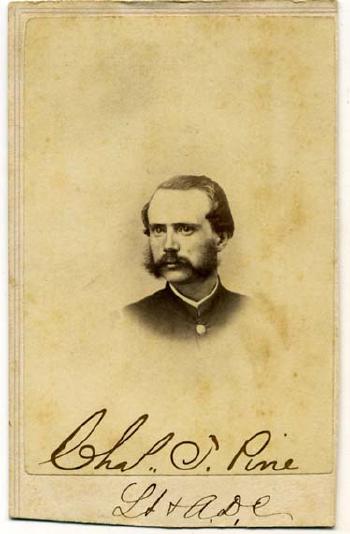
Chas. T. Pine
Lt & A.D.[?].
— 1864 Carte de Visites of Charles Theodore Pine, New York Military Museum, Photo Number PA.2015.0212, donated by Martha Deed. View largest available size.

Guay & Co.
No. 75 Camp Street,
New Orleans.
— 1864 Carte de Visites of Charles Theodore Pine, New York Military Museum, Photo Number PA.2015.0212, donated by Martha Deed. View largest available size.
Martha provided the following additional context to the photograph:
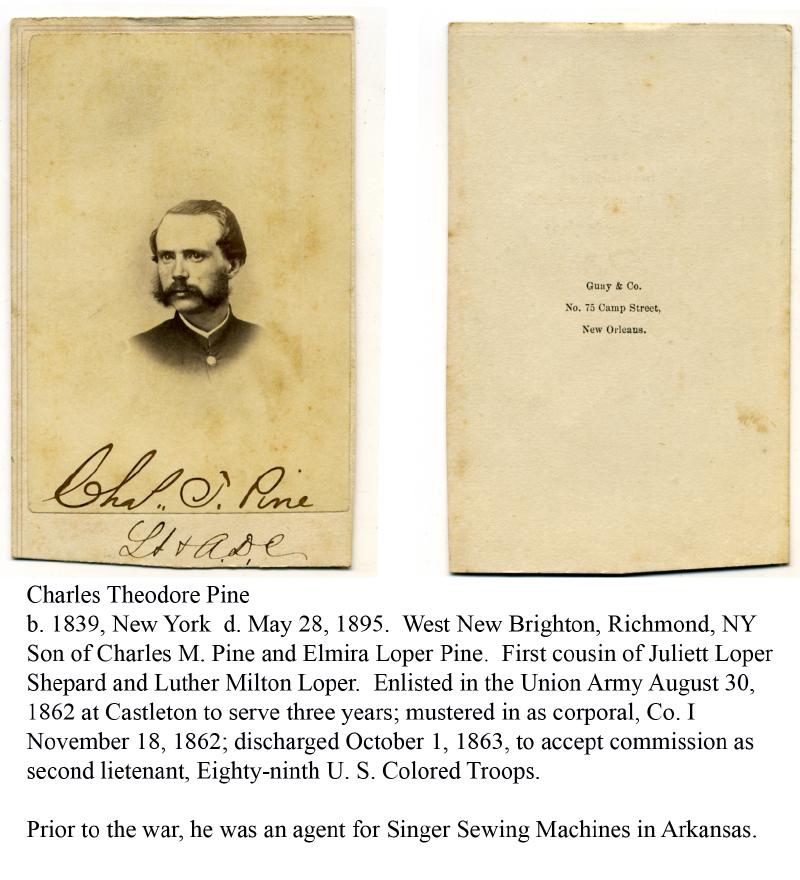
Charles Theodore Pine
b. 1839, New York d. May 28, 1895. West New Brighton, Richmond, NY Son of Charles M. Pine and Elmira Loper Pine. First cousin of Juliett Loper Shepard and Luther Milton Loper. Enlisted in the Union Army August 30, 1862 at Castleton to serve three years; mustered in as corporal, Co. I November 18, 1862; discharged October 1, 1863, to accept commission as second lietenant, Eighty-ninth U. S. Colored Troops.
Prior to the war, he was an agent for Singer Sewing Machines in Arkansas.
— Photograph and text provided by Martha Deed and used with permission. View largest available size.
Martha has an additional portrait taken after the War that shows “Theodore Pine as a yong man”:

Theodore Pine
In pencil: Theodore his legitimate son
— Photograph and text provided by Martha Deed and used with permission. View largest available size.
Based on similar characteristics of Theodore’s two photographs, the second was taken perhaps only a few years after the Army portrait, possibly when Theodore was in his late 20’s or early 30’s.
The head post was most popular in the early 1860’s, usually treated with a vignette look, with the area around the head feathered or gradually fading away. The image area in these head poses was quite small, due to camera and lens technology at that time. The camera was usually 12 or more feet from the subject, and the concept of telephoto or zoom did not exist.
— 2013, Gary W. Clark,19th Century Card Photos KwikGuide, p22, phototree.com.
Nearly all pre-1863 cards have no border. Even though borders first appeared in 1862 (usually hand drawn) this style was not widely used until 1864. … The first commonly used borders usually consisted of two thin gilt lines of the same width. These have only been found on documented 1863 and 1864 cards. Beginning in 1864, nearly all documented cards, especially the vast number with tax stamps, have two gilt lines, but the outer line is considerably thicker that the inner line. This dual-width style of border remained almost unchanged until about 1869.
— 2013, Gary W. Clark, 19th Century Card Photos KwikGuide, p18, phototree.com.
Milton mentions Theodore’s hospital stay, and as already discussed above, it was not long after Milton wrote that “Theodore is rising in the world” due to his promotion to 2nd Lieutenant, that Theodore fell from his horse, injuring his spine, which also affected his eyesight. He never fully recovered from these injuries, which as stated in his obituary, “finally resulted in the total loss of his sight and in the brain trouble which for several years past left him perfectly helpless, and to which he at last succumbed.” Comparing his Army portrait with the studio portrait taken perhaps just a few years later, his gaze does seem to have a different quality.
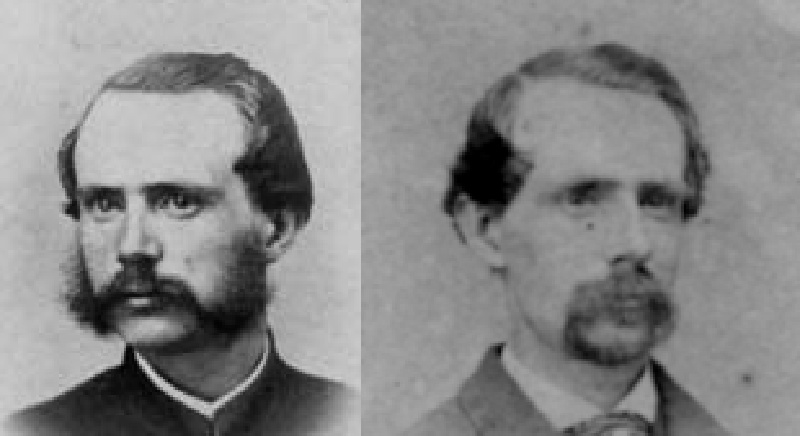
Milton Loper’s letters to Juliett as well as other family letters referencing Staten Island make it clear what the census records suggest: that in addition to boarders that commonly included employees of Pine, Hillyer & Co., the residence of Charles M. and Elmira Pine in West New Brighton was visited often by close and extended family members, and Juliett and Milton write about meeting at Staten Island with warmth and excitement. And the nieces and nephews seemed to regard Elmira with especial affection, as they always refer to her as “Auntie Pine”, as compared to “Aunt Mary (Smith)” for example.
Contrasted with Rogers’ eventual position as hospital steward, Milton describes long days battling on the front lines, at times ending in retreat. Fortunately, Milton survived the battlefield, and as his regiment was mustering out at the end of the war, he wrote his last two letters to Juliett “from the South” in which he expresses his longing to see her in Staten Island.
Raleigh N C May 19/65
Dear Cousin
Your long letter written sometime this month came to hand this morning. And to make amends for past neglect, I reply immediately. If you did not get a letter from me after Feb 17th until that one I wrote after taking Raleigh, it was not my fault but the fault of the mail carriers for I wrote at least two and I think three letter in that time. I wrote one while in camp near Wilmington from which place I also sent you a paper called the “Herald of the Union” printed in Wilmington which I suppose you did not receive as you never mentioned it. I think I wrote again while near Goldsboro on or about the 22 March. and again while at Rockfish Creek. Bridge on the Wilmington and Weldon RR about 95 miles from the former place. So you must not go back on me because you did not get them. I am surprised that Uncle Manning should sell his beautiful place. What do you sat to our making them another visit?
I am anxious to get home even if there is to be no more fighting. For I want to see him. It will seem to be free once more. It is rumored that we are to be mustered out before our term of service expires. I hope so and then I flatter myself in having a few weeks recreation at Staten Island, New Brunswick, Hempstead and Saratoga and then I shall be homeward bound. Rogers proposes to meet me somewhere in New York, and go home together. I have named Staten Island as a substitute – won’t it be pleasant for us to meet there? I may make Uncle Samuel a visit but have not decided. It is raining and I hope it will rain all day – cause why? So I shall not have to drill. I hate these drills and inspections now the war is over and the fewer of them I have to do with the better.
I am glad you were pleased with Burty. I would like very much to have you go there with me if Auntie Pine can spare you when I return. How would you like it?
I will close now so good bye
Yours as Ever
L M Loper
Co. G 115 N Y V
Raleigh, N C
— Provided by Martha Deed and reproduced here with permission.
Raleigh N.C. June 5/65
My Dear Cousin
Yours of May 29th came this morning, and was read with pleasure, and this my answer, is in all probability my last letter to you from the South at least. until after I have again tasted the sweets of freedom. I long to be free, and in order to become so, I refuse to accept of a 1st Leutnt Commission, that is. to muster as such, for three years – My appointment is here – and the Commission will be soon. I recd.. a copy of the N Y Times from you. a few days ago and thank you for it. I like to get reading matter for time drags heavily to me now. that I am looking forward so anxiously to a time when I can go home. Why! Since the order came to muster us out, I have become almost homesick − But I think I shall survive. so don’t be alarmed. I hope GrandMa will enjoy her visit to Hempstead, and also, that we shall enjoy ours. Gertrude I understand has broken up house-keeping. How that will affect our visit I do not Know. but I guess it will not interfere with it, though it may not be so pleasant to us, as though she were keeping house. I know that I shall not enjoy myself so well and consequently shall not stay so long, but will try to enjoy the visit while I do stay. Rogers has some peculiar notions about some things and it may not suit his convenience to meet me on S. I. [Staten Island] so I have written him that I will meet him wherever he directs. I have had an invitation to visit Aunt Mary and Nancy Smith and Buffet and I think I will accept. If I go to Josie you must go with me. If you will that is of course. I do not mean to dictate to you. I have enough of that here in the army. I shall be glad when I can get where I can get what I want from others, without saying you must do so etc etc and I shall be joyful beyond measure, when I can feel and know that no human being has the right to say to me You must do this, or you must do that – and the sooner that blessed time arrives the better.
There is to be a great exactment at Saratoga on the 4 Jul and Gen Grant is expected to be there. I hope that we may be there to see the “elephant.” Leut Geary has come and now we have to get to work at the muster out rolls again.
Yours as Ever
L M LoperPS an officer just came from HeadQuarters with orders for us to suspend operations until next week – Then they will muster our Regt out – there is something wrong about the rolls – Well I suppose I must live in hope awhile longer. L.M.L.
— Provided by Martha Deed and reproduced here with permission.
Martha Deed provided the following images of the letter immediately above:
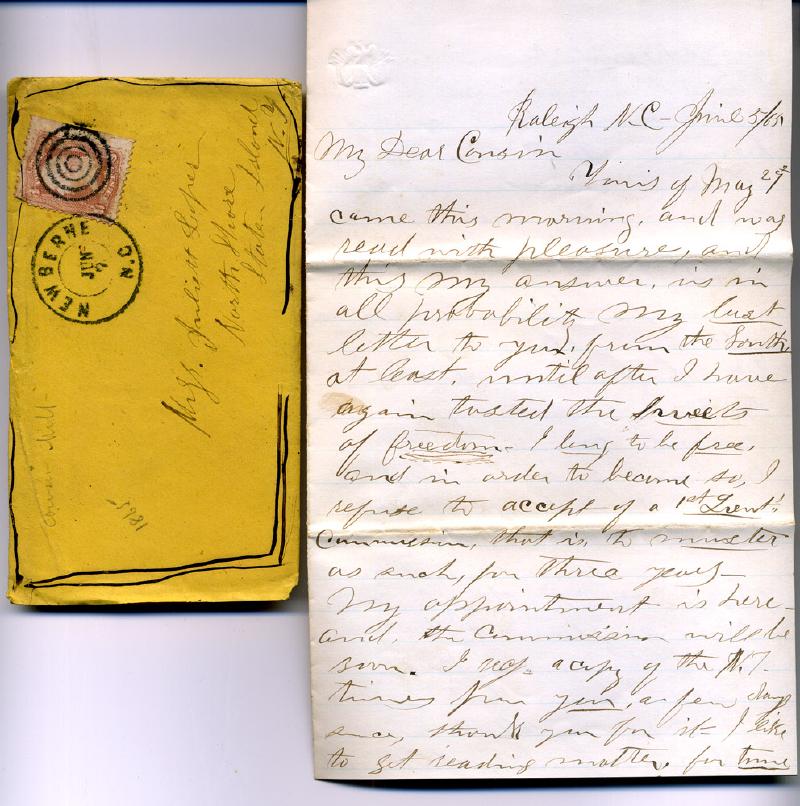
— Provided by Martha Deed and used with permission. View largest available size.
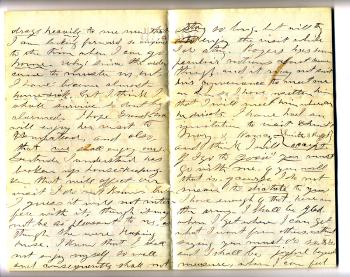
— Provided by Martha Deed and used with permission. View largest available size.
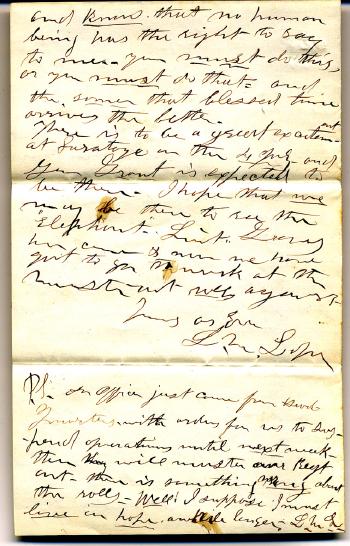
— Provided by Martha Deed and used with permission. View largest available size.
From the handwriting, it was obvious that Milton was seriously ill.
— 13 Nov 2023, Martha Deed, personal correspondence.
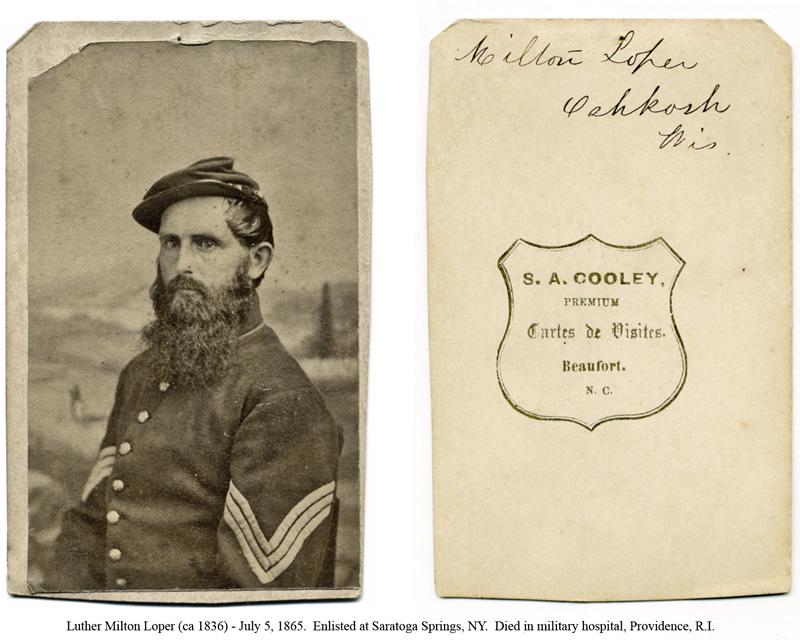
Luther Milton Loper (ca 1836) - July 5, 1865. Enlisted at Saratoga Springs, NY. Died in military hospital, Providence, R.I.
— Provided by Martha Deed and used with permission. View largest available size.
While Theodore Pine’s photograph was taken in officer’s uniform and clearly in a studio, Milton’s was taken on the battlefield and he looks very worn. He did not die in the War exactly. As I worked my way through transcribing his letters to Juliett, I took them in chronological order, and so I did not know what happened to him – which was really difficult when I reached his last letter after several years of work on the collection.
The plan was to meet at the Pine house in Staten Island for a family reunion. Milton did not make it. He was placed on a hospital ship and taken to Portsmouth Grove Civil War hospital just outside of Providence, RI and died there of typhoid fever July 4 or 5,1865. He spent three years in the Union Army and never made it home. He was buried on the hospital grounds, but his body was later moved to a Cypress Hills Civil War cemetery in Brooklyn – as documented by a plaintive letter from his father, Isaac Loper, to Rhode Island officials in 1868. I visited Cypress Hills and took the attached photo.
Odd note about that hospital: I later learned that three distant cousins of mine served as nurses at that hospital. I have a photo of one of them, Ada Brewster, taken while she worked there. Ada Brewster was an artist and my very distant connection to her is on my father’s side of the family, while the Lopers are on my mother’s side. The paternal relatives and the Brewsters were very close associates though not close genealogically, which is how I found the Brewsters. I’ve wondered if Luther and the Brewster sisters ever met.
— 11 Nov 2023, Martha Deed, personal correspondence.
Oshkosh, Wisconsin, June 23/68
Mr. George H. StewartDear Sir
I wrote a letter some time ago. . . I have had no response to it. . . I lost a son in the Army & he was buried at Portsmouth Grove, R.I. The government as I notice has been moving some of the bodies. . . If you will be kind enough to inform me whether they have moved all or intend to move all & break up the cemetery there, I will be truly obliged to you. My sons name was Luther M. Loper.
Yours with respect
Isaac Loper
— Text provided by Martha Deed and used with permission. For more context, see 2012, Rhode Island’s Civil War Hospital: Life and Death at Portsmouth Grove, 1862–1865 by Frank L. Grzyb.
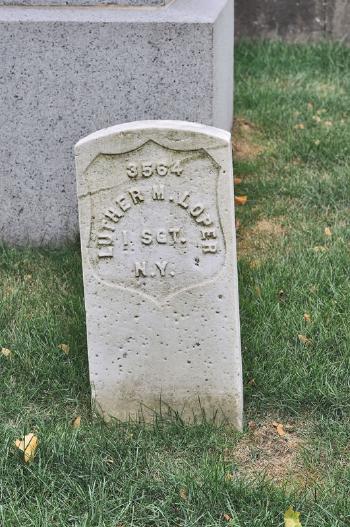
— Luther Milton Loper, Cypress Hills National Cemetery, Brooklyn, NY. Provided by Martha Deed and used with permission. View largest available size.
Martha Deed wrote the following poem based on Milton’s final letter to Juliett.
Mustering Out 5 June 1865
Martha Deed
It is Spring now – finally
and I am writing my last letter to you –
from the SouthA private letter – like
all the others I have written –
to you – and I have burnedYour letters – to keep
them private, too –
except in memoryI long to be free again –
Soon I will – I think –
My hand shakesas I pen this to you –
I may be sick –
But I don’t tell you thisThe War –
All that stood between you
and me – is over now“I shall be joyful
beyond measure
when I can feeland know
that no human being
has the rightto say to me
‘You must do this’
‘You must do that’Time drags heavily to me now
but I think I shall survive
so don’t be alarmed.”
— 2021, Martha Deed, “Mustering Out 5 June 1865” from Under the Rock, Foothills Publishing.
Under the Rock is Martha Deed’s second FootHills Publishing collection. Her first, Climate Change, was released in 2014.
Her poetry has been published in dozens of journals, including Shampoo, Moria, Unlikelystories, CLWN WR, Le Mot Juste, Edifice Wrecked, Big Bridge, and Earth’s Daughters. Her work has been included in FootHills anthologies, including Birdsong and Coast to Coast: The Route 20 Anthology as well as anthologies published by Iowa, Mayapple, Red Hen, Xexoxial, Beatlick Press and others.
After I read another of Martha’s works, a family history called The Kingston Mystery, and I followed up on a reference to Leyden Holland (p5), where the Reverend John Robinson, Pastor of the Pilgrim Fathers, was exiled, Martha and I discovered that we are distant cousins, sharing the common ancestor Ruth Alden (28 Nov 1634 to 12 Oct 1674). Ruth’s father, John Alden (06 Jul 1598 to 12 Sep 1687), had sailed on the Mayflower as a crew member.
Cooper: John Alden. Alden was a 21-year-old from Harwich in Essex and a distant relative of Captain Jones. He hired on apparently while Mayflower was anchored at Southampton Waters. He was responsible for maintaining the ship’s barrels, known as hogsheads, which were critical to the passengers’ survival and held the only source of food and drink while at sea; tending them was a job which required a crew member’s attention. Bradford noted that Alden was “left to his own liking to go or stay” in Plymouth rather than return with the ship to England. He decided to remain.
— List of Mayflower passengers, Wikipedia.org.
John Alden’s descendants eventually married descendants of Reverend John Robinson.
Early 2000’s Images of Pine, Hillyer & Co. Building
What is to my knowledge the only surviving photograph of the residence of Charles M. and Elmira Jane Pine in Staten Island shows the side of C. M. Pine & Co., the grocery and dry goods store that Charles M. Pine ran with his son Theodore. Before Theodore joined the business, it was known as Pine, Hillyer & Co. at the same location, in partnership with James A. Hillyer.

— ca. 1895, Pine Residence, Charles M. Steinrock, Catalog Number PH01.1599, Staten Island Historical Society, Historic Richmond Town, historicrichmondtown.org. View largest available size.
As I write this in late 2023, the Richmond County Clerks office in Staten Island does have digitized records searchable online, but only going back to the early-mid 1900’s. Despite this, I think I can confidently show that the store building whose side is shown in the Pine residence photograph still exists in active use as I write this.
The most detailed maps I have seen of the properties of Staten Island of the 1800’s are the Sanborn Fire Insurance maps, created a decade before the Pine residence photograph was taken, that shows the residence and “Gro. & Gen’l S.”

— 1885, Sanborn Fire Insurance Map from Staten Island Borough Of Richmond, Richmond County, New York. Sanborn Map Company, Jul. [Map] Retrieved from the Library of Congress, https://www.loc.gov/item/sanborn06213_001/, p20, cropped. View largest available size.

— 1885, Sanborn Fire Insurance Map from Staten Island Borough Of Richmond, Richmond County, New York. Sanborn Map Company, Jul. [Map] Retrieved from the Library of Congress, https://www.loc.gov/item/sanborn06213_001/, p1, cropped. View largest available size.
The Sanborn map confirm what is captured in the Pine residence photograph. Pine’s store is a 3 story red brick structure, with windows on the alley wall on all three floors toward the front, with three more windows on the ground floor behind those. Also visible is the wood cornice on the storefront that is indicated in the Sanborn map, as well as the side of the shed in the rear of the store next to the stables.
Finally, note that Pine’s store is slightly trapezoidal, matching the curve of Richmond Terrace at that point. All of these are corroborated by contemporary Google Maps photographs taken from Sep 2007 to Oct 2022, at both street level and aerial views.

— 20 Jan 2023, screenshot of West New Brighton streets, Google Maps. View largest available size.
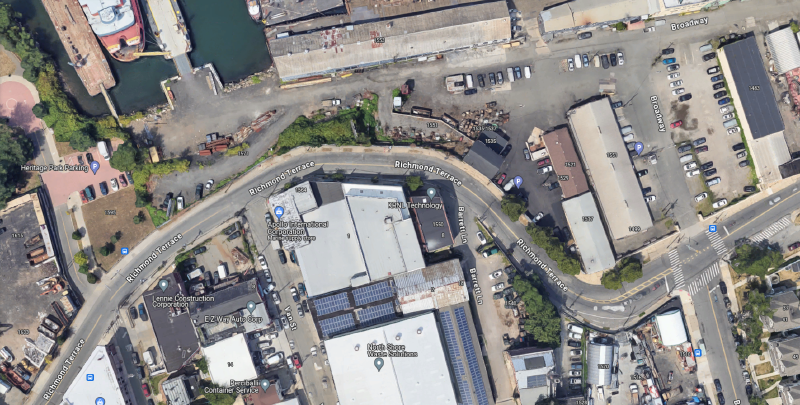
— 2022 October, Staten Island, NY, Google Maps. View largest available size.

— 2022 Oct, Staten Island, NY, Google Maps. View largest available size.

— 2022 Oct, Staten Island, NY, Google Maps. View largest available size.
A similar shape is not present in the Beers maps from 1874, although these maps are much less detailed in general.

General Store of Pine Hillyer & Co.
C. M. Pine
— Lionel Pincus and Princess Firyal Map Division, The New York Public Library. “Atlas of Staten Island, Richmond County, New York, from official records and surveys; compiled and drawn by F. W. Beers” The New York Public Library Digital Collections. 1874. Cropped. https://digitalcollections.nypl.org/items/510d47e2-0b93-a3d9-e040-e00a18064a99. View largest available size.
And from street level, the building’s angle is much less apparent.

— Oct 2022, Richmond Terrace and Barrett Lane, Staten Island NY, Google Maps. View largest available size.

— Oct 2022, Richmond Terrace and Barrett Lane, Staten Island NY, Google Maps. View largest available size.

— Oct 2022, Richmond Terrace and Barrett Lane, Staten Island NY, Google Maps. View largest available size.
Matt Long is a recent former owner of the property and has confirmed that the building is indeed the same that housed Pine’s store.
Adam asked:
“To your knowledge, is the structure that is there presently the same one that would have housed the grocery store in the mid-late 1800’s? (I am not local, so my ability to research the deed history remotely is limited.)”
Matt replied:
“Yes, it is indeed still the original structure.
…When I moved into ‘The Terrace’ There was nothing around it. The Apollo building next door was an empty lot that was the one time location of The Swan Hotel (check the name) where I was told Aaron Burr spent his last years convalescing. There was no heat, electricity or water. I used a wood stove to warm the place…poorly! It was too big a space for a wood stove to be effective. I knew Claire Brown’s son and had several conversations about the property with the Staten Island Historian… A Mr. Williamson and late on his successor Barnett Shepherd.”
— 06 Dec 2023, Matt Long, personal correspondence.
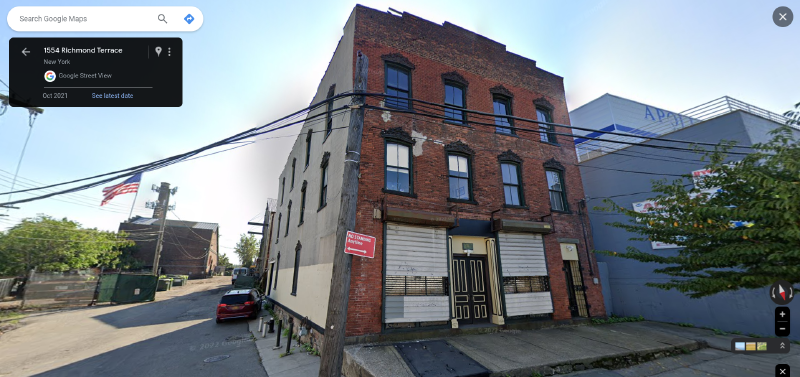
— 2021 Oct, Staten Island, NY, Google Maps. View largest available size.
Adam asked:
“I am assuming the two areas on either side of the front door were display windows, is this theory compatible with what you know of those spaces?”
Matt replied:
“Absolutely. I reconstructed the windows as they were and surely the display/window seats are still there.”
— 06 Dec 2023, Matt Long, personal correspondence.
Closer images clearly testify to the age of the bricks and evidence of recent repair work can be seen in some images, where there is white patching. Notice too that the bricks encompassing the third story windows on the front face of the building appear to be a distinctly different color than the bricks around it, suggesting they were replaced at a later time.
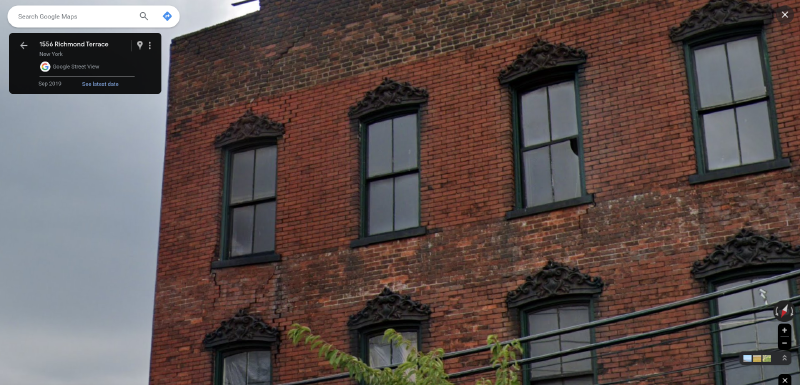
— 2019 Sep, Staten Island, NY, Google Maps. View largest available size.
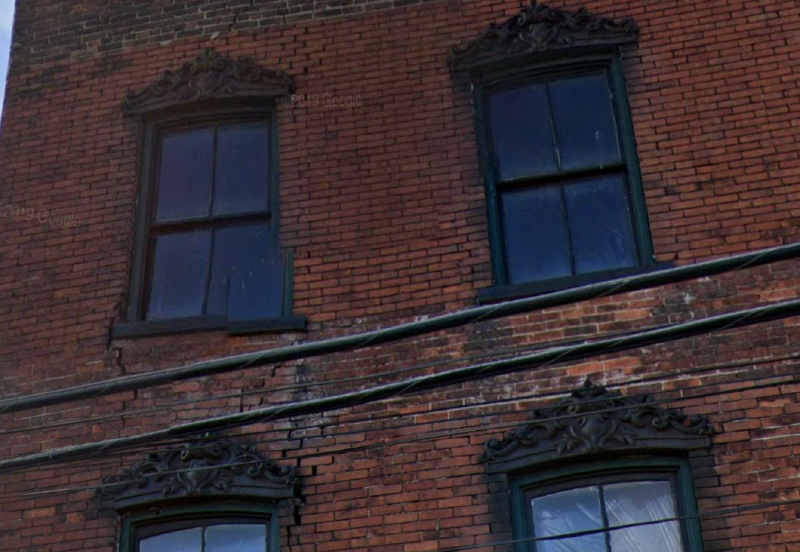
— 2019 Sep, Staten Island, NY, Google Maps. View largest available size.
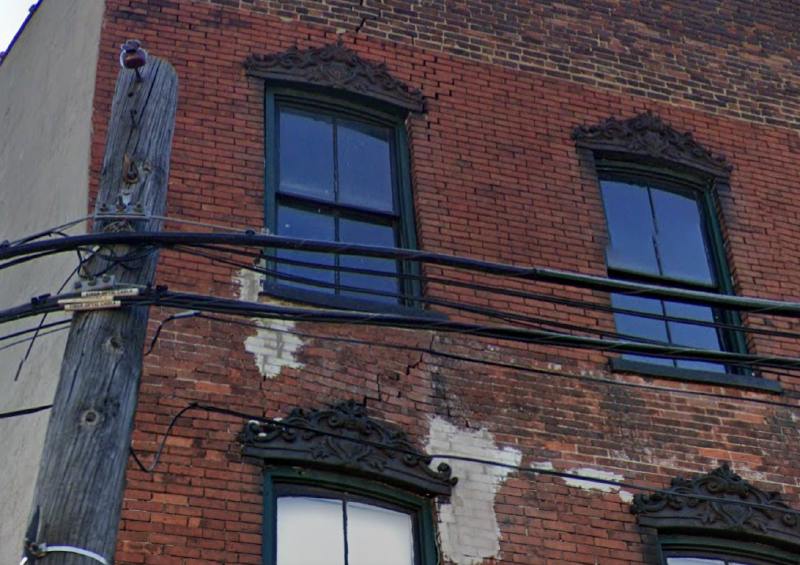
— 2022 Oct, Staten Island, NY, Google Maps. View largest available size.
Adam asked:
“At the rear of the building on the east side, there appears to be a large door that I assume opens to a loading area. Given your knowledge of the building, was that likely there in the 1800’s as well, and for that purpose?”
Matt replied:
“Yes. The loading dock was quite obviously original to the building.”
— 06 Dec 2023, Matt Long, personal correspondence.
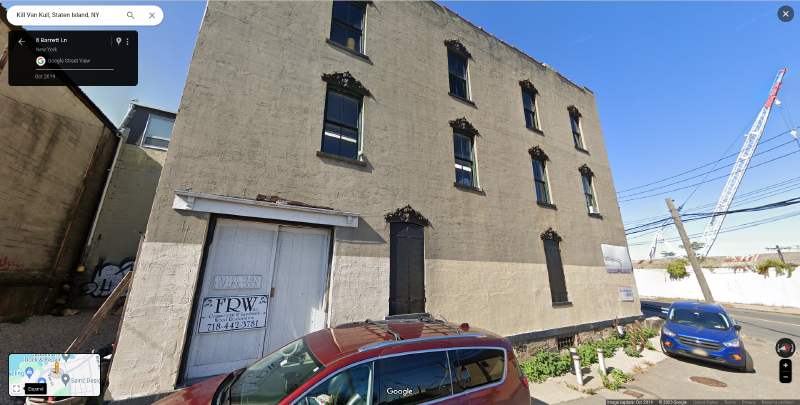
— 2022 Oct, Staten Island, NY, Google Maps. View largest available size.

— 2022 Oct, Staten Island, NY, Google Maps. View largest available size.
Adam asked:
“There are two features of the building’s face that might indicate past work done, and I was wondering if you knew anything about them: on the east side, facing Barrett Lane, there is a distinct line in the middle of the second floor where the exterior color changes, do you know anything about that? Similarly, the third floor front appears to have newer bricks encompassing all the windows for the entire width of the structure, do you know anything about that?”
Matt replied:
“I don’t know anything about a color change at any level. The east side of the building was covered over with stucco before I purchased it.”
— 06 Dec 2023, Matt Long, personal correspondence.
Some of these closer images show clear details of the decorative window lintels (which I had erroneously called “cornices” in my message) that can be seen on all windows of all floors on the north (front) and east faces. Their excellent condition today is the result of Matt Long’s work.
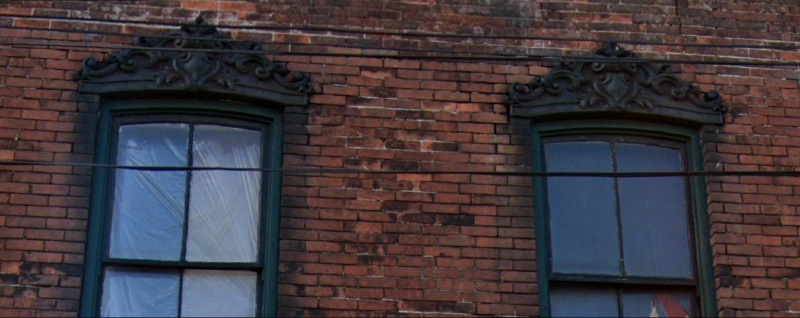
— 2019 Sep, Staten Island, NY, Google Maps. View largest available size.
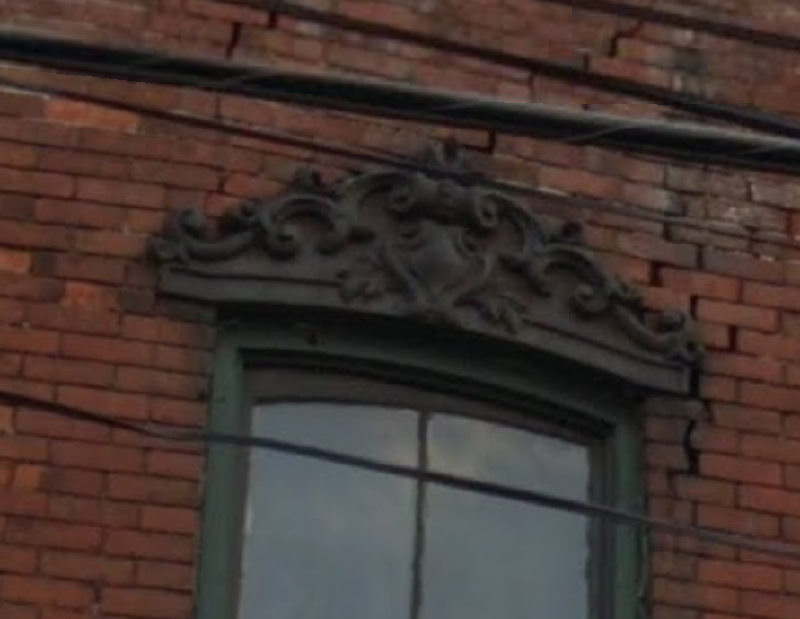
— 2017 Jul, Staten Island, NY, Google Maps. View largest available size.
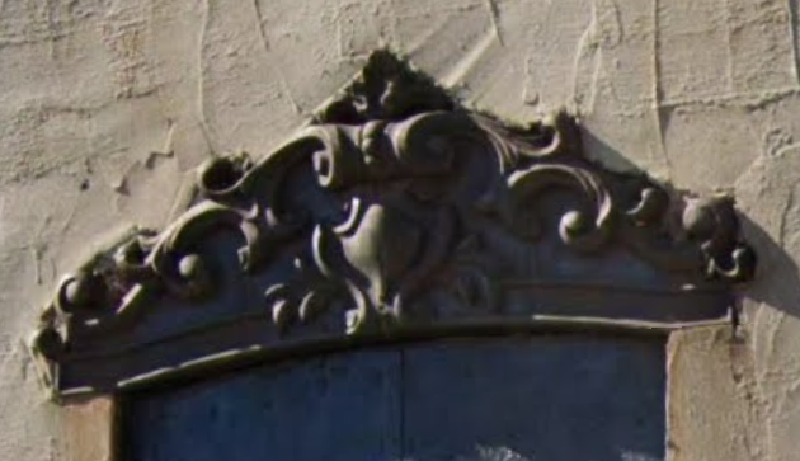
— 2022 Oct, Staten Island, NY, Google Maps. View largest available size.
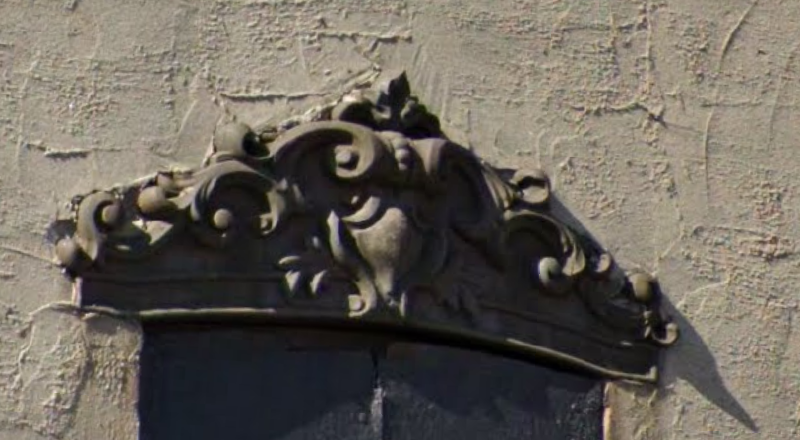
— 2022 Oct, Staten Island, NY, Google Maps. View largest available size.
Adam asked:
“The window cornices appear to all be present and in excellent condition. I assume then that these are of a more modern origin and not the original cornices?”
Matt replied:
“These lintels as they are called are also original. You will see these on buildings in the early manufacturing buildings in SOHO NYC. The cast iron frame for the front door bears the name of the same company that made them for most of those in NYC. I can’t recollect the name offhand but I believe it was an Elm Street address embossed on the base.”
— 06 Dec 2023, Matt Long, personal correspondence.
Note that these lintels are not present in the visible alley-way windows of Pine’s store shown in the Charles M. Steinrock photograph “Pine Residence” from Historic Richmond Town shown above. That photograph also shows the corner of a cornice on the top of the building that is not present in the 2000’s photographs of the building.
As recently as Oct 2021, the building was occupied, as Google Maps images of the second floor show an office with pictures hanging on the wall, and a computer monitor with brand name Dell against the window.
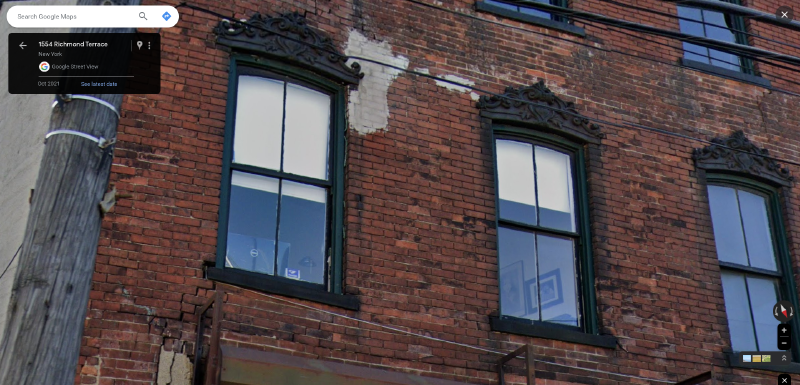
— 2021 Oct, Staten Island, NY, Google Maps. View largest available size.
For several decades up to that point, the building was occupied by Furniture Restoration Workshop.
Furniture Restoration Workshop (FRW) is saying goodbye to the Staten Island community. It will mark the end of this 48-year run that defines owners Matthew and Nina Long’s lives.
… Watching his father run his own home improvement business and spending his youth working carpentry, Long decided to start a furniture restoration business in a small warehouse/garage in West Brighton, aptly named “The Furniture Restoration Workshop.” As the business grew, he moved into 1550 Richmond Terrace in 1986. The work evolved into a successful business and took a turn towards commercial work with high profile companies such as; the Jewish Division Reading Room at the 42nd Street Library, Radio City, and the Federal Reserve Bank.
Over 48 years, Long has given hope to many that may have seemed unemployable in our community. He took in and trained people with criminal records, developmental disabilities, mental health issues, and countless people who would have fallen through the cracks that made a life under his care and employment.
— 01 Apr 2022, Jan Somma-Hannel, Staten Island furniture restoration business is liquidating after 48 years, silive.com.
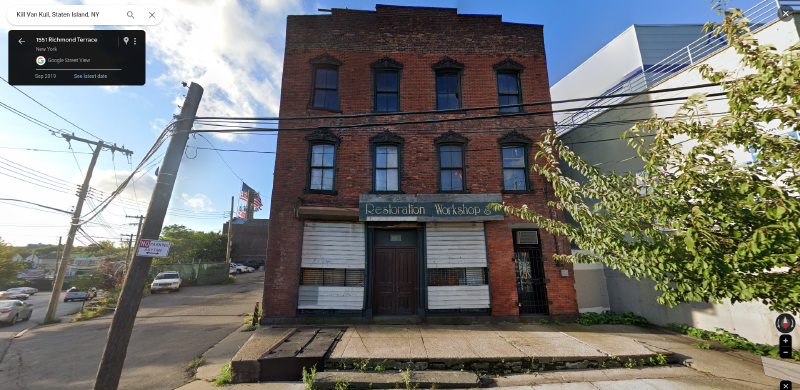
— 2019 Sep, Staten Island, NY, Google Maps. View largest available size.
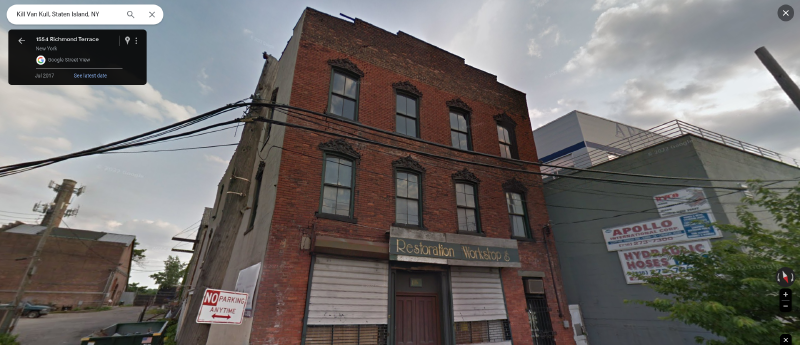
— 2017 Jul, Staten Island, NY, Google Maps. View largest available size.
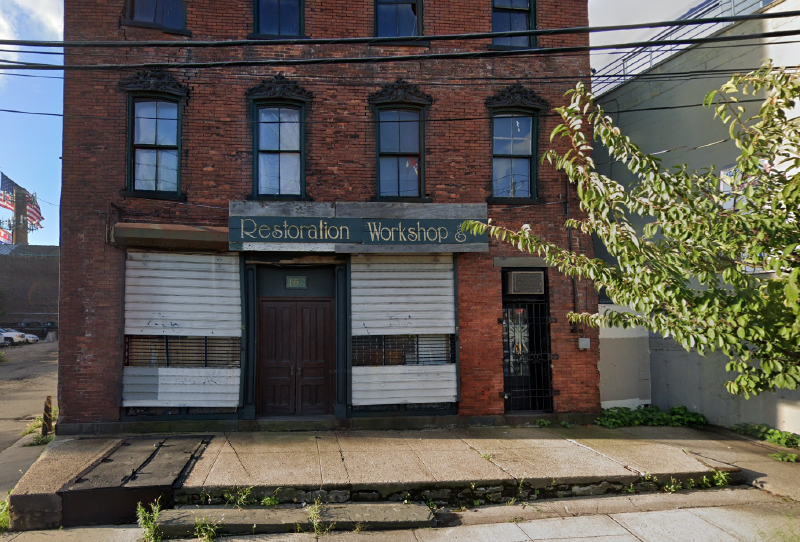
— 2019 Sep, Staten Island, NY, Google Maps. View largest available size.
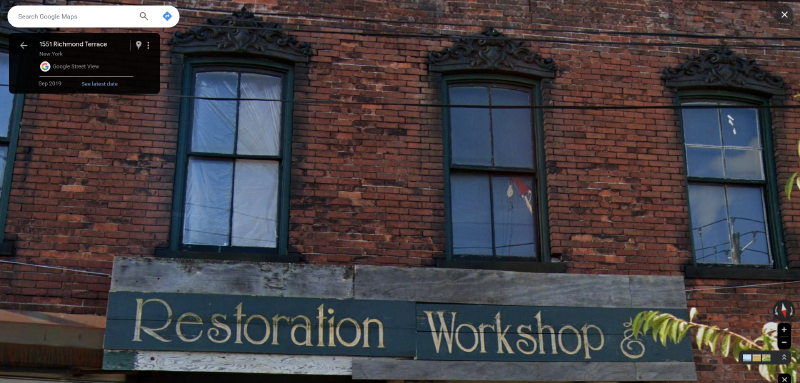
— 2019 Sep, Staten Island, NY, Google Maps. View largest available size.
Adam asked:
“To your knowledge, is there anything in the building, or about the building, that still provides evidence today of Charles Pine or his grocery store? (Or was there such evidence at any time during the period you occupied it?)”
Matt replied:
“There are (maybe were as I sold the building in March) some unusual hanger millwork with very heavy duty bolts extending out of them. I might have a photo or could make a sketch if you like. They looked to be used for moving heavier objects along the length of the store (my best guess) When I first moved in and cleared out the basement, there were many…what looked like present day clothes drying racks but much larger. Someone suggested they were used for drying pasta.”
— 06 Dec 2023, Matt Long, personal correspondence.
The address for Pine’s store was 188 Richmond Terrace, but is addressed today as 1550 Richmond Terrace. It is located on Staten Island block 186, lot 10 (Borough-Block-Lot Lookup, New York City Department of Finance).
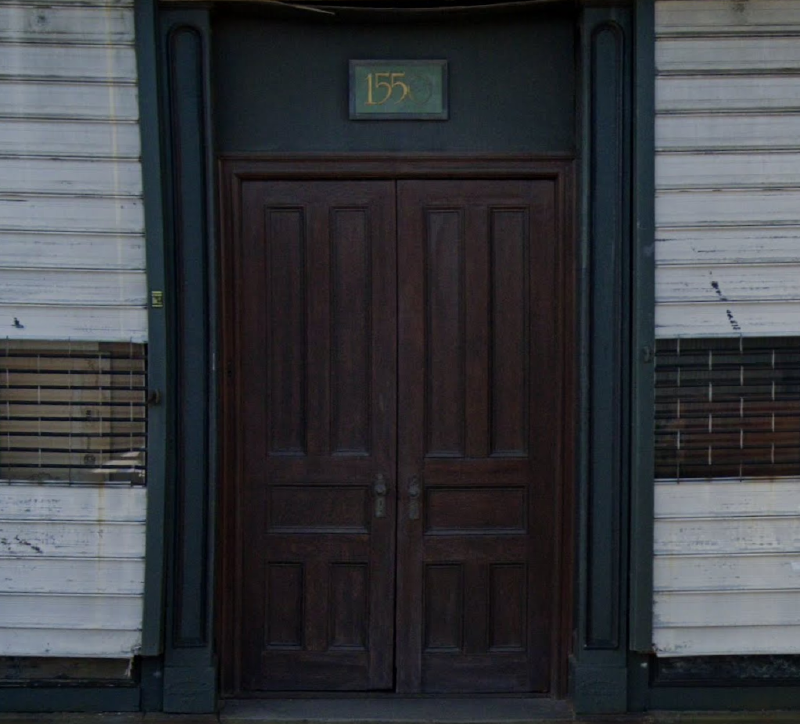
— 2019 Sep, Staten Island, NY, Google Maps. View largest available size.
I was quite proud to own that property. It’s a gem. Especially here on Staten Island. I have the advertisement (reprint of course) for CM Pine you probably found as well. I believe I also have images from the time when the building housed Victory Van Lines and Claire Brown’s Auction house. Of course I have images from the years I spent there (40+).
…The building holds many memories and so many stories of its own! It’s rewarding that for forty years I worked my woodworking trade in a building that has always been an object worthy of review!
— 06 Dec 2023, Matt Long, personal correspondence.
More on Bartlett Brown, Hawkins Ancestry and Descendants
The parents of Bartlett Brown (1833 to 24 Nov 1902) are Abraham “Abram” Brown (10 May 1802 to 10 Feb 1874) and Hannah Hawkins (04 Feb 1804 to 14 Aug 1879). A “Hawkins family” folder and a folder containing Hawkins genealogical data are archived in the The Mills Family of Jamaica and Mills Pond, Long Island, Archives at Queens Library, Queens Borough Public Library, Jamaica NY. I have yet to personally examine these.
The early Hawkins genealogy, like the Mills genealogy, is explored in Genealogies of Long Island Families:
This family has always been a very prolific one in Suffolk County, particularly in Brookhaven Town where the common ancestor Zachariah Hawkins settled. Members of the family can now be found in almost every town in Suffolk County. The early generations generally spelled the name “Hawkings” but all finally adopted the correct spelling.
Zachariah Hawkins1 an Englishman, was one of the original proprietors of Brookhaven Town, settling at Setauket in 1655. He was a large property owner and a prominent man in the settlement.
— 1919, Genealogies of Long Island families : a collection of genealogies relating to the following Long Island families: Dickerson, Mitchill, Wickham, Carman, Raynor, Rushmore, Satterly, Hawkins, Arthur Smith, Mills, Howard, Lush, Greene, Compiled by Charles J. Werner, Mainly From Records Left By Benjamin F. Thompson, Historian of Long Island, p85, Logan Utah FamilySearch Library, familysearch.org.
It was Robert Hawkins (1610 to 11 Sep 1704)–the father of Zachariah “Zachary” Hawkins (25 Oct 1639 to 1699) “the common ancestor” mentioned above—born in Plymouth, Devon, England, who immigrated to America in 1635, marrying Mary Marie Pease that same year in Charlestown, Suffolk, Massachusetts.
The most complete genealogical record of the ancestry of Bartlett Brown (1833 to 24 Nov 1902), that I have yet reviewed, is by Gerald Molloy (@jerrymolloy) on Geneanet.org, which I rely upon heavily below.
| generation | lineal ancestor | birth | death | spouse | birth | death |
|---|---|---|---|---|---|---|
| mother | Hannah Hawkins | 1804-02-09 | 1879-08-14 | Abram Brown | 1802-05-10 | 1874-02-10 |
| grandfather | David H. Hawkins | 1780-09-18 | 1850-01-07 | Prudence (Tuthill) Hawkins | 1874-03-30 | 1870-06-23 |
| Great-grandfather | Nathaniel Hawkins | 1752 | 1823-08-31 | Dina (Longbotham) Hawkins | ? | 1836-02-26 |
| Gg-grandfather | Zachariah Hawkins | 1710 | 1800 | Abigail (Jayne) Hawkins | 1714 | 1780 |
| Ggg-grandfather | Joseph Hawkins | 1677 | 1728-09-18 | Susan (?) Hawkins | ? | ? |
| Gggg-grandfather | Zachariah “Zachary” Hawkins | 1639-10-25 | 1699 | Mary (Biggs) Hawkins | 1643 | ? |
| Ggggg-grandfather | Robert Hawkins | 1610 | 1704-09-11 | Mary Marie (Pease) Hawkins | 1611-01-09 | 1642-04-11 |
I have often wondered if Bartlett Brown and Edward H. Mills were related, if even distantly. There are several instances of the descendants of Zackary Hawkins, and the descendants of Timothy Mills of Mills Pond intermarrying and both the Hawkins and Mills genealogies include multiple instances each of Hallock and Longbotham. I have only begun to explore all of the lines that could potentially intersect, and I don’t know when or even if I will ever complete that work, as answering this question isn’t my highest priority currently, and gaps in genealogical records may make it impossible to draw a definite conclusion. I suspect that it is unlikely the two men were related, even distantly, but again, this is just my impression after gaining some initial familiarity with the Mills, Hallock and Hawkins genealogies.
Bartlett Brown married Sarah Adelaide (Ward) Brown (1833 to 04 Sep 1916) on 13 Sep 1860. Bartlett and Sarah’s marriage as well as their children’s baptisms are all recorded by the Reformed Dutch Church of Port Richmond. Their children are:
Adele Irving Brown (09 Nov 1862 to 18 Jan 1927). It appears that Adele never married or had children, and census records indicate that she lived for many years with her younger brother Bartie’s family. Although some census records may suggest her middle initial was “J”, the middle name “Irving” is explicitly written in her baptism records in the Reformed Dutch Church of Port Richmond, as well as the 1910 United States Federal Census.
Charles Pine Brown (25 Jan 1866 to 22 Jan 1887), named for his father’s mentor and friend, Charles M. Pine. (This seems most likely, although perhaps he could also be named for Charles’ son Charles Theodore Pine, who was a witness to Bartlett’s will. But Theodore was in the same generation as Bartlett, and in fact, a few years younger, so it seems more logical that he named his son for his mentor in the grocery business.) Charles died of tuberculosis in West New Brighton just three days before his 21st birthday, and is purportedly buried in Moravian Cemetery. (1887, New York State Death Index, Certificate number 41287, New York Department of Health, Albany, NY, ancestry.com.) I find no evidence that Charles ever married or had children.
Bartlett “Bartie” Brown Jr. (04 Mar 1870 to 15 Dec 1946). Bartlett Sr. retired from the grocery business in 1892, and the 1900 census implies that Bartlett Jr. continued to run the store for some years after. By 1910, Bartlett Jr. is working in the railroad industry, and by 1920, he is “chief accountant” at a railroad company.
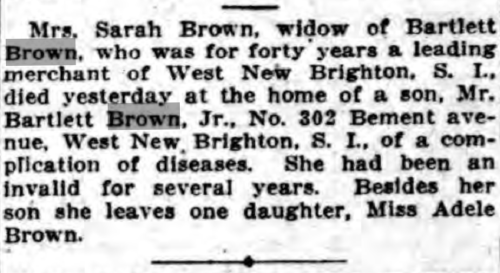
Mrs, Sarah Brown, widow of Bartlett Brown, who was for forty years a leading merchant of West New Brighton, S. I., died yesterday at the home of a son, Mr. Bartlett Brown, Jr., No. 302 Bement avenue, West New, Brighton, S. I., of a complication of diseases. She had been an invalid for several years. Besides her son she leaves one daughter, Miss Adele Brown.
— 05 Sep 1916, New York Herald, New York NY, p10, fultonhistory.com. View largest available size.
Bartlett Brown Jr. Married Elizabeth “Bessie” F. (?) Brown (1871 to 13 Nov 1946) and they lived for many years at 302 Bement Avenue in West New Brighton. Note that Bartie outlived Bessie by just a month. Their children:
Farrington Wade Brown (01 Dec 1894 to 27 Sep 1963) served in World War I, and graduated from Columbia University with a degree in architecture, which he made his career. His physical description, recorded on his military recruitment card, describes him as tall and slender, with brown hair and brown eyes. Farrington married Mabel Cornell Barton on 21 Jan 1926 in Manhattan, and they had a son, Barton Brown, born Jun 1935.
Amy Bartlett Brown (? to ?).

Announcement has been made by Mr. and Mrs. Hanford P. Barton, of No. 231 West 104th street of the engagement of their daughter, Miss Mabel Cornell Barton, to Mr. Farrington Bartlett Brown, son of Mr. and Mrs. Bartlett Brown, of Staten Island. Mr. Brown was graduated from Columbia in 1918, and during the war served overseas in the sub-chaser division of the United States Navy.
— 26 Jun 1923, The Evening Telegram, New York NY, p8, fultonhistory.com. View largest available size.
Churches in Staten Island
The families of Edward Mills, Charles Pine (including his siblings and their descendants, such as Livingston Snedeker) and Bartlett Brown, along with several Hillyers, including Abraham Crocheron Hillyer (25 Dec 1842 to 14 Oct 1932) of Hillyer & Hartley, and Alice E. (Hillyer) Egbert (1841 to 1915), are all members of the Reformed Dutch Church of Port Richmond. Alice is James Hillyer’s sister, and she married his business partner, Barnett Egbert—sometimes spelled “Barnet”–also a member of the Church. (Barnett Egbert’s father Barnett Egbert Sr. was a Church elder.) Other familiar family names associated with the church include the Bedell’s and Mersereau’s.
The Crocheron family have been prominent in the county ; Henry was Member of Congress 1815—'17. Jacob was Member of Congress 1829—'31 ; Presidential elector in 1836; Sheriff 1802, 1811 and 1821. Nicholas was Member of Assembly, 1854. Richard was County Treasurer, and Surrogate, 1836, and for several years thereafter. The family is of French descent.
In the Records of the Reformed Protestant Dutch Church on Staten Island, there are the following entries for members with the family name of Mills, that as far as I can tell, are unrelated to Edward Mills:
- 02 Mar 1850, Jacob H. Van Pelt marries Melinda Mills in Staten Island.
- 08 July 1864, John B. Martling marries Helen Louisa Mills.
The Vanderbilt family is the most famous of the Reformed Church’s past congregants.
The old brick church, having proved inadequate to the necessities of the congregation, the present church edifice was built upon the site of the former one, and dedicated in February, 1846.
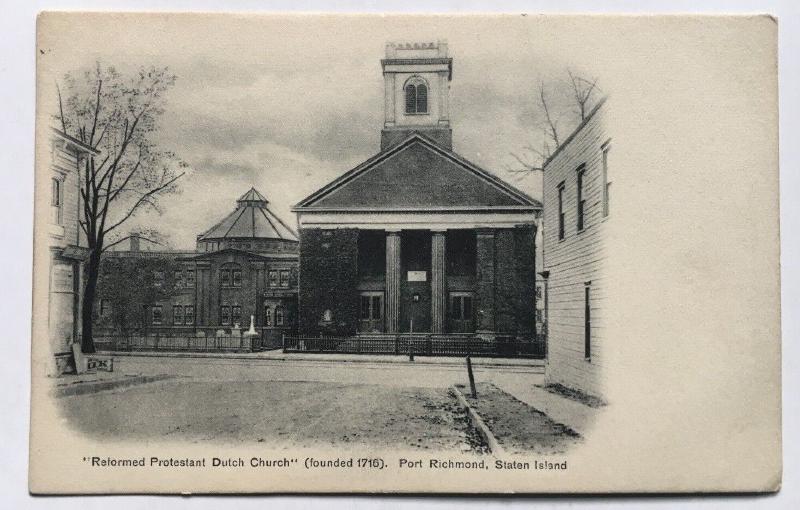
“Reformed Protestant Dutch Church” (founded 1716). Port Richmond, Staten Island
— Postcard in the personal collection of Adam Smith. View largest available size.
The young nation and our Old Dutch Church went through a number of profound changes.
In the middle of the 19th century, immigrants from Ireland and Germany came to Port RIchmond for jobs in Industries such as whale oil processing, succeeded by linseed oil processing (which operated until the 20th century); lumber and coal yards; dye processing; and oyster harvesting along the mudflats in New York Harbor. Many successful oyster boat captains built mansions on Richmond Terrace facing the Kill van Kull in the 1840s and 1850s.
The present church was built in 1844. The name was changed from Reformed Protestant Dutch Church to the Reformed Church on Staten Island.
Rev. Brownlee was Northfield Township Schools Commissioner. In 1866, when the neighborhood was incorporated, the name Port Richmond was coined by Brownlee to pay tribute to its maritime tradition.
KILL VAN KULL—ARTHUR KULL.The precise meaning of the Dutch word “Cull,” we are unable to give, though it probably had some reference to the water, as Newark Bay was emphatically called “the Cull,” and was universally known by that name. The Dutch word “Kill” meant a small stream or passage of water; therefore, the name Kill Van Kull means the stream or passage from the Cull, or Kull, as it is now spelled. Arthur Kull, or Kill, as it is now sometimes written, is a corruption of the Dutch word “achter,” after, or behind; therefore, Achter Kull meant behind or beyond the Cull. An attempt has recently been made to change the orthography of the word Van, by substituting the letter O for A, thus, Von, which is neither Dutch nor English, and arises from ignorance of the fact that the Dutch A in this connection has the sound of the English O in the same connection; therefore, to spell the word correctly, it should be written Van, and pronounced Von. We give the above as the explanation of the origin of the Dutch names of these waters.
Some facts listed on the Church’s website:
- Oldest corporation on Staten Island
- Congregation continuous since 1656
- They have been on the same spot in Port Richmond since 1680.
- The town grew up around the Church, not the other way around.
- Their Archives date to 1688.
- Their Burial Place and Baptismal Records date to 1696.
- Their Congregants paid pivotal roles in American history.
- Their Burial Place has 45 heroes of the wars that created America:
- The American Revolution, The War of 1812, and The Civil War.
- One of them created our modern business world.
- They are a National Historic Site nominee.
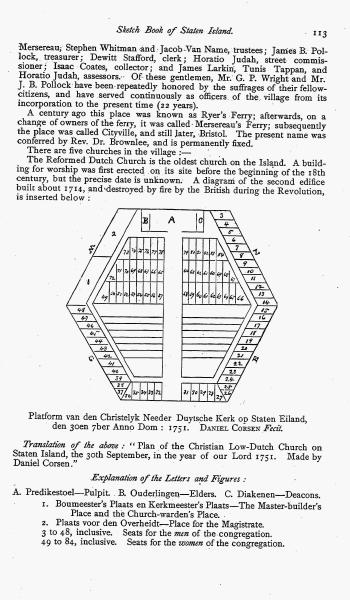
A century ago this place [Port Richmond] was known as Ryer’s Ferry; afterwards, on a change of owners of the ferry, it was called Mersereau’s Ferry; subsequently the place was called Cityville, and still later, Bristol. The present name was conferred by Rev. Dr. Brownlee, and is permanently fixed.
There are five churches in the village:—
The Reformed Dutch Church is the oldest church on the Island. A building for worship was first erected on its site before the beginning of the 18th century, but the precise date is unknown. A diagram of the second edifice built about 1714, and destroyed by fire by the British during the Revolution, is inserted below :
[Illustration, the caption for which follows.]
Platform van den Christelyk Needer Duytsche Kerk op Staten Eiland, den 30en 7ber Anno Dom: 1751. Dante Corsen Fecit.
Transiation of the above: “Plan of the Christian Low-Dutch Church on Staten Island, the 30th September, in the year of our Lord 1751. Made by Daniel Corsen.”
Explanation of the Letters and Figures:
A. Predikestoel—Pulpit. B. Ouderlingen—Elders. C. Diakenen—Deacons. 1. Boumeester’s Plaats en Kerkmeester’s Plaats—The Master-builder’s Place and the Church-warden’s Place. 2. Plaats voor den Overheidt—Place for the Magistrate. 3 to 48, inclusive. Seats for the men of the congregation. 49 to 84, inclusive. Seats for the women of the congregation.
— 1886, Illustrated sketch book of Staten Island, New York : its industries and commerce.. New York: S.C. Judson, p113, ancestry.com. Partial transcription.View largest available size.
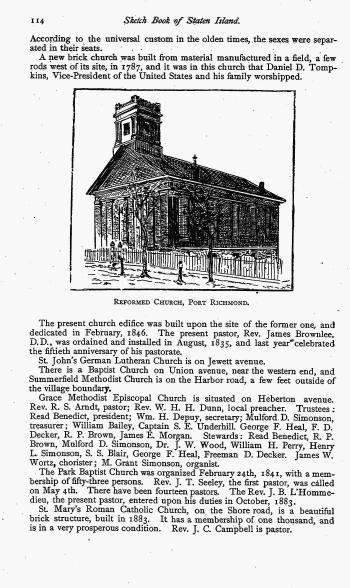
According to the universal custom in the olden times, the sexes were separated in their seats.
A new brick church was built from material manufactured in a field, a few rods west of its site, in 1787, and it was in this church that Daniel D. Tompkins, Vice-President of the United States and his family worshipped.
[Illustration with caption: Reformed Church, Port Richmond.]
The present church edifice was built upon the site of the former one, and dedicated in February, 1846. The present pastor, Rev. James Brownlee, D.D., was ordained and installed in August, 1835, and last year celebrated the fiftieth anniversary of his pastorate.
— 1886, Illustrated sketch book of Staten Island, New York : its industries and commerce.. New York: S.C. Judson, p114, ancestry.com. Partial transcription.View largest available size.
Finally, here is some basic information on the Presbyterian churches on Staten Island. Although Calvary Church was organized well after the Mills had left Staten Island, it is interesting to note that it was originally comprised of many members of the Reformed Dutch Church. The Methodist Episcopal Church was attended by Mary Ann’s sister and James A. Hillyer.
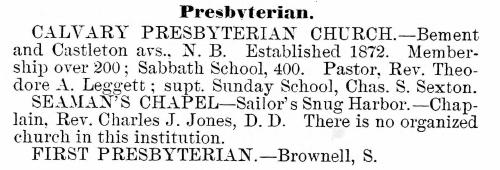
Presbyterian.
CALVARY PRESBYTERIAN CHURCH.—Bement and Castleton avs., N. B. Established 1872. Membership over 200; Sabbath School, 400. Pastor, Rev. Theodore A. Leggett ; supt. Sunday School, Chas. S. Sexton.
SEAMAN’S CHAPEL—Sailor’s Snug Harbor.—Chaplain, Rev. Charles J. Jones, D.D. There is no organized church in this institution.
FIRST PRESBYTERIAN.—Brownell, S.
— 1886 Webb’s Consolidated Directory of the North and South Shores Staten Island, p351, ancestry.com. View largest available size.
The following table is from Presbyterian churches and their founding on nygenweb.net and cites “WPA’s Inventory of the Church Archive in New York City — Presbyterian Church in the United States of America. (Historical Records Survey), 1940 as found at nycnuts.net.”
| Year | Name | Location |
|---|---|---|
| 1727 | English of Staten Island | Stony Brook; to about 1776 |
| 1856 | First of Staten Island; originally First of Clifton, Staten Island then First of Edgewater | Stapleton |
| 1872 | Calvary of Staten Island | West New Brighton |
| 1887 | First of New Brighton | New Brighton |
| 1911 | Calvary Chapel | West New Brighton |
| 1925 | Rosebank Mission also Our Savior | Rosebank |
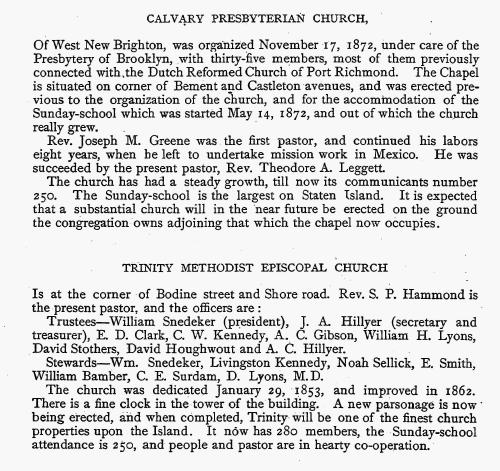
CALVARY PRESBYTERIAN CHURCH,
Of West New Brighton, was organized November 17, 1872, under care of the Presbytery of Brooklyn, with thirty-five members, most of them previously connected with the Dutch Reformed Church of Port Richmond. The Chapel is situated on corner of Bement and Castleton avenues, and was erected previous to the organization of the church, and for the accommodation of the Sunday-school which was started May 14, 1872, and out of which the church really grew.
Rev. Joseph M. Greene was the first pastor, and continued his labors eight years, when he left to undertake mission work in Mexico. He was succeeded by the present pastor, Rev. Theadore A. Leggett.
The church has had a steady growth, till now its communicants number 250. The Sunday-school is the largest on Staten Island. It is expected that a substantial church will in the near future be erected on the ground the congregation owns adjoining that which the chapel now occupies.
TRINITY METHODIST EPISCOPAL CHURCH
Is at the corner of Bodine street and Shore road. Rev. S. P. Hammond is the present pastor, and the officers are:
Trustees—William Snedeker (president), J. A. Hillyer (secretary and treasurer), E. D. Clark, C. W. Kennedy, A. C. Gibson, William H. Lyons, David Stothers, David Houghwout and A. C. Hillyer.
Stewards—Wm. Snedeker, Livingston Kennedy, Noah Sellick, E, Smith, William Bamber, C. E. Surdam, D. Lyons, M.D.
The church was dedicated January 29, 1853, and improved in 1862. There is a fine clock in the tower of the building. A new parsonage is now being erected, and when completed, Trinity will be one of the finest church properties upon the Island. It now has 280 members, the Sunday-school attendance is 250, and people and pastor are in hearty co-operation.
— 1886, Illustrated sketch book of Staten Island, New York : its industries and commerce.. New York: S.C. Judson, p72. ancestry.com. Emphasis added.View largest available size.
I have looked through transcriptions of the Reformed Church’s graveyard and could not find an entry for James Wheelock Mills. Kathleen Langdon from the Reformed Dutch Church performed an independent search and also could not find him. Finally, I have also examined the First of Staten Island/Stapleton records on Ancestry.com, and I did not find him there.